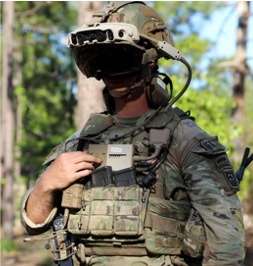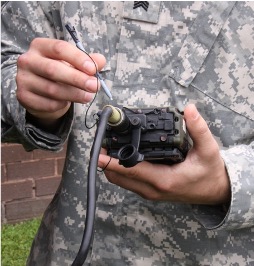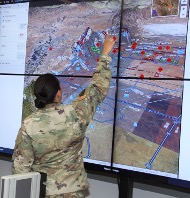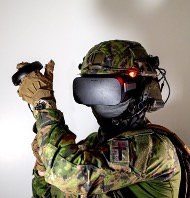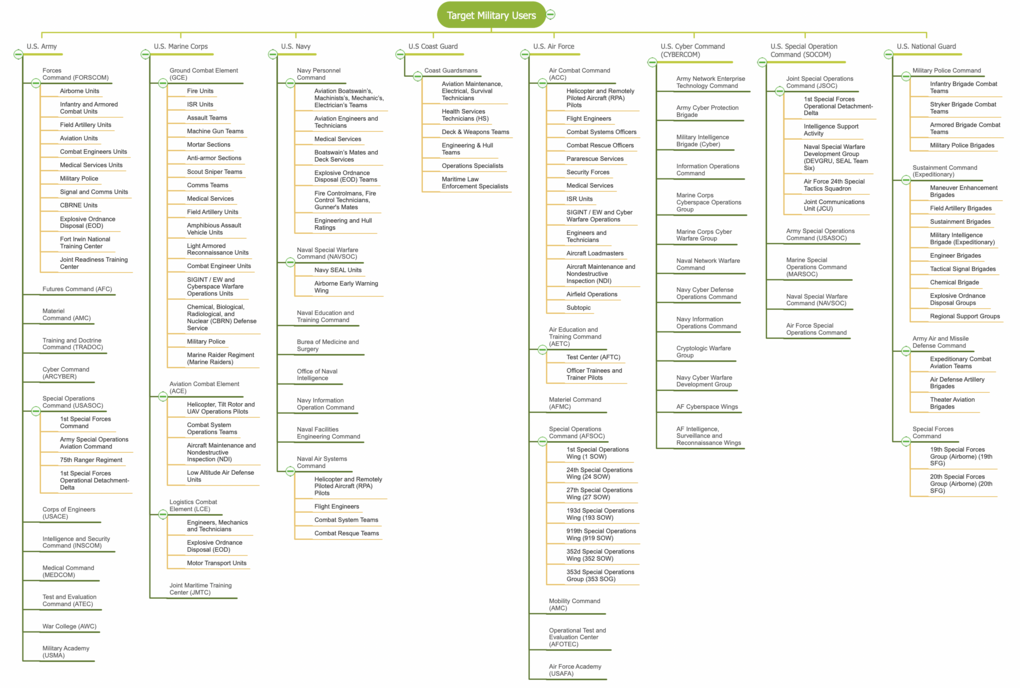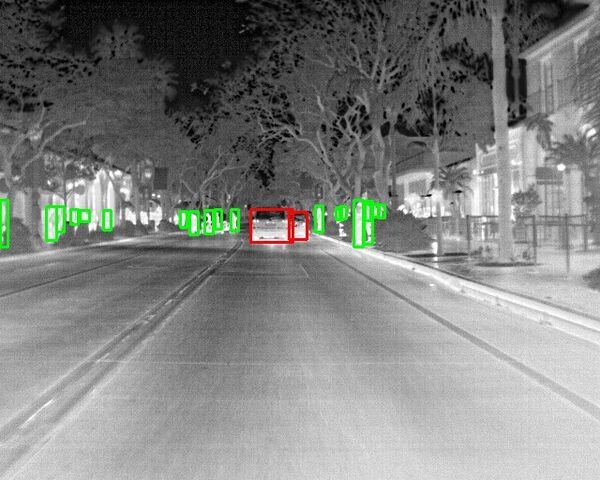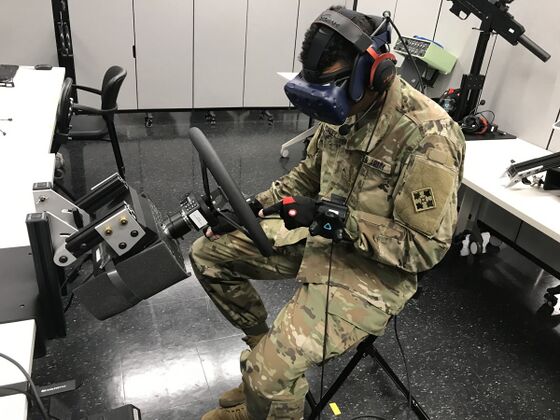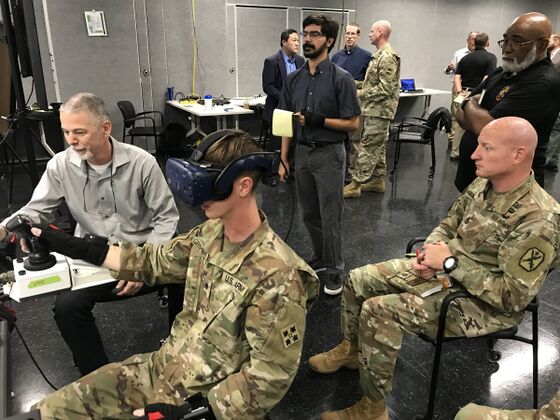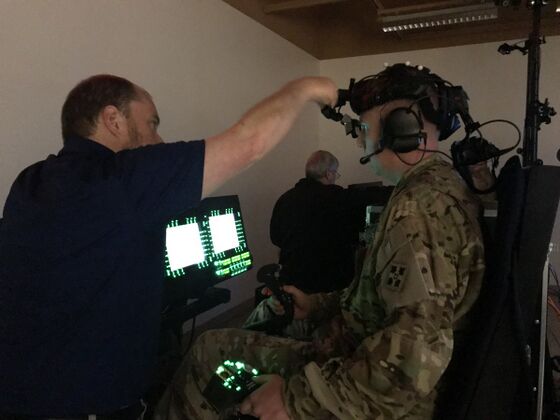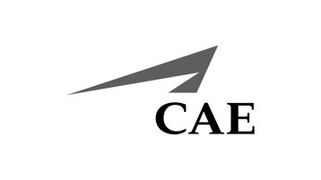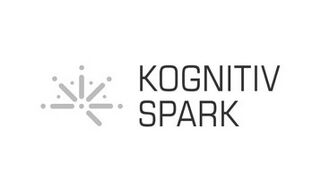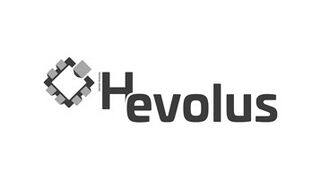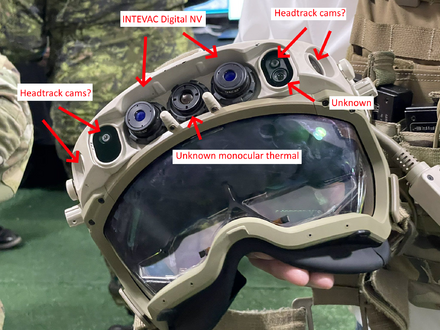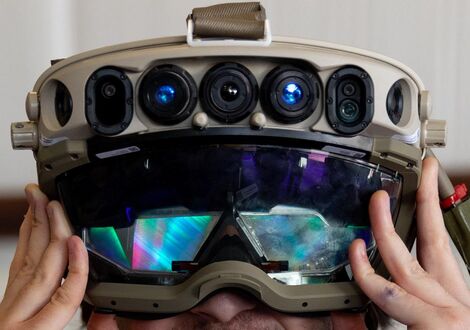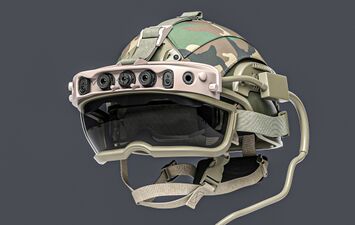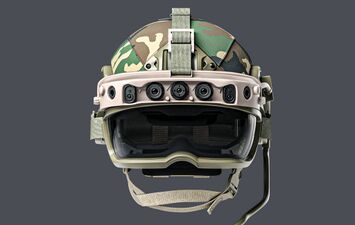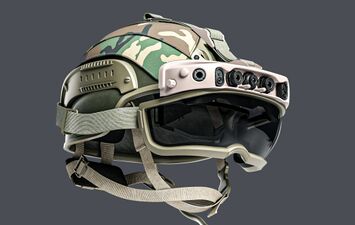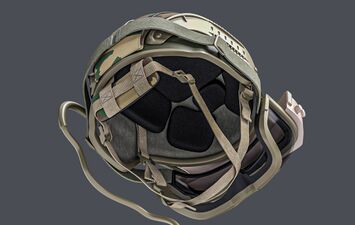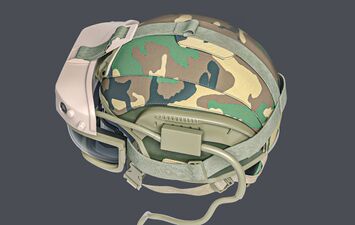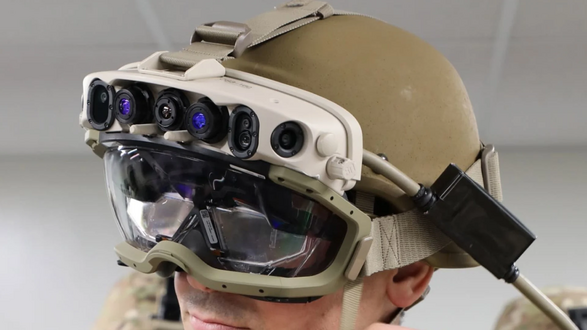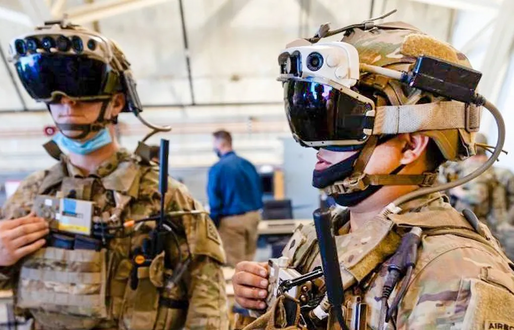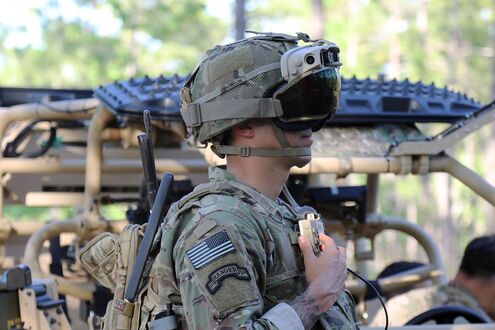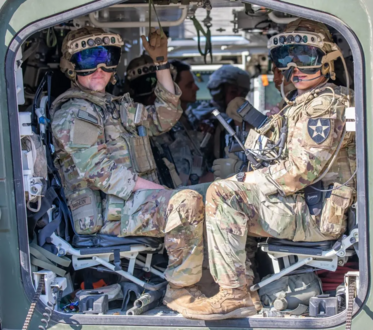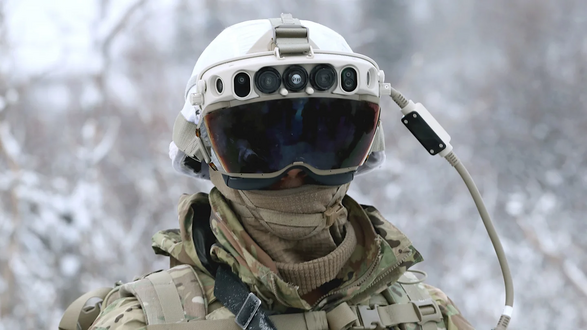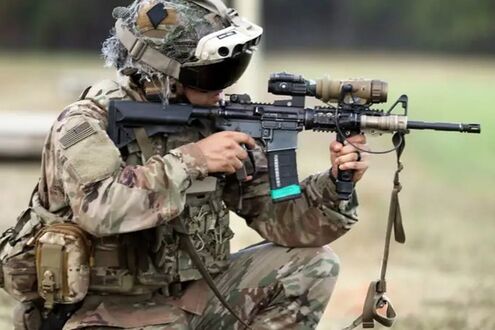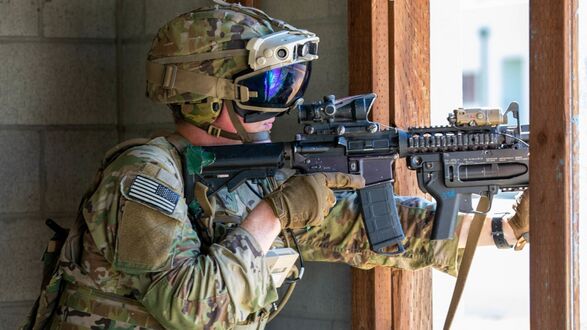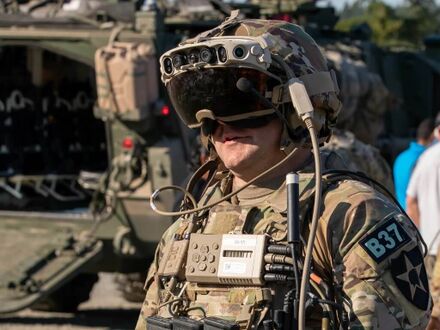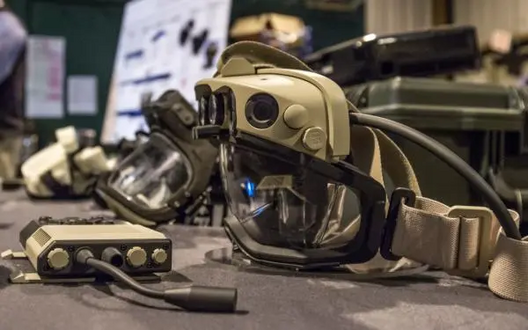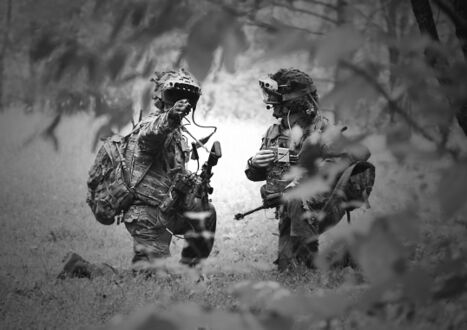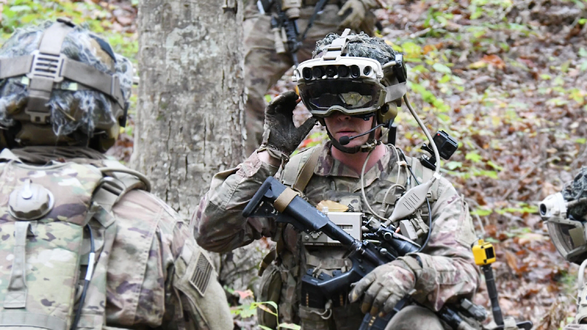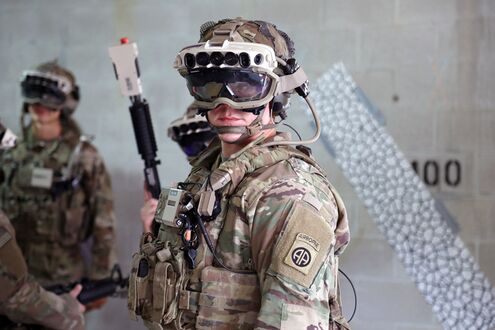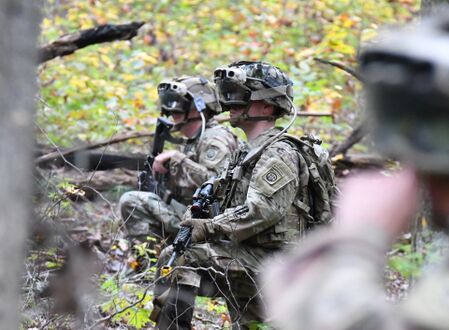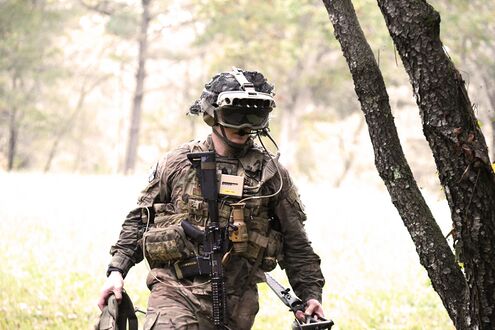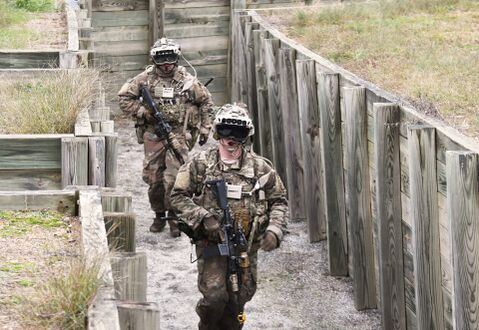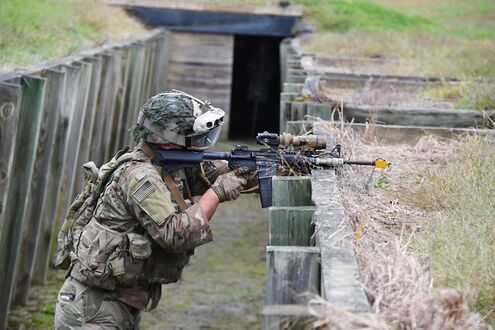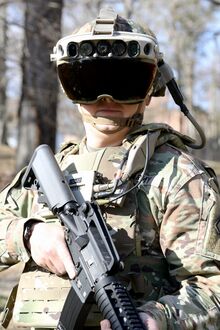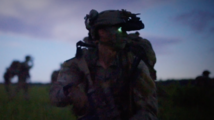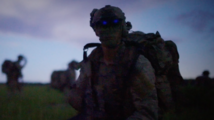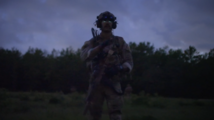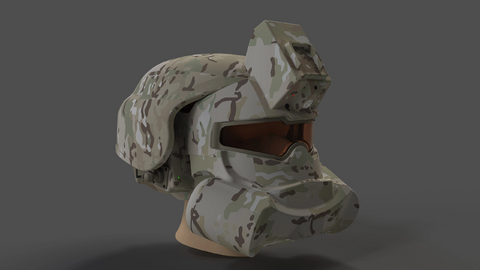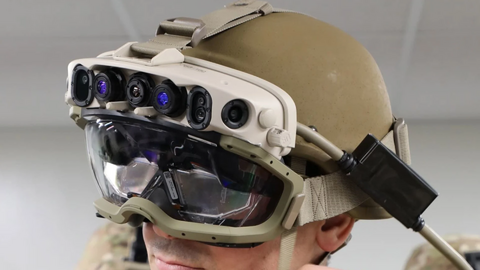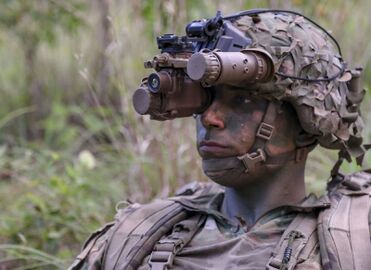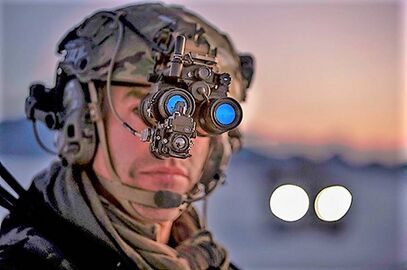Public:ARHUDFM FAQ

Furtherium UG / Furtherium Inc.
Frequently Asked Questions
Description of the most frequent questions and answers regarding the Startup, founders, the problems, the solutions, the market, competitors, available technologies, business models, development and growth stages, risk assessment, financial models, unit economics and strategy for the project ARHUDFM: Augmented Reality Head-Up Display Fullface Mask
Revised on July 31, 2023
Notes:
- All questions related to description of the application, features, and main characteristics of the upcoming electronic device ARHUDFM: Augmented Reality Head-Up Display Fullface Mask can be found in the public ARHUDFM Features Summary of our Wiki at https://wiki.furtherium.com
- This is the printed version of the electronic document located at https://wiki.furtherium.com/wiki/Public:ARHUDFM_FAQ
Please contact Basil Boluk at basil.boluk@furtherium.com if you have any questions or comments.
Furtherium on Vulcan Defense Innovation Technology Scouting Platform, sponsored by USSOCOM, fully networked solution on GovCloud(US).
DUNS: 030938614
CAGE: 9AMZ2
Abstract
![]() →redirect Further information: Public:ARHUDFM Manifesto, Public:Applications, Public:ARHUDFM Features Summary, Public:DoD_Pains, Public:Graphical User Interface
→redirect Further information: Public:ARHUDFM Manifesto, Public:Applications, Public:ARHUDFM Features Summary, Public:DoD_Pains, Public:Graphical User Interface
Problem
Deficiencies of the human systems used in the U.S. and German armed forces and in NATO: a distributed communication between units and between all warfighters, orientation and navigation considering fast dynamic environmental factors, the effect on concentration when performing multiple simultaneous actions, disadvantages of portable wearable devices, a lack of important additional electronic functions, a high cost of modern equipment.
Actual transformation areas and new capabilitites:
- Situational Awareness (SA)
- Communication (Comms)
- Navigation (Nav)
- Intelligence, Surveillance, Reconnaissance (ISR)
- Firing Assistance (FA)
- Task Management Tools (TM)
- Respiratory and Facial Protection
- Safety and Protection of User Health
- Vitals Body Sensors and First Aid
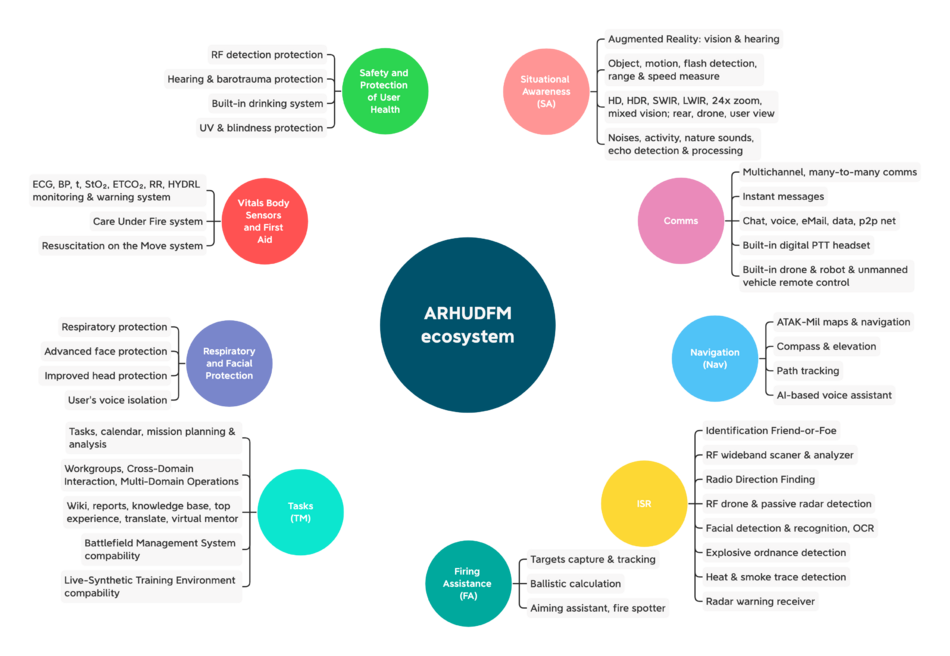
Several problems and strategic capabilities at once.
1. Distributed communication between units and between all soldiers:

- Quality of communication
- Voice communication with the enemy at a distance
- Encryption
- Simultaneous communication through multiple channels
- Accuracy of information and communication
- Duration of communication sessions
As a rule, the commanders of the units have digital remote communication devices with encryption algorithms, 2-channel or 4-channel wideband, data transmission at fixed and hopping frequencies. However, most of those involved have simpler radios that are jammed by electronic warfare or suffer interference in terrain with terrain elevation changes. In addition, if the unit is performing tasks in small groups, it lacks communications with other command centers, much less other domains. Voice information is exchanged through nodes, which slows down communication considerably. An important point is certainly the fact that voice communication between NATO units from different countries encounters language barriers.
The solution is a software-defined radio (SDR2) embedded in an augmented reality mask that operates flexibly on an extended frequency bandwidth with multiple waveforms and modulations, directional antenna and with less transmit power. The result is less interference with others and communication errors, more workarounds for radio jamming, and increased transmission range. Multi-channel one-to-many communication shortens the duration of sessions and the speed of data exchange, especially for short text and character messages, graphics, and GPS position exchange. This improves communication and coordination many times over.
Loud communication with the enemy or the population by each fighter avoids misunderstandings.
2. Orientation and navigation considering fast dynamic environmental factors:
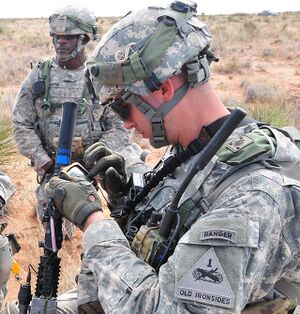
- Friend-or-foe system (warfighters, vehicles, drones, robots)
- Speed of map reading and positioning
- Exchange of positions within the same unit and especially during inter-domain interaction
- Capture of enemy fire positions and missile launch positions, approach to distant objects, and object recognition
The friend-or-foe system is still a prospective system for all Alliance countries and is not yet widely used. It is not effective without the use of augmented reality technologies. Another problem is the need for rapid target acquisition in the field and real-time navigation with the ability to see the positions of friendly units and vehicles, as well as captured fire positions and enemy movements, detect heat and smoke trails, and distinguish
between civilians. This requires receiving data from the drone and from other friendly units.
The navigation grid should show not only the landscape but also the distance and movement path of friendly and enemy positions, their numbers, and identification codes for communication. The optical ability to zoom in on distant objects, object recognition using computer vision and identification with satellite imagery or electronic maps and day and night thermographic vision combined with optical and infrared spectral vision must be available at all times.
It is important that soldiers are not distracted by these tasks and do not lose sight of their surroundings while using other equipment (navigation device, tablet PC, map, binoculars, rangefinder, thermal imaging camera, radio, and night vision device). All devices should be integrated and not interfere with observation.
3. The effect on concentration when performing multiple simultaneous actions:
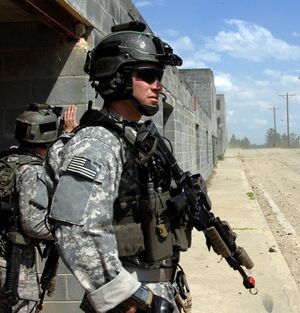
- Observation, detection, and approval
- Execution of the combat task
- Delegating the task to another
- Ballistic measurement and target setting
- Reporting the execution of the task
- Monitoring the execution of the task by others
- Screen view, text input
It is rare for a human to be able to provide two or more thought processes at the same time. For this reason, Air Force pilots have long used the head-up display to show important navigation parameters and target data. Progress and new possibilities overwhelm a person's cognitive abilities. In every domain, including sea and land, the military first conducts surveillance. Immediately upon detection, they must decide if data needs to be shared or if the electronic system needs to take care of it by providing updates to others. If the information is important, confirmation of data sharing should be obtained and possibly coordinated with others.
Whether a combat task must be delegated to or by others, or the decision has been made to perform it oneself, a very simple, clear, and immediate protocol for coordination is required. And an equally simple and concise confirmation of the established outcome. One solution is the use of voice control, auto-tracking, and data exchange via radio communication with symbols, graphics, and written codes.
Another important task that overtaxes a person's cognitive abilities is calculating ballistic parameters and aiming. It does not matter whether the weapon is a handgun, a rifle, a machine gun, a mortar or an artillery piece. The computer calculates 7 to 12 parameters in milliseconds, often with pre-positioning and corrections, saving time and ammunition.
4. Disadvantages of portable devices:
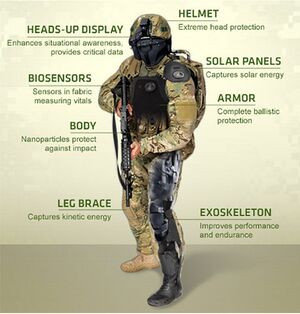
- Dimensions and weight
- Lack of comfort during prolonged wear (pressure on head and face, fogging of goggles and visor, insufficient ventilation of head and face, battery charge)
- Wired communication between devices on the head, back, waist, and chest
- Visibility to the enemy when using glow screens at night
- Lack of integration of the different systems - respirator, face shield, night vision, drinking system, voice communication - into each other
Several different electronic devices must be combined into one, and in doing so, weight and dimensions must be reduced, and freedom of movement must not be restricted. Cables that disturb and endanger the soldier must be inside the devices. High-strength materials and component resistance to water, dust, heat, cold, shock, and vibration should enable the performance of all combat missions. When wearing the device for extended periods, the comfort of the wearer must be ensured. This includes easy breathing through the mask for more than 24 hours, sufficient ventilation of the head and face, and pressure on the soft tissues of the head that does not affect the blood supply. The visor must be protected against fogging. The operating time with a single battery must be more than 24 hours. A drinking system must be built into the mask. The mask must have a ballistic helmet suspension system that can be easily attached and removed with one hand.
The soldier must not be visible at night because of the glowing screen. During the day, the visor must not dazzle in the sun. An important technical solution for the modern soldier's equipment is also the integration of respiratory protection, face protection, visual protection, an integrated drinking system, night vision, and all kinds of communication. In this way, it is equipped for combat operations in different environments and under different threats for long periods of time.
5. Lack of important additional electronic functions:
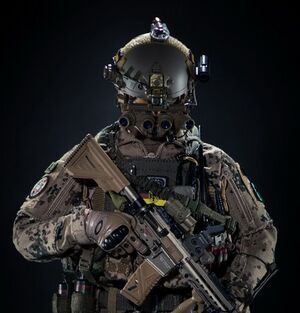
- Written encrypted communication
- Silent voice communication (acoustic voice isolation)
- Real-time transmission and viewing of images from the drone or robot on each participant's screen
- Transmission and viewing of images from external devices outside the body contour
6. High cost of modern equipment:
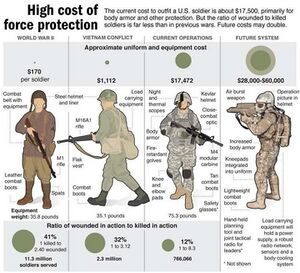
- Night vision binoculars and night vision sight
- Thermographic sight
- Optical binoculars and rangefinders
- Handheld portable radio
- Tactical headset
- Navigation device and compass
- Respiratory protection, face protection, and hearing protection
- Helmet and body protection
- Uniforms, footwear, equipment, ammunition
- Armament and first aid equipment
Key factors for Cross-Domain Interaction (CDI)
So the main factors for the CDI concept should be -
- A multiplication of communication through secure communication protocols, not through increased voice communication, but through the exchange of digital data about positions, events, tasks, and execution reports. Primarily written, symbolic, and graphical data that requires less traffic is more objective and understandable in a multilingual environment and is more easily processed by machines, including artificial intelligence (AI).
- The role of a tactical unit commander should not include the role of a communications center. They can focus more on unit coordination. Communication hubs are now machines.
- On the other hand, by following AGILE principles, each combatant, without having to expend additional forces, will not only be able to be a valuable source of data for all levels of command, but also, based on a broader range of processed objective information from other sources, including drones, satellites, and radars, presented in concise form, will be able to make more effective decisions independently without waiting for unnecessary approvals.
- The split between multichannel and machine processing will reduce channel congestion problems and increase the speed of exchanges and decision-making.
- In addition, the fighter's local cognitive superpowers, which are also processed by machines, will enable them to see, hear, and recognize what was previously inaccessible to most people at a lower level. This enables an immediate response both to themselves and to other participants in the same domain and in other domains.
The development of such Cross-Domain Solutions requires:
- Wearable individual helmets with head-up display, sensors, computing modules, SDR, and WLAN
- Adapted protocols for secure multi-channel communication
- New protocols for interaction and decision-making at all levels in various domains, including AI algorithms for big data analysis
- New training protocols for fighters, gunners, technicians, engineers, pilots, and commanders using virtualization technology
-
Wearable individual helmets
-
Adapted protocols for secure communication
-
New protocols for interaction
-
New training protocols
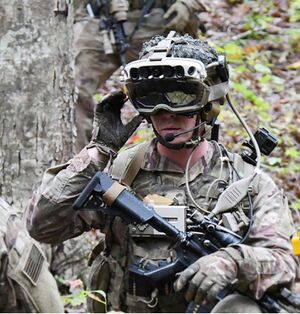
In addition, several strategic opportunities are also part of the problem. In the constant competition for superiority over a potential enemy, this is an important element of the problem assessment.
7. Visual communication:
- Exchange of digital position data for fast navigation
- Exchange of symbolic data for quick understanding
- Exchange of graphical information from drones and robots, a transmission of camera images to other units and participants
The location of positions and probable positions are success factors in tactical tasks. However, since the positions of friendly and enemy units can change unpredictably and very quickly, commanders do not always have complete and detailed information, especially for smaller units. It is important that each warrior in each squad group knows in advance what environment he will be in one hour. The most important thing is to be able to distinguish between friendly and enemy units before contact occurs. The concept of "friendly fire" should be abandoned. It is also important to support allied units that are suddenly ambushed and urgently need help from nearby units.
In order to report and receive the information for such navigation in real-time, it must be displayed exclusively in graphical form. It is even more convenient to have the navigation grid constantly in front of one's eyes without disturbing the overall view. The same applies to information collected not only by humans but also by drones. Part of the reconnaissance information must be processed in real-time and forwarded via common channels to
everyone within a certain radius.
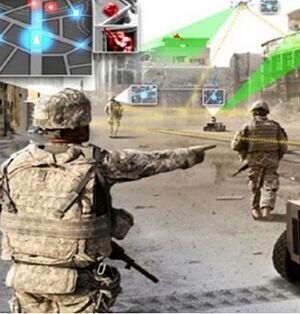
- Close airspace surveillance, hostile and friendly drones detection
- Enemy firing ranges
- Heat and smoke trails from missile trajectories with an estimation of launch positions
- Faces and objects from a distance
Modern computer vision systems are able to detect objects faster and better than humans by comparing them to previous images. Once an activity has been detected, the machines can analyze firearm flashes, aircraft trajectories, vehicle movements, and ballistic trajectories, as well as examine the heat and smoke trail of missiles in real-time and with high accuracy.
Neural networks can learn very quickly from a relevant data set. The more data, the more accurate the analysis. Progress with these technologies is measured in months, not years. As a rule, high image sharpness is not required for accurate recognition and the algorithms work efficiently even with images and videos of average quality.
Another area for recognition using computer vision is human faces. When patrolling and interacting with civilians, it is important to be able to recognize terrorists and enemy soldiers in civilian clothing. Emotion recognition capabilities are particularly noteworthy. Every human emotion has a wide range of gradations. Beyond that, however, it is usually important to evaluate the combination of emotions.
9. Noise filtering and detection for better orientation and observation
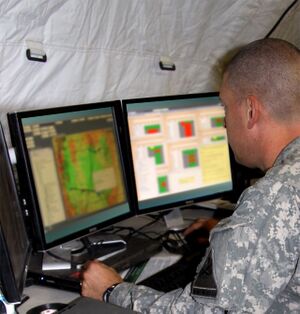
Human hearing is many times less informative than that of animals. At the same time, external microphones and bandpass filters have long been able to pick up and isolate individual sounds, even quiet ones. But this used to be the competence of sound engineers with good experience and developed hearing.
Neural networks are now quickly trained to recognize the right sounds and noises and transmit the results quickly. And it doesn't require much computing power. In practice, such super capabilities as part of a soldier's personal kit will enable even inexperienced personnel to perform reconnaissance tasks much more effectively.
9. Electronic management of tasks (automatic tracking, delegation, proof of completion)
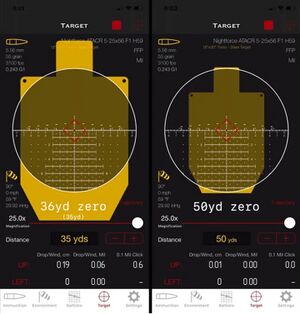
The next technology, which has long been used for civilian purposes, is auto-tracking. The system uses sensors to record the result itself and sends an automatic report on execution without requiring human intervention. This can be taking a position, suppressing enemy fire, leaving the firing zone, apprehending the enemy, recording patrol results, and many other tasks that will not require human intervention. Each soldier just needs to have a computer and turn it on.
10. Electronic ballistic calculation, aiming assistance and correction, instant exchange of enemy positions, and distributed target control
Ballistic calculations have been performed by specialists for decades. And for many sophisticated weapons, computer calculations have also been used for a long time. However, for soldiers not sitting in front of a fire control monitor, for small arms, including snipers, for machine gunners and grenade launchers, for mortar fire, ballistic calculation functions and aids in aiming as well as correction can be useful. Ballistic calculations often use more than 20 parameters, such as range, target location angle (sight line height), wind speed and direction, upward air flows, temperature, relative humidity, precipitation, altitude, barometric pressure, caliber, and type of ballistic projectile. In addition, there are a number of other factors that are rarely considered.
Since the calculation of distances over 400 meters is already a complex task, it is difficult to solve it simply in your head. It is common for professionals to be trained to use tables and correction tables. A computer algorithm makes it possible to use much more accurate results of numerical integration of a system of differential equations. Another task that can be done better with a high-tech assistant is aiming. When not shooting from a closed position, it is much easier for a person to use a digital laser pointer sight integrated into an augmented reality helmet. The shooter aims the laser's crosshairs at the target and, taking corrections into account, immediately sees the likely point of impact.
Business Model
We will work on the basis of two models: Sales and SaaS for application functional modules. Due to the fact that various agencies and military-technical corporations have shown interest in our product, we are planning direct sales in collaboration with them, less likely through direct tenders.
This is a B2B and B2G area. This metric can be double-edged here. If you estimate the cost of a pilot program, CAC could be $120K-160K.
Still, I think there should be more focus on LTV (lifetime value of customer). I assume LTV of customer averages over $400M.
The project is currently at the prototyping stage.
Competition
Neither now nor in the future are we afraid of competition. First, competitors help us to keep a good tone and pace in the work of product development and customer support. Secondly, no competitor is capable of taking a dominant position in this market. Thirdly, none of the experts have any doubts about the great growth potential of the market for years to come.
Currently I would mention the following: Microsoft, L3Harris Technologies, C5ISR CCDC (DEVCOM), DARPA, Red 6 & Lockheed Martin, Elbit Systems, BAE Systems, Airbus Defense, Smart Shooter, Magic Leap. However, all except Microsoft are either developing an irrelevant product or there has been no confirmation for at least 4 years. We have been researching competitor information regularly for over 2 years.
I see more potential in smaller teams than in the giants. The list of reasons is very long. The main ones are the ability to dive deep into problems and come up with a solution that fits the problems perfectly. If you don't try to invent from the beginning, and adapt a completely different product that hasn't taken off in the B2C market, that's not a good strategy.
It will be a slower path. This is the example Microsoft shows. They are already in their third year of spending the money received under the DoD contract, and news about the IVAS program appears less and less frequently, mostly negative. If you analyze other sectors of the defense technology market, in most cases the new contracts go to medium and even small companies, not to large companies. Big business then seeks to acquire these companies in order to maintain its market share.
Now we can only talk about the future. Because neither we nor our competitors have ready-made products for relevant competitive comparison.
Critical functions
- Active device cooling even at high air temperatures
- Battery life over 72 hours
- No external wiring and modules
- Variable transparency of the central part of the visor
- Built-in respiratory and facial protection from gases, aerosols, dust, bacteria and viruses
- Built-in hands-free drinking system
- Voice and hand tracking control
- Joystick control and virtual keyboard
- Oxygen level, heart rate, body temperature, hydration level sensors (vital body sensors)
- Built-in VHF / UHF band radio
- Built-in SDR (Software Defined Radio) for digital encrypted one-to-many communication
- Written, symbolic and graphical communications for fast and accurate exchange
- Friend-or-foe identification
- Automatic capture, tracking and transmission of enemy positions, incl. out-of-sight (RDF), to other users and HQs
- Auto-tracking of own positions and execution of tasks
- Digital zoom and measurement
- Night vision (passive only terrain perception, with no IR source visible to others)
- Drone and external cameras view
- Digital aiming system integration
- Rear view
- Ballistic calculations and target hit tracking and corrections
User friendliness
- Active head (under-helmet) ventilation, an extremely valuable feature in a heat of a outfit while on a move, when sweat pours into eyes
- Low breathing resistance of respiratory protection for comfort during prolonged use and high physical exertion
- Acoustic isolation of user speech
- Reduced visibility in the infrared spectrum thermal imaging cameras
- Low pressure on soft tissues of face and head
- External loudspeaker is needed for comfortable voice messaging to people without the device over longer distances or in high noise environments
- Built-in bright light source with adjustable brightness to illuminate the space and work area in front of the user
- Convenient written task system, automatic task control and checklists
- Comfortable system of symbolic communications (analogue of road signs), coupled with an AI system
- Real-time access to library and reference materials
- Accurate shooting with both eyes open
Expanded functionality
- Connectivity with C4I, STE One World Terrain (OWT), ATAK-MIL systems
- Distributed p2p computing when running neural networks for complex AI, ML, CV tasks (integrating the resources of tens and hundreds of users)
- LiDAR connection (NVG mount, USB) for visibility in conditions inaccessible to IR and optical systems
- Passive radar connection (NVG mount, USB)
- External active phased radar connection (remote mobile radar, UAV equipped with radar)
- Missile engines heat & smoke traces (Computer Vision)
- Motion and flashes detection (Computer Vision)
- Face and object recognition (Computer Vision)
- Ambient sound filter (ISR tasks, Machine Learning)
- Training in a mixed Live-Synthetic Environment
Price
- We expect to price the product at an average of $3,400 plus an annual software subscription of $1,440. With an average amortization period of 3-5 years, our revenue per user would be $7,720-9,160.
- The ENVG-B Goggle from L3Harris is priced at $25,400.
- The price of the IVAS from Microsoft is over $55,000.
These are mostly intellectual barriers. Because the cost of development is relatively not high. If a team of like-minded people is gathered for development and if modern development methods are applied in practice, not in words.
Another barrier can be market entry. But in the U.S. alone, there are more than two dozen decision-making centers for a pilot program and contracting. And besides the U.S., there are at least 23 other countries on our list. The total is more than 150 decision-making centers. If we do not take into account the areas of civilian applications (police, security services, firefighters, rescue workers, paramedics). There are already several thousand decision-making centers.
Competitive Advantage
We have a modest opinion of ourselves. I know from experience that my ideas and projects in the past have now found massive validation. My natural curiosity and desire to get to the root cause help me. I also appreciate the broad erudition that our co-founders have. And, of course, great patience to complete many routine tasks that often cannot be closed quickly.
We do not manufacture the components and materials from which the product is created. We do not develop frameworks or software technologies. We invent new designs, develop new electronic circuits and printed circuit boards, develop new technologies for user tasks and new algorithms for software code.
On the contrary, several say they doing. We have confirmation only about the IVAS project from Microsoft. These problems have been discussed at conferences for more than 10 years, the problems are not new. However, previously the level of technology did not allow to create such a product. Now it is possible for many. And I am sure that within a few years, several dozen companies will offer their solutions, and the market will choose the best 10-15 of them.
Our main advantage is that we make a product that meets the needs of users much better, has more prospects for expanding functionality and costs at least 30% less than Microsoft IVAS and L3Harris ENVG-B.
A little above in the question "Compared to your competition, how do you compete with respect to price, features, and performance?" we detail the differences in features and price.
We try to be clear to everyone with whom we discuss the project. With military and security experts, with technical experts and founders of other startups. We get feedback that the problem is clear, the solution fits the problem.
We have a great imagination and can feel things that aren't there yet.
Our product comprehensively solves several problems simultaneously. Whereas our competitors have a solution for one or two problems at most. We were also very careful about long-term comfort, power consumption and battery life, and ensuring sufficient cooling. We pay special attention to the future user experience in the interface, controls, and the application algorithms themselves.
Customer
Customers want first and foremost to solve problems of Cross-Domain Interaction and Situational Awareness. They also want advanced digital vision and hearing capabilities, digital assistants for instant threat response and for combat tasks - ballistic calculations, aiming, correcting, and sharing enemy positions. In a few words, customers want to save more lives of military personnel and give them a greater advantage over the enemy. This applies not only to the military, but also to the police, public and private security services, firefighters and rescue workers.
Military
- Army and Marine Corps operational units
- Army and Marine Corps reconnaissance teams
- Special operations forces, rangers, navy seals, airborne
- Patrol and cover units
- Military engineers and EOD units (sappers)
- Snipers and fire spotters
- Machine gunners and grenade launchers
- Mortar crews
- Artillery crews
- Combat vehicle and tank crews
- National Guard operational units
- Military personnel of Navy ships combat units
- Military personnel of Navy ships technical units
- Deck services of aircraft carriers
- Patrol services of aircraft, naval, regional forces bases
- Operational units of military police
- Paramedics and doctors of medical service, surgeons
There are more than 1,664,000 U.S. troops, 1,561,000 troops of other NATO countries and 1,045,000 troops of allied countries (Israel, Japan and South Korea).
Civilian services
- Coast Guard cutter and ship units
- Customs and Border protection units
- Immigration and Customs Enforcement units
- Police, Sheriff's, SWAT, FBI, DEA, ATF, USSS, USMS operational units
- Police and Sheriff's patrol services
- Patrol services of private security companies
- Professional and volunteer firefighting crews
- Civilian paramedics, doctors and surgeons
The number of police and security officers in the U.S., the EU, the U.K., Israel, Japan, and South Korea exceeds 3,075,000. Even more private security personnel. The number of firefighters in these countries exceeds 4,839,000. The number of surgeries and emergency medical technicians exceeds 1,035,000 and over 1,100,000 private security guards in the U.S. only
Countries
- United States
- United Kingdom
- Canada
- Germany
- Netherlands
- Belgium
- France
- Spain
- Italy
- Denmark
- Norway
- Sweden
- Finland
- Czech Rep.
- Slovakia
- Poland
- Romania
- Slovenia
- Portugal
- Switzerland
- Greece
- Israel
- Japan
- South Korea
Over the past 10 years, the DoD and military experts have developed a clear image and vision for the future in human tactical systems and Cross-Domain Interaction. But there are no ready-made offerings on the market yet. We are aiming for “the blue ocean”.
The project's traction to date includes several Problem-Solution Fit confirmations from U.S. DoD, DARPA, DIU, Lockheed Martin, Bundeswehr and prototype development.
Soldiers and officers who perform tactical combat missions in different combat units in different branches of service: Army, Marine Corps, Navy, Air Force, National Guard, Coast Guard, Border Guard, Customs Service, Medical Service, Military Police, Federal, and Municipal Police, FBI, DEA, ATF, USSS, USMS, Fire Departments, Private Security Services, as well as technical officers of warships, boats, helicopters, combat vehicles, and tanks.
Resistance is inevitable. It is a new experience. However, success depends on the strategy and quality of preparation for the field test. Particularly among U.S. DoD military experts, military-technical corporations and the Bundeswehr, with whom we are already in contact, we see approval and support for our decisions. We expect to jointly develop effective protocols and goals by the time the field test begins so that they are achievable. After that, we will work together with great care to prepare pilot programs and collect user opinions so that we can make the necessary changes in time, but not to allow distractions from the main goals of the solution. The user experience will decide.
There are many agencies that research and develop new human systems for the military, innovative projects and programs to collaborate with small and medium-sized businesses. First and foremost, however, we will rely on the existing channels of military-technical corporations that have extensive experience with contracts with defense and security departments and have a good reputation.
Briefly, customers want to increase the safety and at the same time the efficiency of their employees, create an advantage over the enemy, reduce operations time and stress, provide more comfort and improve communication for the best control of the situation. And they also want to reduce the material costs of ammunition, equipment and the number of combat units used.
We have been doing research for more than two years. We read publications by military and security experts, publications by military conferences, publications and reviews by military bloggers (former military personnel), watch tactical videos, evaluate the opinions of military and technical corporation personnel, and analyze the research programs of military agencies such as DARPA, DEVCOM, ARL, AFRL, AFC, CERDEC, DIU etc.
We hope that the first paying customer will be one of the military-technical corporations with which we are negotiating a collaboration.
Much has been written and said about customer problems. In different countries, the community of military and security experts is united in its opinion. We have received several confirmations of Problem-Solution Fit from Army xTechSearch’6 of U.S. DoD, Defence Innovation Unit of U.S. DoD, DARPA DSO, Lockheed Martin Co. VTC Systems, Planungsamt der Bundeswehr (Abteilung I).
I think the interest is related to the relevance of the problem and the uniqueness of the solution.
We deal with large agencies and corporations. We don't always get answers to our appeals. It often happens that communication channels are very overloaded. And direct appeals to key employees become effective, bypassing the primary filter of less motivated lower-ranking employees. Sometimes it works to mention famous names that have made the first step towards us. Sometimes the contact succeeds on the third or even ninth attempt. Lots of reasons. We strive to be flexible and persistent, but avoiding intrusiveness.
Financials
During this year, about $4,000 a month. However, this is only the cost of materials and services of a two-person team. We need to significantly increase the team and budget in order to multiply the pace of development according to our roadmap. Nevertheless, we now have all the necessary equipment and materials for prototyping (MVP Alpha).
We need the next 18 months for MVP (Beta) development, lab tests and field trials. Immediately after that we are planning a pilot series production. Our estimated budget for the first year (next 12 months after) of the production phase after MVP Beta (MMP) are as follows:
| Budget item | Amount |
|---|---|
| 1st annual revenue (devices) | $24,570,000 |
| 1st annual revenue (SaaS subscribes) | $26,210,000 |
| Variable costs (devices) | $14,010,000 |
| Marketing total costs | $4,000,000 |
| Personnel | $2,040,000 |
| Operating costs | $520,000 |
| Equipment | $190,000 |
| Rental and leasing | $360,000 |
| EBITDA | $29,660,000 |
| Taxes | $9,790,000 |
| Net income | $19,870,000 |
| Budget item | Amount | Q3 2024 | Q4 2024 | Q1 2025 | Q2 2025 |
|---|---|---|---|---|---|
| production, pcs | 18,200 | 1,300 | 2,600 | 5,200 | 9,100 |
| number of subscriptions | 18,200 | 1,300 | 2,600 | 5,200 | 9,100 |
In Pre-Seed round, the goal is to iterate towards first versions of the product, laboratory and field tests.
| $110,000 | 6% | Materials |
| $970,000 | 55% | Personnel |
| $600,000 | 34% | Fixed costs |
| $70,000 | 4% | Reserve |
| $1,750,000 | 100% | Pre-seed round funding |
In Seed round, the goal is the production.
| $3,000,000 | 45% | Materials |
| $1,300,000 | 19% | Marketing (cash) |
| $2,000,000 | 30% | Fixed costs |
| $400,000 | 6% | Reserve |
| $6,700,000 | 100% | Seed round funding |
| Cash flow item | Amount |
|---|---|
| Seed round investment | $6,700,000 |
| Sales cash | $48,070,000 |
| Materials | -$6,700,000 |
| Seed round investment | -$14,014,000 |
| Marketing budget (cash) | -$1,300,000 |
| Personnel budget | -$2,040,000 |
| Operating costs budget | -$520,000 |
| Equipment budget | -$190,000 |
| Rental and leasing budget | -$360,000 |
| Taxes | -$9,790,000 |
| Cash flow | $26,556,000 |
ESOP class B preferred shares (Q3 2024 - Q2 2025) - 0.798%, 86,580 shares, $200,000.
Q2 2025
$1,750,000 - Pre-Seed round
$6,700,000 - Seed round
| $1,350 | 100% | Weighted average unit price (device) |
| $770 | 57% | Direct costs |
| $205 | 15% | Indirect costs |
| $375 | 28% | Margin |
We expect the share of indirect costs to decrease over the future time due to productivity growth after the introduction of robotic injection molding, painting, assembly, and packaging lines, as well as after the introduction of the 2nd, 3rd, and 4th lines.
We did not do a unit economy calculation for the software development business process. However, we did include summary data in the revenue and expense budget and in the cash flow budget.
We will need time to fine-tune the production technology, and then to fine-tune the robotic lines.
Key metrics:
- Speed of development and testing within each sprint
- Code quality, software product performance
- Number of product iterations
- Number and estimated size of bugs
- Power consumption of electronic modules
- Compliance with R&D budget
- Quality of field test results
- Consistency with the funnel of collaboration and sales negotiation processes
- Compliance with supplier and contractor (PCB) lead times
- Timing of entry into the mechanical, molding, painting, assembly, and packaging areas
- Compliance with serial production quality
- Productivity of each area and each unit
- Production cycle time
- Amount of expenditures for rejects and business wastes
- Compliance with revenue and expense budgets and cash flow
- Compliance with minimum margins (unit economy and prices)
Fundraising
We received a $50,000 non-reimbursable grant.
The company formed share capital on the incorporation of $5,000. The company did not raise any debt funds.
We hope to raise funding during Q1 2023 - Q2 2023.
It is not possible to make an assessment at the Pre-Seed stage. We believe that the evaluation of a set of co-founder results and their future potential (with the probability of increasing the number of co-founders from 2 to 4), the evaluation of market potential, the evaluation of future market positioning, the evaluation of intangible assets, in total could amount to $25,000,000 (pre-money).
Equity
$1,750,000
$25,000,000
This is the first round of funding.
| $110,000 | 6% | Materials |
| $970,000 | 55% | Personnel |
| $600,000 | 34% | Fixed costs |
| $70,000 | 4% | Reserve |
| $1,750,000 | 100% | Pre-seed round funding |
The plan is for 18 months, during which time we intend to create 7 or more iterations of the product and software apps, test under laboratory conditions (vibration, shock, cold, heat, moisture, dust, gases, acids) and get field test results in the Army and Marine Corps. After changes based on tests, we will be ready immediately for mass production of small series and simultaneously for the construction of a robotic production line with high production capacity.
Results:
- At least 120 prototypes for Army and Marine Corps field tests in 2024.
- Opportunities to negotiate procurement contracts for mass production and regular deliveries of up to 250,000 kits within 4 years.
- Opportunities to develop the software and provide regular updates as part of the licenses in addition to procurement contracts.
Growth & Marketing
We deal with large agencies and corporations. We don't always get answers to our appeals. It often happens that communication channels are very overloaded. And direct appeals to key employees become effective, bypassing the primary filter of less motivated lower-ranking employees. Sometimes it works to mention famous names that have made the first step towards us. Sometimes the contact succeeds on the third or even ninth attempt. Lots of reasons. We strive to be flexible and persistent while avoiding intrusiveness.
I think the number of interested potential customers will be more after MVP Alpha demonstration and even more after MVP Beta.
We have several marketing channels:
- Collaborations with corporations that have a good reputation in this sector
- Direct marketing, including outgoing appeals and incoming requests from SBIR, etc.
- Influencer marketing, incl. expert opinions, participation in conferences and seminars
- Media
- Content marketing and SEO
The project has no users while it is still in the prototyping stage.
We have several marketing channels:
- collaborations with corporations that have a good reputation in this sector
- direct marketing, including outgoing appeals and incoming requests from SBIR, etc.
- Influencer marketing, incl. expert opinions, participation in conferences and seminars
- Media
- content marketing and SEO
We give priority to the defense sector because we believe that with the same amount of effort we will achieve a larger volume of orders. In the second place, we consider the area of state security and the police. In third place, we look at other emergency services, firefighters, and private security. Surgeons, dentists, and some other categories of physicians, are in fourth place.
We also give top priority to the United States, Germany, the Netherlands, and Israel. At the second level are the United Kingdom, Canada, Australia, and other EU nations. At the third level, we consider South Korea and Japan.
In the B2G distribution channel, we plan to rely primarily on collaborations with large corporations, and to a lesser extent on opportunities for direct contracts. However, in the B2B channels, including municipal purchases for police, fire and emergency services, we rely more on direct contracting opportunities.
This will be proportional to the amount of effort we have, as well as the creative potential of viral content in the future. We believe that our product has a viral effect.
Our traction does not yet include sales. However, we do have five valuable Problem-Solution Fit confirmations.
At this point, the interest is in getting to know more about the product capabilities and stage of the project.
We will be able to answer this question after we enter the market with the MMP.
For the B2G channel, we estimate CAC at $200-300K, where 90% is the cost of the pilot program. For B2B channels, depending on the customer and the size of the pilot program, the amounts can be much lower.
- A chance to find the "right" investors and mentors
- The opportunity to build a motivated, effective and professional team
- Successful field test results in different branches of the armed forces and in different countries
- Successful and profitable collaboration agreements with major corporations with the expected size of future orders
LTV per user: $12,213
- $9,160 for a 4-year amortization period (3-5 years): $3,400 (device, full set) + $1,440 (SaaS, per user / year)
- The average time served in the U.S. armed forces is somewhere between 4 and 8 years. Most people only do one contract in the military. The most popular contract is the 4-year contract. I heard that 2/3 of everyone who joins does the first term and gets out.
- $9,160 x 1 (4 years) x 2/3 + $18,320 x 2 (8 years) x 1/3 = $12,213
- Content marketing and SEO
- Influencer marketing
- Networking
- Media (PR and any SMM)
We definitely do not intend to use advertising networks (SEA) and exhibition stands.
1-2 years.
Idea
Vision
Military, police, firefighters, and physicians, have super vision, super hearing, super respiratory and facial protection, a built-in drinking system, an advanced communication system, and various digital assistants using AR, AI, voice control, and hand tracking.
We had and still have six ideas for projects:
- Augmented Reality Head-Up Display Fullface Mask (ARHUDFM)
- Unmanned Stealth Armored Multipurpose Wheeled Vehicle (USAMWV)
- Intelligence Surveillance Reconnaissance Airship Drone with Radio Relay (ISRADRR)
- Fast Sailing Trimaran with Hydrofoils and Unmanned Control (FSTHUC)
- Remotely Operated Underwater Observation Drone (ROUOD)
- Unmanned Airships Chain for Wildfire Splinker System (UACWSS)
Each is exciting and relies on a large fast-growing market, at least $5 BN, more often $11-15 BN. There are differences in the speed of MVP development and the speed of consumer conquest.
ARHUDFM project in our opinion was and still is the most attractive because of the market potential, the ability to develop the product faster, the ability to scale production faster, and most importantly - the lowest expected level of competition.
This is necessary in the development process and to get more feedback from experts and first users. Our idea has already evolved considerably during our research and the start of prototyping.
I don't think so. We are confident in the research we have already done, and we also rely on the confirmation of several reputable sources.
If you have no empathy for this project, then could you explain what this is about. Our project, despite its military application as the dominant one, is an idea that aims to increase security around the world.
Yes, and we will continue to do so in the future.
Originally, the target audience was only firefighters, the feature set was very different, the look and internal content was different. I am sure that after several iterations of R&D, the idea of the project will still improve and become even more grounded and attractive.
Legal
We have 2 companies:
- Furtherium, Inc. (Fremont, CA)
- Furtherium UG (Ismaning near Munich, Germany)
- Furtherium, Inc. (Fremont, CA)
- Furtherium UG (Ismaning near Munich, Germany)
We already have a U.S. corporation.
Furtherium UG:
- 100% of capital by Basil Boluk
Furtherium, Inc.:
- 50% or 5,000,000 shares class A by Furtherium UG
- 25% or 2,500,000 shares class A by Basil Boluk
- 25% or 2,500,000 shares class A by Tess Volkova
No.
During the existence of the project, no one other than the two co-founders has done technical work or contributed intellectually to the project.
Furtherium, Inc. is authorized to award direct contracts with US government agencies (CAGE/NCAGE: 9AMZ2). We have no security clearance for state secrets.
4 provisional patents in progress
We have done and are doing research on existing patent protection. We will probably increase the number of patent applications and refine the patent formulas for existing ones in the future time.
All intellectual property is developed by the two co-founders of Furtherium, Inc. and is owned by that company.
No.
Market
Soldiers and officers who perform tactical combat missions in different combat units in different branches of service: Army, Marine Corps, Navy, Air Force, National Guard, Coast Guard, Border Guard, Customs Service, Medical Service, Military Police, Federal, and Municipal Police, FBI, DEA, ATF, USSS, USMS, Fire Departments, Private Security Services, as well as technical officers of warships, boats, helicopters, combat vehicles, and tanks.
A more accurate answer to this question is that this solution is needed first and foremost by senior and mid-ranking officers who plan and are responsible for the outcome of combat tactical operations, as well as public and private security managers, fire department managers, and emergency medical directors.
TAM (Total Available Market): more than 5.7M users per year.
There are more than 1,664,000 U.S. troops, 1,561,000 troops of other NATO countries and 1,045,000 troops of allied countries (Israel, Japan and South Korea).
The number of police and security officers in the U.S., the EU, the U.K., Israel, Japan, and South Korea exceeds 3,075,000. Even more private security personnel. The number of firefighters in these countries exceeds 4,839,000.
The number of surgeries and emergency medical technicians exceeds 1,035,000 and over 1,100,000 private security guards in the U.S. only.
Average lifetime of 2.5 years (the average amortization period of the product is 3-5 years).
SAM (Serviceable Available Market): more than 4.0M users per year.
SAM consists of military personnel, security officers, fire departments, medical personnel who are out of the office and do not have the comfort of a personal computer, as well as those who perform tactical, operational and rescue tasks. According to various estimates, the proportion of such personnel exceeds 70%.
SOM (Serviceable Obtainable Market): up to 1.4M kits per year or $3.92 BN. After successful field tests, contracts are awarded: 18,000 kits / 1st year production capabilities. After assembly robotization and up to 4 lines: x16 productivity or 288,000 kits / 3rd year. After launching 2nd production: x79 or 1.4M kits / 5th year. Prospective market share of 35%. The approximate weighted average price of the kit will be $2,800 (hardware + software subscribes + wear parts).
This project has a great depth of software development that allows Augmented Reality, Artificial Intelligence, Computer Vision to be used for defense and security purposes, as well as water rescue and emergency services. In addition, this technology has a large application in surgery, dentistry, sports medicine, and other medical fields where the doctor works with the patient with two hands.
We estimate that over 5 years, the amount of revenue could exceed $1,447M and the discounted cash flow (taking into account the current high inflation >6%) could exceed $656M.
Market Validation
- Military experts on active duty
- Security experts
- Advisors and consultants, retired senior officers
- Military bloggers
- Military journalists and columnists
- Defense technology scientists
- Proceedings of the Military Professionals' Conferences
- Publications in official and news media
- Interviews with senior officers, instructors, and experts
- IT trend analysis
- BAA request lists to DARPA
- Current EMail newsletters listing topics for Lockheed Martin and DARPA submissions through the SBIR program
- Analysis of corporate websites of large and medium-sized military-technical corporations
We are now seeing a return to Silicon Valley’s original culture of pioneering defense tech to protect the American homeland and its allies from adversaries. Indeed, more and more people want to work exclusively with the Pentagon and our allies on defense tech, particularly as confronting the rise of China and Russia's aggression has become one of the few truly bipartisan positions in a polarized Washington.[1]
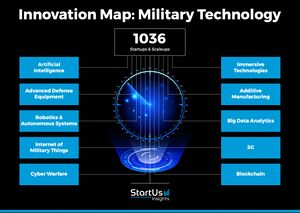
Militaries are responding to the call. NATO announced on June 30, 2022 that it is creating a $1 billion innovation fund that will invest in early-stage startups and venture capital funds developing “priority” technologies such as artificial intelligence, big-data processing, autonomy, biotechnology and human enhancement, novel materials, energy, propulsion, and space.[2] Since the war started, the UK has launched a new AI strategy specifically for defense, and Germany has earmarked just under half a billion for research and artificial intelligence within a $100 billion cash injection to the military.[3]
NATO Allies are launching a ground-breaking initiative to sharpen the Alliance’s technological edge. Allied foreign ministers approved the Charter of the Defence Innovation Accelerator for the North Atlantic – or DIANA. “Working with the private sector and academia, Allies will ensure that we can harness the best of new technology for transatlantic security,” said NATO Secretary General Jens Stoltenberg.[4] A core function of every country is to protect and defend its people and borders. For countries like the UK, being at the forefront of innovation is vital to maintaining an agile, swift, and effective defence strategy. To support this need, Amazon Web Services (AWS) is launching its first Defence Accelerator for UK based startups, and startups from Europe, Middle East, and Africa (EMEA) doing business in the UK.[5]
The Military & Defense Tech startups showcased in this report are only a small sample of all startups we identified through our data-driven startup scouting approach. Download the free Military Tech Innovation Report for a broad overview of the industry and research on the latest technologies and emerging solutions that will impact 2023.[6][7]
The global military apparatus is witnessing significant transformations and leveraging technology trends to strengthen capabilities. Major trends include artificial intelligence (AI), robotics, and the internet of things (IoT) to optimize defense operations and augment military efficiency. Today, conventional warfare is increasingly being replaced by hybrid approaches that also combine cyber warfare and other frontiers. Emerging military technology trends are changing the battlefield in four aspects—connectivity, lethality, autonomy, and sustainability. Connectivity solutions address concerns about how combatants detect and locate their adversaries, communicate with each other, and direct operations. Advances in missile and weapons technologies increase lethality, making battlefield operations more effective. On the autonomy front, startups utilize robotics and AI to execute decisions with zero or minimum human interference. Lastly, startups are improving sustainability in the defense industry with technologies like additive manufacturing and electrification.
United States defense startups
- TurbineOne - US-based startup TurbineOne designs a frontline perceptions system for warfighters. It utilizes machine learning (ML) to offer data-driven insights on battlefields. This includes threat detection, target identification, AI-based video analysis, and classification of killer robots. Moreover, the startup provides this data and alerts even in disconnected, intermittent, and low bandwidth (DIL) environments through a self-healing mesh protocol. This enables fighters to receive smart alerts for unseen dangers in the field without having to code or depend on the internet. - Investment round: $3M
- Onebrief - US-based startup Onebrief develops presentation software that facilitates rapid military planning, especially for joint task forces. It gathers the users’ inputs in one place, enabling them to quickly address new problems and conduct timely mission analysis using various visual tools. Onebrief also auto-updates the outputs, including briefings, sync matrices, maps, and written orders. This enables effective collaboration among the task force members. - Investment round: $500K
- Rebellion - US-based startup Rebellion builds mission-focussed AI products for the defense and security sectors. The startup uses machine learning and the power of data to deter threats and drive mission success. Their subscription-as-a-service model software products are used for achieving comprehensive battlespace awareness, executing autonomous missions, and cyber readiness. Their user-centric software designs are built on open architecture and hence are compatible with existing hardware and software systems. - Investment round: $150M
- Hermeus - US-based startup Hermeus builds Mach 5 capability aircraft. The startup’s Quarterhouse hypersonic jet is being designed to travel at a speed of 3000+ miles per hour. It uses the startup’s proprietary turbine-based combined cycle (TBCC) engine and has both military and commercial applications. The technology is capable of serving air force missions of senior leader transport, intelligence, surveillance, and reconnaissance. - Investment round: $176M
- Epirus - US-based startup Epirus develops directed energy weapons systems. It utilizes solid-state, software-defined high-power microwave technology to enable counter-electronics effects for a range of use cases. Featuring an open architecture, the product integrates with existing ground-based, maritime, and airborne systems for multi-layer protection against autonomous threats. The lightweight pods enable the destruction of critical electronic components, disabling drones. - Investment round: $288M
- Anduril - US-based startup Anduril offers an autonomous UAS for intelligent air support. The startup’s product, Ghost4, is an advanced drone system that uses edge-based AI algorithms. It is man-portable, waterproof, and has a high payload capacity as well as being able to run a variety of missions in any environment. It provides real-time surveillance, intelligence, and reconnaissance capabilities, creating a clearer common operating picture to make more informed military decisions. - Investment round: $691M
- Espre Technologies - Espre Technologies is a US-based startup that offers a suite of sensor technology products for NIN communication. The startup’s chipsets enable wireless digital encryption of data along with 10x simultaneous transmissions. The underlying technology embedded AI for smart threat detection and smart resource spectrum allocation. The network agnostic, secure & scalable communications are built for the battlefield of things and provide bidirectional communications. - Investment round: n/d
- Geosite - US-based startup Geosite aggregates data from different sources for both human and machine analysis. The startup’s collaborative military system uses satellites, the internet of things, and field sensors to build a common operating picture. Data visualization along with management dashboards offers the advantage of information superiority to plan and execute operations. It helps forces in comprehensive intel for situational awareness, tracking threats, marking ranges, and mapping target areas. - Investment round: $6.8M
- Cyber Forza - US-based startup Cyber Forza provides a unified cyber defense platform. The startup’s product has both defender and interceptor capabilities. While the former tackle external threats, the latter addresses internal threats. The platform provides AI-based distributed denial of service (DDoS). Moreover, it enables real-time monitoring, phishing fraud defense, and protection from ransomware and malware attacks. - Investment round: n/d
- GOVRED - US-based startup GOVRED builds turnkey VR-based training solutions for the military. GOVRED utilizes HTC Vive headsets and custom code to create scenarios running at 90 frames per second. This allows users to move around a 25-square meter area, interacting with multiple scenarios. The startup’s proprietary training technology provides the military with a full line of firearms training and combat simulators. - Investment round: n/d
- Red 6 - US-based startup Red 6 develops the Airborne Tactical Augmented Reality System (ATARS), a solution for AR-based combat training. The system combines AR and artificial intelligence for air combat military training applications. It brings virtual and constructive assets into the real world by allowing pilots and ground operators to see synthetic threats in real-time, outdoors, and, critically, in high-speed environments. The technology is scalable to multi-domain operations and assists squadrons in enhancing readiness and lethality. - Investment round: $40.9M
- Rapid Application Group - US-based startup Rapid Application Group produces mission-critical parts for the aerospace and defense industry. The startup provides a range of additive manufacturing solutions such as selective laser sintering, fused deposition modeling, stereolithography, digital light printing, direct metal laser sintering, and injection molding. Its application-based approach enables rapid prototyping and quality assurance of hardware parts. - Investment round: n/d
- WiGL - WiGL is a US-based startup that offers wireless electric charging via targeted energy through the air. The startup’s patented technology uses a mesh network of wireless transmitters. It converts any wall outlet, vehicle charger, or power source into a smart electric power router. Communication occurs device-to-device using 5G or Wifi. With wireless charging, IoMT devices are no longer reliant on the availability of batteries. - Investment round: n/d
- Taekion - US-based startup Taekion develops technology for military data protection. It leverages blockchain to secure defense data in tamper-proof storage. The UNIX-style distributed file system has built-in compression, encryption, and deduplication features and integrates seamlessly with existing infrastructure. The technology offers military-grade protection for information security at all levels. Moreover, the digital box feature enables forensic investigations after any cybersecurity attacks. - Investment round: n/d
- Shield AI - Manufacturer of autonomous drones for surveillance and patrolling. They have developed a deep neural network-based system to create a fully autonomous drone for battlefield applications. It delivers GPS-denied navigation, mapping, exploration, multi-robot collaboration, robot interfaces, and target detection and tracking capabilities. The company has also developed a quadcopter by leveraging its proprietary AI framework. It caters to the need of service members, law enforcement personnel, and first responders. - Investment round: $513.1M
- Dedrone - Provider of AI-based smart airspace security solutions. It comprises an array of RF sensors to detect, identify, and locate various drones in real-time, based on parameters, such as noise, shape, and movement patterns. It has a machine learning-based drone library to automate the protection of airspaces against unauthorized drones. The sensor can also be coupled with cameras to save images and videos for providing crucial evidence of the threat intrusion. It protects people, property, and information against the persistent and escalating threat of drones. - Investment round: $127.9M
- Roboteam - Provider of tactical ground robotic systems. Its product portfolio includes unmanned ground vehicles. It is a GPS-enabled wireless controller system without and with batteries. It is a throwable robotic platform with detection and tactical surveillance capabilities. It is a rugged wheeled UGV equipped with multiple sensors and which helps in route clearance for ground-based defense forces. - Investment round: $62M
- AEye - Provider of AI-enabled LiDAR sensor solutions for automobiles. It offers hardware products that are solid-state lidars with ADAS functionality. It also offers AI-enabled software for perception with features like real-time integration of pixels, predictive solutions, etc. It can be used for various sectors like defense, autonomous vehicles, etc. - Investment round: $314.1M
- Fortem Technologies - Fortem Technologies develops radar systems for detecting airborne objects and counter UAV systems for commercial and military applications. Its DroneHunter is an autonomous perimeter detection (and protection) solution, designed to detect, classify, and secure against rogue drones. On detecting an intruder drone, it uses its AI-directed detection, tracking, and guidance for remediating the air threat at a standoff distance, with no collateral damage. The company also offers a military variant of DroneHunter designed to meet the specific security requirements of the U.S. Armed Forces The counter UAV systems come equipped with TrueView which is a radar system that can be mounted on the UAV for enabling early warning of intrusive or non-cooperative air traffic. It also offers four variants of its radar solution. In addition, it provides an airspace awareness and security platform that provides a 360-degree view of the airspace, with the ability to automatically detect and deploy an autonomous counter-UAS solution to investigate, identify, and remediate threats. Fortem Technologies was spun off from ImSAR LLC, which offers its radar solutions to military clients only and was set up to provide the same radar technology to commercial drone manufacturers and software developers. - Investment round: $21.9M
- SkySafe - Provider of cloud-connected drone detection systems. It has developed airspace security solutions to detect unwanted drones. It offers airspace security with detailed event history (reference for future legal proceedings, if any) and real-time notifications. The security system can take control of a drone without using jamming technology and can safely land it. - Investment round: $45M
- Palantir Technologies - Palantir offers software applications designed for integrating, visualizing, analyzing data, and fighting fraud. Palantir revolutionizes how organizations build and deploy AI/ML by combining the enterprise data foundation with end-to-end AI/ML deployment infrastructure. - Investment round: $3BN
- C3.ai - C3 AI is a provider of Enterprise AI software for accelerating digital transformation. - Investment round: $228.5M
- Primer - Primer builds machines that can read and write, automating the analysis of very large datasets. It trawls thousands of sources online, using natural language processing to read and try to make sense of the vast amount of “open source intelligence”. - Investment round: $168M
- Slingshot Aerospace - Slingshot Aerospace applies advanced analytics, machine learning, computer vision, and collaborative tools to data from earth and space, providing customers with clarity in complex situations. - Investment round: $69.7M
- Merlin Labs - Merlin Labs develops autonomous flight system designed to be installed in existing aircraft. - Investment round: $133.5M
- Airspace Systems - Airspace provides a drone detection and disabling system. It performs multi-dimensional risk analysis by leveraging Artificial Intelligence, machine learning and advanced robotics with situational and historic data. - Investment round: $25M
- Apptronik - Apptronik specializes in human-centered robotic systems. These are robotics systems that operate in close proximity to humans. - Investment round: $14.8M
- Vannevar Labs - Developer of products for the security industry. It develops AI-based solutions for counter-terrorism missions tackling national security problems. It also uses natural language processing and caters mainly to the defense and intelligence industries. - Investment round: $12M
- Actuate - Actuate builds software that employs computer vision to automatically detect gun threats and intruders in security camera feeds. - Investment round: $13.3M
- Kraus Hamdani Aerospace - Developer of AI-enabled and electric unmanned aerial systems. The company offers stealth to radar, autonomous operations, encrypted communications, multi-constellation navigation, anti-jamming and anti-spoofing systems, and endurance systems. It also provides smart Persistent intelligence, surveillance, and reconnaissance (SP-ISR) as a service. It can be used in the defense, security, and aerospace sectors. - Investment round: n/d
- Cleo Robotics - Cleo Robotics is developing a revolutionary new drone technology designed specifically for indoor applications. The company claims to incorporate a combination of stereo vision-based SLAM and neural networks for indoor navigation and obstacle avoidance. - Investment round: $120K
- Reveal Technology - Provider of intelligent systems for the military. It offers intelligent systems for getting real-time updates in isolated areas with no updates from the headquarters. - Investment round: n/d
- Tarsier - Tarsier develops optical-based drone detection and tracking systems for commercial, government, and military users. Manufacturer of AI-based drones for defense purposes. The company claims that its proprietary artificial intelligent algorithms precisely localize and track aerial threats in real-time thereby providing the situational awareness required to defend against aerial threats. - Investment round: n/d
- HawkEye360 - One of the most defining features of today’s world is invisible to the naked eye. Increasingly, the lifeblood of the modern, digital economy is carried by the electromagnetic spectrum. Many types of objects emit radio frequencies for vital functions such as communication, navigation, and operation. At HawkEye 360, our satellites deliver a brand new data layer never before available commercially — precise mapping of radio frequency emissions. This unique ability to identify and geolocate sources of radio frequencies from space reveals previously invisible knowledge about activities around the world. Reveal the unseen with HawkEye 360’s radio frequency (RF) analytics. Use our space-based RF GEOINT to better understand the baseline of activity in your environment, quickly identify anomalous behaviors, cue other sources of intelligence, and act with confidence. Our RF GEOINT is unclassified and easy to share with partners for greater mission impact. - Investment round: $304.3M
- VOLANSI - Volansi is developing infrastructure-independent drones that can take off and land vertically, also known as VTOL (Vertical Take-off and Landing). We see a world where aerial drone delivery will expedite access to critical parts and humanitarian aid in remote locations that were once inaccessible. Our VTOL drones and logistical services make it possible for every industry to deliver anything, anywhere. - Investment round: $75.1M
- ROCKET-LAB - The satellites we build and launch are enabling innovation and exploration, they’re keeping countries connected and borders protected, they're monitoring weather and managing waste, they're providing insights on climate change, and helping us manage resources for future generations. With our Electron rocket and Photon spacecraft, we’ve simplified space, making it easy and affordable for companies, scientists, researchers, governments, entrepreneurs, and students alike, to get their ideas to orbit. We’ve opened up a solar system of possibilities for innovation, exploration and infrastructure in space to make for a better world down here on Earth. Building on Electron’s heritage, we’re developing a new 8-ton class reusable launch vehicle to deploy the constellations of the future. - Investment round: $709.4M
- Saildrone - Saildrone designs, manufactures, and operates the world’s most capable, proven, and trusted USVs. Saildrones are wind and solar-powered autonomous surface vehicles which make cost-effective ocean data collection possible at scale. We collect critical marine data, delivered in real-time, from any ocean at any time of year. We are building the world's largest high-resolution ocean data sets, working with governments and private companies around the globe. - Investment round: $189.5M
- Relativity - 3D-printed rocket startup Relativity Space. Relativity is building the first autonomous rocket factory and launch services for satellites. We are disrupting 60 years of aerospace. - Investment round: $1.3BN
- Capella Space - Capella aims to provide the most frequent, timely and high-quality SAR imagery products available, accessible through an intuitive self-serve online platform. Capella is developing an industry leading Concept of Operations that will lead to timelines not previously experienced in the earth observation industry. We want you to be able to quickly request a tasking image, collect it from our constellation and rapidly get it into your hands so you can make better decisions. We’re not the first to use SAR, but we’ve shrunk the technology tenfold to make it faster, more powerful, and affordable for the world’s decision makers. - Investment round: $179M
- ANELLO Photonics - ANELLO has developed an ultra low-loss on-chip waveguide manufacturing process with all the benefits of Optical Gyro performance integrated onto a silicon photonic circuit platform. The dimensional volume is significantly reduced compared to a traditional FOG while maintaining the low-drift in challenging environments. The integrated silicon photonics solution substantially reduces the cost compared to traditional FOGs of equivalent performance. - Investment round: $28.3M
There are 307 Military Tech startups in United States.
Israel defense startups
- Axon Vision - Israeli startup Axon Vision develops an AI-based decision-making engine. The startup’s product, edge360, uses computer vision technology to provide ground vehicles with complete and automated situational awareness. With an intuitive user interface (UI) and customized alert mechanisms, it detects, classifies, and estimates the whereabouts of threats in real time. The startup’s solution helps tactical teams navigate the threats and obstacles on the field. - Investment round: $1.5M
- Spear - Israeli startup Spear offers instant action drone-based systems. The startup’s tactical drones utilize computer vision, swarm computing, and mesh algorithms to achieve tactical superiority. The drones are suitable for instant launch from, sea, and land with both stationary and mobile platforms with a payload capacity of up to 1 kg. The drones are easy to operate and, hence, require minimal training and provide a tactical advantage to the ground and special forces. - Investment round: $17M - Uvision
- BIRD Aerosystems - Provider of airborne surveillance and missile protection systems. It provides its offerings through two market ends that are Airborne Missile Protection Systems and Airborne Surveillance, Information, and Observation solutions. Its portfolio of airborne surveillance solutions includes maritime surveillance solutions, ground surveillance solutions, border surveillance, and police surveillance solution. It also offers missile protection systems and turn-key programs that include operational analysis, system design, system integration and installation, project management, extended product support, and system engineering activities including ground testing, flight testing, and system certification. - Investment round: $40M
- D-Fend Solutions - D-Fend Solutions has developed an autonomous counter-drone perimeter security system. Claims that the system has the ability to detect, identify and intercepts intruding commercial-drones. As of March 2017, the system is in the alpha stage development and is targeting security & investigation market. Partners include RAFAEL Advanced Defense System, Nevada Institue for Autonomous Systems, RAS Consulting & Investigations, and more. - Investment round: $28M
- 4M Analytics - 4manalytics is an AI-based security intelligence solutions provider. The product offers cloud-based location intelligence solutions, remote sensing, and scouting of mine action. The product visually illustrates all the data collected, analyzed and merged, displaying the insights gained from it, using a convenient user interface and produces a digital twin of the area and situations. It classifies the suspected hazardous area according to the risk. The features of the product include data collection, data analysis & fusion, etc. - Investment round: $41M
- InfiniDome - InfiniDome provides counter-drone systems. It has a proprietary counter-drone system known as GPSdome 1.02 that provides a GPS jamming solution. It is based on Null steering technology. Its other inhouse products include GPSdome Model T that is a mountable antenna module & provides protection against jamming & spoofing of GPS systems and OtoSphere that is an add-on module to GNSS-based systems which protects it from GNSS jamming or spoofing attacks. It provides solutions for wireless communications of connected & autonomous vehicles, UAVs, and critical infrastructure from jamming and spoofing attacks. - Investment round: $5.1M
- ApolloShield - ApolloShield Anti-Drone Systems (formerly AirFence) develops a drone detection system. It involves a ground installation of radio equipment that scans for drone communication signals in its range. When a communication signal for an unauthorized drone is detected, a spoof signal that commands the drone to go out of the protected perimeter is generated and sent to the intruding drone. ApolloShield can be integrated with other systems, such as radar, audio and video-based detectors, and physical net-based disabling systems. - Investment round: $2.6M
- Third Eye Systems - Third Eye Systems is developing Artificial Intelligence-based, aEye, for drones to detect humans & suspicious objects on a pre-defined path. This pug-n-play device can be easily integrated serially and give robots/drones the ability to identify a human presence in the vicinity of its route. It records at the quality of 1080p & also features a thermal camera. - Investment round: n/d
- SkyLock - Developer of counter-drone systems for commercial and military applications. It comprises of three main components that are a 360-degree rotating radar coverage capable of detecting multiple targets simultaneously, an electro-optical system for observation, detection, recognition, and identification of drones with nighttime conditions, and a radio frequency jammer comprising several jamming antennas used to jam the frequency range of the RC and video links. For military applications, the system can be fitted with a laser burner enabling the operator to destroy a drone. The solution allows operators to prevent threats to critical infrastructures like powerplants, prisons, or areas of importance that require wide security coverage such as borders, airports, and stadiums. - Investment round: n/d
- Vorpal - Vorpal is an Isreal-based startup that develops drone detection and mitigation solutions for enterprises. Its chief offering is VigilAir which is a non-transmitting RF-based solution that detects and tracks drones by passive geolocation of their command-and-control and data transmissions thereby providing aerial situational awareness. The company claims that the solution provides zero false alarms and high accuracy even in harsh urban, congested spectral environments. It has also developed a drone-based system featuring RF sensors as a payload that interfaces with the above-mentioned product and the command-and-control center to improve the overall accuracy and coverage, pinpointing the remote-control transmission origin of the commercial drone in real-time. - Investment round: n/d - Florida-Israel Business Accelerator, Gefen Capital
- C4 - Developer of command and control systems for normal aircraft. It provides an aerial command and control system that can be integrated into normal aircraft for situational awareness and faster reaction times. It has features like a rugged touch display, digital navigation, mission management, geo marking, and an emergency locator. Its use cases are in border control, firefighting, search and rescue, and law enforcement. - Investment round: n/d - Starburst Accelerator, Awz Ventures
- Alyar Robotics - Alyar Robotics develops custom made robots and devices for surveillance and military applications. Some of the applications where the robots find use are ordinance defusing, night surveillance, monitoring hazardous places such as radiation zones, toxic environments etc. Some of the offerings are all terrain Mirage, tracked Stayer, magnetic Magma or the micro sized Dor. Apart from these, the firm also ventures in developing simple monitoring solutions for other industries such as healthcare. - Investment round: n/d
- Netline Communications - Netline Communication Technologies (NCT) provides electronic countermeasures and spectrum dominance solutions including counter Improvised Explosive Device (IED) Jamming & electronic warfare intercept and signal intecept, communication, cell phone and wireless detection systems. Product Vaulto is an anti-malware and secure encrypted solution for mobile device. Other solutions include contraband communication management, wireless intrusion detection and Emergency mobile communications and emergency victim location solutions for search and rescue operations. - Investment round: n/d
There are 41 Military Tech startups in Israel.
German defense startups
- FibreCoat - FibreCoat GmbH produces thermoplastic-coated fibers for composites and aluminum-coated fibers for shielding applications. - Investment round: $4.3M
- Blackned - Blackned GmbH – Your trusted partner for highly secure mission and business-critical communication networks. - Investment round: n/d
- WARGdrones - WARGdrones enables soldiers to protect their perimeter against unwanted intruders through AI-led drone perimeter defense. WARGdrones is a German startup that enables soldiers to protect their perimeter against unwanted intruders through AI-led drone perimeter defense. Its proprietary automated drone system, GARMR, consists of a drone-home, WARpad, and a drone, PEREGRINE. The drone searches the target coordinates for intruders and the system notifies the connected control center upon positive identification. It then confirms the identification and notifies concerned authorities. Further, the drone interacts with the intruders via a speaker and allows the operator to trigger a dye capsule, which makes the intruders identifiable should they flee the scene. Additionally, GARMR takes on patrol duties or functions as a first responder to fight emerging fires by dropping flame retardants at desired locations. - Investment round: $1.6M
- Dronefence - Dronefence is a developer of drone detection systems. It claims to use a multi-sensor array and multiple cameras to detect and localize positions of drones entering specific airspace. It claims to use machine learning algorithms to recognize authorized and intruding drones. It's intended to be used in critical infrastructure establishments, public places, etc. - Investment round: n/d
- Multirotor - Multirotor provides surveying, monitoring, and inspection services using proprietary drones. The product line includes G4- a quadcopter drone and Eagle G4- an octocopter drone featuring a payload capacity of up to 2.5 Kgs. These drones work in integration with a companion flight planning software that processes the real-time images collected by the drones for creating georeferenced images, producing orthoimage & digital elevation models, point cloud generation, volume calculations, and creating 3D models & animations. The target market includes airport and police department. As of August 2018, the company offers three different packages to clients with prices starting from $ 0.56/sqm. In addition, the company provides a multicopter drone for applications in the field of intralogistics. Clientele and partners include Polizei Berlin, Fraport, Droninspect, Ecosil, Mainzer Netze etc. - Investment round: n/d
- Aaronia - Aaronia is a manufacturer of radio-frequency based products including, RF spectrum analyzers, RF signal generators, magnetic and RF shielding materials and devices, RF probes and antennae, RF drone detection systems, etc. It also builds software for its spectrum analyzer hardware. Its drone detection system can be used standalone or can be connected together to detect drone intrusions into large areas. - Investment round: n/d
- skypoint-e - skypoint-e GmbH designs and builds tethered multicopters and aerostats for persistent security & surveillance and academic research purposes. Its tethered systems can stay airborne for very long periods. It has stated applications in wind energy research, as well as standard commercial applications such as mining inspections, and disaster response. - Investment round: n/d
- Envryo - Provider of a VR platform that enables simulation of man-portable weapon systems. Claims that the platform is based on off-the-shelf hardware and enables users to simulate a menu structure & operating procedure of any existing or in-development equipment. Features artificial intelligence, dynamic environments, atmospheric effects, 3D sounds, night vision, and sensor view solutions. - Investment round: n/d
- Minator - Provider of rugged computer systems for the military. It develops devices that can control SOCOM operations, demolitions, SWAT operations, and underwater demolitions. The main products are radio-controlled initiators, time-controlled initiators, and radio and time-controlled initiators. - Investment round: n/d
- WORK Microwave - Manufacturer of RF-based electronic products. The company offers a series of products related to satellite communication, defense electronics, sensors and measurement systems, and navigation simulators. - Investment round: n/d
- RTDynamics - RTDynamics provides real-time dynamics software for multiple industries. The company offers products such as rotary wing computer-generated forces, certification level helicopter/aircraft flight dynamics packages, and models for real-time RADAR, electronic warfare, and missile systems. It can be used to build pilot training, engineering/HIL, air combat, and radar simulation applications. - Investment round: n/d
- Quantum Systems - eVTOL Fixed-Wing UAVs combine the advantages of helicopters and airplanes. Vertical take-off and landing capability and sophisticated aerodynamics in perfect symbiosis – in one product. Our drones are easy and safe to operate. The development of all function and mission critical hard- and software components happens in-house. The workflow design of our comprehensive systems allows for high user friendliness and low training efforts. - Investment round: $61.7M
- Helsing - AI-based environment protection platform for government organizations. It provides real-time information processing and turns unstructured sensor data into information. - Investment round: $126M
- Isar Aerospace - Engineering the future of space flight. Launching is the first step to space. By enabling access to space, we contribute to humanity’s progress and our planet’s sustainable technological and economic development. - Investment round: $182.6M
There are 14 Military Tech startups in Germany.
United Kingdom defense startups
- Drone Defence - Drone Defence builds drone detection and disabling technologies. It builds a detection system called Drone Tracker, using audio, visual, and near-optical IR sensing. Its disabling technology, called Net Gun X1 is a hand-held tool that can be used to project a net for capturing drones up to 15 meters away. The company also provides consultancy on counter-drone measures to enterprises. - Investment round: $16M
- Operational Solutions - Provides drone detection systems. It provides real-time detection sensors that identify drones and provides drone effectors such as jammers and physical interception systems. It caters to defense, security, and aerospace industries. - Investment round: $11M
- Animal Dynamics - Animal Dynamics (AnDy) is a research-based robotics company that aims to build small robots for multiple applications. The company uses biomimetic methods to design its robots. Its first product is a dragonfly-inspired drone for surveillance. The drone is autonomous and can be used for military applications, including hostage situations and other stealthy missions. - Investment round: $11.4M
- Edixomed - EdixoMed develops wound dressings for dermal/wound healing especially focused on chronic wound care. It provides prolonged delivery of NOx direct to the skin providing a moist wound environment, which absorbs wound fluid, prevents infection, increases blood flow, and accelerates healing. It can be used for the treatment of diabetic foot ulcers, chronic wounds, acute wounds, respiratory, and critical care. - Investment round: $2M
- Claresys - Providers of web-based optical and IR imaging solutions for surveillance. Its product line includes a compact optically scanning enhanced pinhole camera. It has multiple features including independent internal zoom and internal pan, tilt capability leveraging its proprietary optical component arrangements, and solution customization. - Investment round: $914K
- Diamond Microwave - Diamond Microwave is a provider of amplifiers for space communications. It includes CW high-power microwave SSPA with power output ranging from 100W to 1kW and operating in specific frequency bands between 2GHz and 18GHz. It can be used in weather radar, medical and materials science, marine radar and maritime vessel traffic control, air traffic control and border security radars, military tracking radars, and airborne or space-borne SAR for ground mapping EW and jamming. - Investment round: $4.4M
- Evolve Dynamics - Evolve Dynamics develops drones for mission-specific surveillance applications in public sector services, private security, and defense sectors. Its chief offering is a quadcopter drone, also known as Sky Mantis, that can fly in 40-knot winds and heavy rain and features an endurance of up to an hour. It can be equipped with multiple payloads such as a dual gimbal containing an IR/thermal and 30 times optical zoom 1080p HD cameras. The company has also developed a mid-flight detachable tether system that can power the aforementioned drone from the ground via a thin cable for up to 24 hours and keep the aircraft at 100-meter altitude. - Investment round: $680K
- OpenWorks Engineering - OpenWorks Engineering is an engineering firm that aims to develop product-based solutions for the rail, defense, energy, security, agriculture and industrial sectors. The chief area of focus for OpenWorks is security and counter-terrorism. Its flagship product Skywall is an anti-drone gun that can be used by an operator to shoot a net at a target drone (static or moving), using a compressed gas-powered launcher and a projectile that includes a net and other components, such as a parachute for intact recovery of the target drone, or a radio jamming device to prevent possible remote detonation of the target drone by hostiles. - Investment round: $3M
- ISS Aerospace - Manufacture of unmanned air systems and unmanned combat air systems. It also develops autonomous air, marine, and land carriers. It uses its propriety drone autopilots, gas and chemical sensors, LiDAR, depth cameras, multispectral and IR sensors, magnetometers, EM loops, SLAM mappers and CMOS sensors for the manufacturing of the unmanned aerial systems. It caters to the civilian and military markets. - Investment round: n/d
- IQHQ - Software defined radio and communication platform provider for military. It provides platform interfacing with multiple receivers and transmitters capable of banded operation from 50MHz to 6GHz. TDD and FDD operation. Also, provides solutions to police, customs excise, and others. - Investment round: n/d
- Vizgard - Vizgard provides AI-based object tracking for unmanned and counter-unmanned systems. This enables automatic visual confirmation and tracking threats such as unauthorized drones. Vizgard is a UK-based startup that provides AI-based object tracking for unmanned and counter-unmanned systems. The startup’s edge processing platform, VizEDGE AGX, deploys its computer vision server, FortifAI, on its proprietary drone, VIZEDGE AIR. This enables automatic visual confirmation and tracking threats such as unauthorized drones. VizEDGE AGX‘s image enhancement functionality also reduces image degradation due to external factors like heat turbulence, fog, and platform movements. Further, Vizgard’s real-time track position information directs any internet protocol (IP) or serial digital interface (SDI) camera-based system. This allows automation and reduces the cognitive burden on operators. - Investment round: $750K
There are 63 Military Tech startups in the United Kingdom.[8]
France defense startups
- HarfangLab - French startup HarfangLab deploys cyber defense solutions to protect critical infrastructure environments for national defense. The startup’s technology is built on ultra-robust programming offering both high computing speed and enhanced security. Its EDR software assists in the supervision, automatic detection, investigation, and neutralization of cyber threats. The open-by-design structure enables the software to easily integrate with existing cybersecurity solutions in any organization.. - Investment round: $5M
- Delfox - French startup Delfox provides predictive technology to automate tasks in complex environments, such as for multi-actor cooperation. The technology leverages deep reinforcement learning to learn from data from previously encountered situations and adapts accordingly. The startup’s products enable maneuvering for unmanned vehicles and the detection and communication of relevant information in a timely manner to the forces. - Investment round: $1.3M
- Preligens - Developer of AI and cloud-enabled satellite imagery services for surveillance and monitoring. It integrates computer vision, cloud analytics, and AI. It aggregates information from multi-intelligence sources such as imagery, electromagnetic or open-source systems to enable site monitoring. It facilitates aerial, marine, and satellite imagery analysis. Its applications include drone monitoring, aircraft identification, submarine activity monitoring, quick response alerts, and monitoring of ongoing operations. It caters to the defense and intelligence sectors. It has been featured in FranceCulture and Forbes. - Investment round: $28.3M
- CerbAir - Cerbair develops civilian drone detection system named "DroneWatch" that uses stereovision technologies and advanced algorithms. DroneWatch is able to detect, track and identify any flying threat in real-time and in any environment. Its automatic warning system can identify the violators through real-time alerts and digital evidence collection. Its solution can be used in the defense sector, Government organizations, Office Public areas, Airports etc. The company has been quoted in several media channels such as Le Point, La Tribune, Silicon, La Croix etc. CerbAir is a subsidiary of Technofounders. - Investment round: $8.5M
- Numalis - Numalis provides tools for analyzing and testing software. The products offered by the company are Spoat and Wizoat. The features of the product include early bug detection, optimized testing, software integration & performance, automatic debugging, etc. The product also offers a spell checker for performing calculations. - Investment round: n/d
- Ulis - ULIS manufactures thermal imaging sensors for tactical applications. Its detailed product portfolio includes thermal imaging sensor chips provided in multiple resolution ranges such as XGA resolution, VGA resolution, QVGA resolution, QQVGA resolution, and low resolution. It is used for multiple applications including thermography, surveillance, defense, and outdoor applications catering to multiple business verticals including defense and other business verticals. - Investment round: n/d - General Electric, CEA Investissement
- ARMTEK - Provider of an AI-based software platform to standardize business operations. It offers a software solution that virtualizes business procedures to support military organisations. It enables enterprises to formalise and set standards for day-to-day operations and enhance productivity. - Investment round: n/d - SEMIA
- Nexvision - Nexvision is a hardware and software design house specialized in optronic systems & vision solutions in UV, night, SWIR, LWIR/Thermal and Terahertz bands. It provides its designs to various industries like extreme sports, aeronautics, automobile, security and surveillance, etc. It also have multiple automotive customers including Renault Nissan. - Investment round: n/d
- Diginext - Diginext develops simulation solution for tactical operational training and analysis. Its product offerings include simulation solution for aircraft, analyzing armed force capacity gaps & needs against new threats, virtual maintenance training, constructive training, and operation analysis. In addition, it offers services for security maintenance, training of armed forces and support of maintenance operations. - Investment round: n/d
- DIODON Drone Technology - DIODON Drone Technology designs and builds drones for commercial and military applications. Its multicopter drones are inflatable (the rotor arms) and can be deflated for easy portability. The DIODON drones are called SP20, MP40 and HP150 in increasing order of payload capacity (200g to 1.5kg). These are designed as general-purpose drones, applicable to data acquisition and paylaod transport functions. These drones are water-resistant as well. - Investment round: n/d
- Novadem - Novadem develops unmanned aerial vehicles for surveillance and reconnaissance in defense and security sectors. Its product line includes NX70 and U130 . NX70 is a quadcopter micro-drone featuring an endurance of 45 minutes, a range of +1.8 mi, and is compatible with defense map formats (France, NATO) as well as coordinates formats (MGRS, UTM, Deg Min, and more). U130 is ideal for surveying purposes and comes with two compensation axis that ensures the stability of the camera (at the nadir) and photoshoots orthogonal to the ground. It interfaces with a mission preparation software that allows users to define the area to be overflown on a map (Google Map, Bing), select camera in the drop-down list, and define the resolution (GSD) and the expected pictures’ overlap. - Investment round: n/d
There are 26 Military Tech startups in France.
Canada defense startups
- Fatigue Science - Fatigue Science has developed wearable devices to optimize sleep and manage fatigue in athletes, military, and organizations. The company's products include ReadiBand which is a wearable device used for tracking sleep and Readi analyzes those data to predicts sleep's impact on reaction time and cognitive effectiveness. - Investment round: $400K - Rhino Ventures, Conconi Growth Partners, Nelson Investments
- AirShare - AirShare has developed counter-drone systems to protect critical infrastructure such as airports from malicious drones. Its offering, also known as OVERWATCH Interceptor-UX, uses a surface-to-air missile able to create high-persistence countermeasure cloud. It comprises of four main components namely the missile that create the countermeasure cloud, uFDR detectors to detect the UAV threats, remote monitoring terminal which is used to identify the drone threat, and the base station used to launch the missile. Claims that the solution is based on five patent-pending technologies which enable detection, tracking, and kinetic mitigation of small UAVs using a high-persistence countermeasure cloud which improves the ability to defeat incoming small UAV threats under all conditions by disabling their propulsion system. - Investment round: $220K - Techstars, Gener8tor, Invest Ottawa
- Bionic Power - Bionic Power’s first product - the PowerWalk M-Series - was developed in collaboration with the Canadian Forces and the US Army. With a device on each leg, a user walking at a comfortable speed generates an average of 12 watts of electricity. Now the company is also planning to make such products that can have applications in healthcare, direct consumer applications like on a trip etc. - Investment round: $106K - WUTIF Capital, Foresight Cleantech Accelerator Centre
- Bravo Zulu - Bravo Zulu is a manufacturer of counterintelligence hardware and software products to marine, defense, and security industries. It provides Electronic Counter Measures (ECM) and unmanned aerial vehicles. It provides various devices that can be used for detecting and jamming unwanted drones. It can be used in military, special forces, secret services, marine, NGOs and multinationals, anti-corruption committees, banks, and security companies. - Investment round: n/d
- MMIST - Mist Mobility Integrated Systems Technology (MMIST) manufactures unmanned aerial vehicles for strategic delivery operations. Its SnowGoose and Sherpa precision delivery UAVs find applications chiefly in military operations and disaster relief. The SnowGoose UAV can be launched from both land and air, and flies autonomously. Payloads are attached to parachutes. The company also builds a mission-planning software system called LaunchPADS, and a navigation tool for human parachutists. The company also provides reconnaissance and communications services using its UAVs. - Investment round: n/d
- ICOR Technology - ICOR Technology Inc. designs and develops remotely operated vehicles and counter terrorism equipment to law enforcement and military agencies. Provides a series of ROVs under name 'CALIBER' robots which has mainly 4 different sized platforms providing remote capabilities for SWAT, EOD and Hazmat teams, provides customized solutions for these platform for different teams as per the application. - Investment round: n/d
- Simthetiq - Simthetiq is a provider of training and simulation for the military. The company offers X2 visual systems, 3D model libraries, synthetic environments, and virtual training. It can be used in training and simulation, defense and security, aerospace, transportation, emergency management, and healthcare. - Investment round: n/d
There are 27 Military Tech startups in Canada.
Australia defense startups
- Q-CTRL - Australian startup Q-CTRL offers cloud-based software for maximizing performance in quantum computers. It utilizes quantum computing for various defense applications. The startup’s solution enables cryptographic analysis and sensor-based detection of underground hardened structures and hidden weapons systems. Moreover, it facilitates quantum-enhanced navigation in GPS-denied battlefields through atomic accelerometers. - Investment round: $43.4M
Sweden defense startups
- Tactital Headsets - Swedish startup Tactital Headsets makes proprietary lightweight noise-reducing headphones for military professionals. The startup’s range of headsets, Sena, is waterproof and features advanced noise cancellation. The headsets connect to smartphones and major two-way radio systems, as well as incorporates with most communication systems. This enables the delivery of clear and distinct communication even in really tough and noisy environments such as battlefields. - Investment round: n/d
Slovakia defense startups
- 3IPK - Slovakian startup 3IPK offers a process management system for the defense and aerospace industries. It combines blockchain technology with data analytics and artificial intelligence. The solution automates the supply chain and maintenance processes. Moreover, it enables smart contracts, and increases traceability and transparency, thereby leading to efficient process management and quality control. - Investment round: n/d
India defense startups
- Acculytics Chemicals Private Limited - Acculytics Chemicals has been developing future-oriented solutions in order to boost the Indian defense sector. The company is known in the industry as a reputed manufacturer of defense-grade protective coatings. - Investment round: n/d
- Big Bang Boom Solutions - Offers a range of defense solutions that include T-Series Unmanned Tank Development, Next Generation Hybrid Personal Combat Armour, 360 Advance Battle Interface, Anti-drone Defense System, and more. - Investment round: $1.2M
- Cron AI - An expert in manufacturing multi-sensor-enabled intrusion detection systems for the defense space. - Investment round: $4M
- Edgeforce Solutions - Designs, develops and creates secure and hardened deep technology products based on System on Module (SOM), System on Chip (SOC), Tiny ML, and other niche technologies. - Investment round: n/d
- Exicom Technologies India - Provides advanced battlefield solutions, along with specializing in manufacturing & developing indigenous defense and allied technologies. - Investment round: n/d
- Fortytwo Labs - Designs a range of solutions to address the needs of customers in a variety of operational areas in the defense sector. Cryptographic Identity Technology. - Investment round: n/d
- KVR Solutions - A team of specialists comprising policy experts & personnel who were formerly with the Indian armed forces, defense procurement, and program development, along with subject matter experts in varied fields. - Investment round: n/d
- Sagar Defence Engineering - Specializes in manufacturing completely Unmanned Marine Vehicle solutions to Commercial, Defence and Scientific areas. - Investment round: $38K
- Techera Engineering - One of the largest tooling manufacturing companies for the Defense & Aerospace sector in India with a 75,000 sq. ft. world-class manufacturing facility. - Investment round: n/d
- Niral Networks - Indian startup Niral Networks provides private 5G Infrastructure for last-mile connectivity. Its open and disaggregated network operating system, NiralOS, facilitates 5G and edge computing products. It integrates with any off-the-shelf white box hardware. For defense organizations, the 5G infrastructure enables rapid and cost-effective digital transformation at all fronts. - Investment round: n/d
Today, there are 194 defense tech startups in the country.[9]
| Feature | MVP Alpha | MVP Beta | MMP Gamma | MMP Delta |
|---|---|---|---|---|
| Hardware: | ||||
| Two HD / IR cameras | + | + | + | + |
| Multimedia system | + | + | + | + |
| Media integration via Bluetooth | + | + | + | + |
| DLP optical scheme FOV 105° | + | + | + | + |
| Low breathing resistance of respiratory and visual protection | + | + | + | + |
| Built-in drinking system | + | + | + | + |
| Built-in bright light source with adjustable brightness | + | + | + | + |
| External loudspeaker | + | + | + | + |
| Handheld portable VHF / UHF radio integration | + | + | + | + |
| Active head (under-helmet) ventilation | + | + | + | + |
| Open and closed communications | + | + | + | + |
| Integration with ballistic helmet | - | + | + | + |
| Vitals body sensors | - | + | + | + |
| Built-in Software Defined Radio | - | - | + | + |
| LiDAR | - | - | + | + |
| Ultrasonic sensors | - | - | + | + |
| Embedded passive radar | - | - | - | + |
| External active phased radar connection (remote mobile radar, UAV equipped with radar) | - | - | - | + |
| Software: | ||||
| Graphic User Interface | + | + | + | + |
| Voice control | + | + | + | + |
| Speech-to-text | + | + | + | + |
| Virtual keyboard | + | + | + | + |
| Maps, compass and GPS positioning | + | + | + | + |
| Hand tracking control | - | + | + | + |
| Friend-or-foe identification (Bluetooth, p2p WLAN / Wi-Fi Direct | - | + | + | + |
| Night vision | - | + | + | + |
| Thermal imaging vision | - | + | + | + |
| Stereo camera | - | + | + | + |
| Digital zoom and distance measurement (Computer Vision) | - | + | + | + |
| Angle, speed, temperature, pressure, humidity measurement (Computer Vision) | - | + | + | + |
| Drone and external cameras view | - | + | + | + |
| Digital aiming system integration | - | + | + | + |
| Rear view | - | + | + | + |
| Voice, text, icons and images messenger (voice, text, visual communications) | - | + | + | + |
| Video recording | - | + | + | + |
| Navigation (Artificial Intelligence) | - | + | + | + |
| Ballistic calculations and shooting history | - | + | + | + |
| Task management and checklists | - | + | + | + |
| Oxygen level, heart rate, body temperature, hydration level sensors data-driven monitoring | - | + | + | + |
| Software Defined Radio | - | - | + | + |
| Firing assistance (auto-capture, aiming, correction, hit tracking) | - | - | + | + |
| Mixed vision HD / IR / Thermo / LiDAR | - | - | + | + |
| Geolocation capture, own and enemy positions exchange (Computer Vision, Artificial Intelligence) | - | - | + | + |
| Auto-tracking of own positions and execution of tasks (Artificial Intelligence) | - | - | + | + |
| Radio Direction Finding (friend-or-foe identification) | - | - | + | + |
| Real-time access to library (Wiki) and reference materials | - | - | + | + |
| Face and object recognition (Computer Vision, Artificial Intelligence) | - | - | + | + |
| Motion and flashes detection (Computer Vision, Artificial Intelligence) | - | - | + | + |
| C4I integration (Artificial Intelligence) | - | - | + | + |
| Missile engines heat & smoke traces (Computer Vision, Artificial Intelligence) | - | - | - | + |
| Ambient sound filter (ISR tasks, Machine Learning) | - | - | - | + |
| Emotion assessment (Computer Vision, Artificial Intelligence) | - | - | - | + |
| EHR integration | - | - | - | + |
| Live-synthetic training environment (Computer Vision, Artificial Intelligence) | - | - | - | + |
Product & Technology
We are planning the next stages of product development (Hardware and Software):
- MVP Alpha - the first stage of development after prototyping between the Pre-Seed round and Seed round to use this version in lab tests
- MVP Beta - the second stage of MVP development between the Pre-Seed round and Seed round with bug fixes and functionality extensions to use this version in field testing
- MMP Gamma - the third stage of finished marketing product development after Seed round with MVP fixes to use this version in pilot deployment programs
- MMP Delta - the fourth stage of developing a finished marketing product to improve and expand functionality, and to form a product line for different optional purposes
Within each stage, there are typically up to 4-5 iterations of the product. For more details on the composition of the functionality of each stage, see here.
Augmented Reality Head-Up Display Fullface Mask (ARHUDFM) is the Tactical Augmented Reality Electronic Device - disruptive human capabilities for a tactical advantage along with comfortable respiratory and facial protection (removable module). Our technology opens up opportunities that are always at your fingertips: situational awareness, silent multichannel digital communications, ultimate security features at night, firing assistance, Computer Vision, Artificial Intelligence, a personal high-end respiratory protection system (gases, aerosols, dust, bacteria, viruses) with integrated drinking system and a negligible breathing resistance, civilian applications for physicians, surgeons, firefighters, and police.
1. Mask design
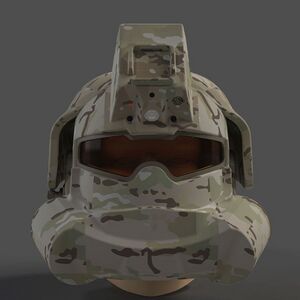
This product provides the ability to use it without the removable lower mask module, which is designed to protect the respiratory system and the integrated hands-free built-in drinking system. The respiratory protection rating is one of the highest. It uses two interchangeable ULPA filters that provide a 99.9995% level of protection against gases, aerosols, dust, bacteria, and viruses. This is a multipurpose type of filter that has an additional filling of treated activated carbon. The filters are IP67 or better protected against moisture. The total area of the two filters is oversized so that the breathing resistance is as low as possible, lower than that of counterparts commercially available from leading manufacturers 3M, MCA, Dräger, etc. It is our intention that the wearer will be able to breathe without difficulty even during intense physical exertion. To protect the respiratory system from carbon monoxide, a special modification of the removable filters will be developed. This is important for firefighters when working with landscape fires and for fighting fires in building structures. In addition, an adapter will be used to attach a compressed air reducer for SCBA (Self Contained Breathing Apparatus) systems instead of the cover of one of the filters. The second cover, when using the SCBA, blocks the access of contaminated air.
The mask protects the face in the area of the eyes, ears, forehead, and back of the head from shards of glass, wood chips, stones, and sandy debris, which can have high kinetic energy and cause superficial and penetrating wounds to the face and head. Together with the lower part of the respiratory protection module, the face is fully protected. In the short term, the mask does not provide ballistic and shrapnel protection on the fly, unlike certified Class 1 and 2 ballistic helmets (IIIA NIJ). We are thinking of making a carbon fiber-reinforced modification in the future. The mask does not match the currently produced Kevlar (aramid fiber) ballistic helmet designs. We have developed a special design of ballistic helmet and helmet for firefighters, which will be produced by our partners.
The problem of lens fogging, which for a period of tens of seconds to several minutes completely deprives the user of optical situational awareness, is solved as follows. The mask has two visor lenses with an air insulation barrier between them and an elastic seal around the edges that prevents air exchange and air vapor access. When the mask is used together with the lower part, another seal around the face contour prevents air access to the inner lens surface. Together, an inert system of staggered temperature transitions is formed from the face around the eyes to the inner lens and then to the outer lens, separated by two insulated air chambers. When moving from a cooler to a warmer state, there is no condensation on the lens surface because the lens system retains its thermal inertia longer and does not experience a drastic difference. When in the cold, the exhaled warm air is led away through the insulating skirt to the exhaust valve. When in a fog, condensation from the air condenses on the cooler surfaces, but since the lens system is temperature dependent and much more inert than, for example, the lenses of typical eyeglasses, the outer lens is not cooled down sufficiently for a dew point to form on its outer surface. The physical meaning of the counteraction of condensation is always the same. The dew point at the temperature contrast between the body and the outside air must be in the area of the thermal insulating barrier, which itself has water and vapor barrier that prevents the penetration of air vapor.
The air space around the eyes is also ventilated by using the lower part of the mask. The air pipes that connect the filters and the obscuring area have technological openings with elastic plugs. During inspiration, the purified air moves to the obscuring area and, by Bernoulli's effect, some air is also aspirated from the sealed area around the eyes, where a slight vacuum occurs. The outlet valve prevents outside air from entering bypassing the filter. The obscuring area inlet valves prevent air from moving back in during exhalation. During the pause between breaths, the pressure in the air chamber around the eye is balanced by the connection to the filter chambers.
Reduced visibility in the infrared spectrum thermal imaging cameras. The mask protects the open areas of human face skin from thermal light. This reduces the temperature contrast between the surrounding objects and the body parts that the thermal imaging camera records. As you know, the face is the warmest part of the human body.
Technological openings are provided in the headphone area so that the person does not lose acoustic awareness when using the mask. In the back of the mask, there are technological openings for ventilation of the electronic components with the airflow direction from top to bottom. This provides additional active ventilation of the user's under-helmet space and, on the other hand, directs warm air to the neck area, which also provides comfort in use, especially during the cooler seasons.
2. Mask characteristics
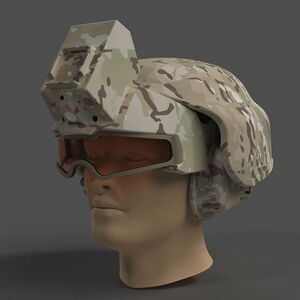
Despite the apparent high weight of the mask (approx. 1.3 kg or 2.8 lbs, without the removable lower mask module 0.9 kg or 2.0 lbs) together with a Class 2 ballistic helmet (1.5 kg or 1.3 lbs) the weight is evenly distributed across the head and has low torque, significantly lower than that of modern night vision devices with a lot of frontal protrusion. According to military experts, torque is significantly more important than static mass. For comparison, here is the mass of helmets that are widely used today:
- Class 2 helmet (IIIA NIJ) (1.5 kg or 3.3 lbs) + night vision device (1.2 kg or 2.7 lbs) = 2.7 kg or 6.0 lbs
- firefighter's helmet (1.5 kg or 3.3 lbs) + flashlight (200 g or 0.4 lbs) + full-face mask (650 g or 1.4 lbs) + compressed air reducer (300 g or 0.7 lbs) + radio headset (145 g or 0.3 lbs) = 2.8 kg or 6.2 lbs
- Titanium or composite class 2 helmet for special operations forces with visor (2.5-4.5 kg or 5.5-9.9 lbs) and radio headset = 2.7-4.7 kg or 6.0-10.2 lbs
- integral helmet (1.3-1.6 kg or 2.9-3.5 lbs) + radio headset (145 g or 0.3 lbs) + aerodynamic pressure at speeds >100 miles (4-9 kg or 8.8-19.8 lbs) = 5.4-10.7 kg or 11.9-23.6 lbs
We have high hygienic requirements for the product. The materials do not cause allergic reactions. Water and dust protection class IP67 or higher. The electronic components are sealed in a rugged housing and are actively cooled with an aluminum radiator on the top of the housing and on the inner surface at the front. The mask has interchangeable elements: 2 air filters, 2 filter covers, 1 face contour seal. The mask can be cleaned with water and alcohol sprays on the outside and inside. We do not recommend the use of alcohol-containing products to treat the transparent visor as this may cause clouding.
We have also provided different sets of functionality depending on the user's specialization. For example, some modifications will add additional digital communications, advanced vision and hearing capabilities, and digital assistants, while other modifications will not require some capabilities. All physical product modifications are similar. They differ in the composition of electronic modules and performance.
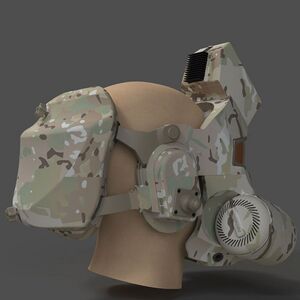
The size of the mask is adjusted to the size and shape of the head by using the rotating parts on the back of the mask with a locking mechanism. There are 14 soft wear-resistant cushioning pads to minimize the perceived pressure on the soft tissues of the forehead and occiput. Their area and geometry are large enough to ensure that the mask is held firmly on the head and that the pressure is evenly distributed so that it does not cause discomfort or interfere with blood flow to the soft tissues of the head. Four rigid tensioners connect the front and back of the mask. To remove the mask, use two fingers to squeeze the locking latch behind the ears. This can easily be done one-handed with or without gloves. The mask still remains on the head and will not fall off. Once the mask is removed, it can be folded and reduced in size.
3. User-friendly use
We strongly oppose all external connections and cables, which can cause inconvenience and danger. However, in individual cases, there is no alternative. We have therefore arranged the connection points in such a way that free-hanging cables and flexible tubes are located as far back as possible so that they cannot be accidentally caught by the user. The mask can be connected to:
- drinking system tube, located in a backpack, through the sealed connector on the right side, near the right-hand filter cover
- UHF / VHF external antenna cable from a backpack, via BNC connector in the occipital area
- mask battery charging cable via a back connector (usually enough for more than 72 hours but a power bank can be used)
- handheld portable radio through the 4-pin connector on the left earpiece (built-in headset, not required if using built-in UHF / VHF Software Defined Radio)
- air supply tube to pressure reducer in place of filter cover left or right (usually used by firefighters and rescue workers)
- external device (flashlight, LiDAR, passive radar, other sensors) via NVG mount on the front of the mask top
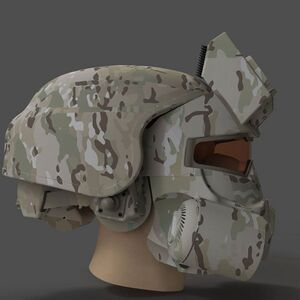
We are researching promising options for troop security, such as the use of sensors (detectors) to remotely detect explosive tripwires (booby traps), pressure mines, and improvised explosive devices (IEDs) triggered by proximity. In the future, if successful, we will make such external devices available as an option for attachment via NVG mounts.
The following electronic components are built into the mask for a variety of applications:
- LED flashlight with an adjustable light level and several modes (including SOS signal)
- loudspeaker with an adjustable sound level which can be used for voice transmission over longer distances than normal and in noisy environments
- external microphone allows you to amplify the level of ambient sound to the level audible to the human ear, and is part of the Ambient Sound Filter, which allows the software to select and suppress not only certain frequencies of carriers but also to form recommendations to the user
- internal microphone is built into the obturator of the mask and allows the user to use the voice to communicate and for voice control while remaining inaudible to surrounding people
- headphones have the function of sound reproduction, protect against high noise levels, protect the user's ears and part of the head from outside influences, and have technological openings that allow the user to remain acoustically aware without the use of electronic assistants
- two HD / IR cameras in front and one rear camera enable to record of video and static images for monitoring, analysis, zooming, transmission to other users and also used in Computer Vision services and in stereo camera mode for measurements, besides using infrared illumination emitter the cameras transmit images at night visible in the infrared spectrum (night vision)
- front-facing thermal imaging camera transmits video and static images to the user, showing the temperature of the environment
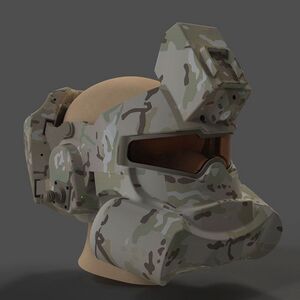
The mask is designed for long-term wear, so it contains a long-life battery (over 72 hours). The comfort of long-term use differentiates the mask from most other devices worn on the head. In particular, the mask is differentiated by its very low breathing resistance while protecting the respiratory organs and very low pressure on the soft tissues of the face and head. To prevent the user from experiencing dehydration, a drinking system is integrated into the mask. The design of the mask protects the user's eyes from direct sunlight and the visor of the mask is tinted.
4. Mask specific features
The mask, like any other mask or goggles, limits visibility in the peripheral area from below by about 30% of the visible lower peripheral area. We find this acceptable and will conduct future research and testing to reduce this effect if possible.
When a projection system is used, a beam of light is directed onto the visor screen from the inside at an angle of about 47° to the line of sight (between the outgoing ray and the surface normal). The masked person's face is only slightly illuminated and has no effect on the user's visibility in the dark. The source of the beam can only be seen by others at close range in the dark if the user lifts their head significantly. To reduce the effect of sunlight shining into the screen (visor), the mask has a solar cover. The visor is made of transparent polyurethane, comparable in strength to polycarbonate. As with any mask or goggles, the visor may produce glare when the sun or artificial light sources are placed low.
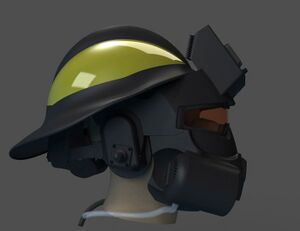
We provide for integration with ballistic helmets and helmets for firefighters and rescuers. The design of the helmets has been developed and will be manufactured by our partners, who currently have extensive experience in manufacturing such products.
Controls:
- buttons on the left and right earpiece bodies
- joystick on right earpiece body
- hand tracking control
- voice control
5. Software functions. Quick overview
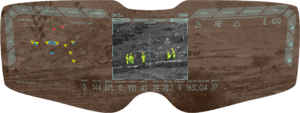
For more details on the composition of the functionality of each stage, see here.
a. Situational Awareness
- digital zoom
- rear view
- night vision (passive only terrain perception, with no IR source visible to others)
- thermal image vision (ambient and object temperature monitoring)
- no-visibility navigation (LiDAR and sensors)
- mixed vision (HD / IR cam + thermal image cam + LiDAR / sonar dots map, silhouette highlighting)
- stereo camera and measurement
- drone, robot, and external cameras view (other viewpoints, other users' camera view, digital aiming device camera view)
- friend-or-foe identification (incl. 360° navigation grid)
- radio direction finding system or RDF (allows you to detect the coordinates of radio transmitting sources, and identify them)
- vitals body sensors data (oxygen level, heart rate, body temperature, hydration level sensors data-driven monitoring; also another users data view)
- key monitor indicators and images before the eyes
- detection of booby traps (tripwires, radio, infrared), pressure mines
-
RGB camera image
-
Thermal image
-
Detections
b. Communication
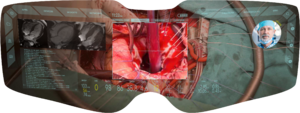
- one-to-many communication (merging communication channels, text and voice chat online full duplex without pushing the tangent - UHF / VHF, Bluetooth, WLAN or Wi-Fi (IEEE 802.11) / Wi-Fi Direct (p2p), LTE / 5G, SatCom Ka / Ku / V)
- voice, text, icons, and images (silent multichannel digital communications, the ability to instantly communicate using icons following the example of road signs and gestures of tactical groups)
- speech-to-text
- Software Defined Radio (significantly less traffic and interference, shorter sessions, higher quality and security, broadband signal transmission - one-to-many communication, compatible with analog radio transmitting devices, shows the entire radio air panorama in a given location, analyzes the spectrum, identifies weak signals and radio interference sources - ISR function, recording radio intercepts due to fast ADC)
- videoconferencing
c. Navigation
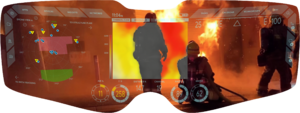
- maps and mapping
- compass
- route planning and path tracking (Artificial Intelligence)
- geolocation position exchange (own, friend, and enemy positions, incl. Cross-Domain Interaction)
- auto-tracking of own positions and execution of tasks (Artificial Intelligence)
- connectivity with ATAK-MIL system
d. Firing Assistance
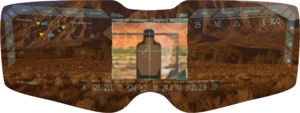
- targets auto-capture and tracking (target lock & track, target detection)
- ballistic calculation (instant evaluation of external factors, distance, angle, satellite weather data, and multiple modes of aiming correction)
- speed measurement and calculation of preemptive
- instant aiming (integration with the digital and laser aiming devices, accurate shooting with both eyes open)
- target hit tracking and corrections
- easy access to shot history
- shooter's field of view and especially peripheral areas are not obstructed by the scope;
e. Detection
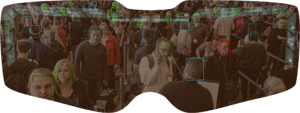
- passive radar detection
- external active phased radar connection (remote mobile radar, UAV equipped with radar)
- capture of enemy fire positions and missile launch positions (direct and indirect fire positions)
- motion and flashes detection
- missile engines heat & smoke traces
- face and object recognition
- emotion assessment;
- ambient sound filter (noise filtering and threat detection; UAVs, helicopters, engine sound, human speech identification; direct and reflected sound waves identification; determining the direction in which to search for the sound source)
f. Task management

- task control and checklists (ongoing, set by me, assisting, following)
- video and image recording, proof of completion
- task delegation and status monitoring
- reporting and auto-tracking
- connectivity with C4I systems and Battle Management Systems (electronic warfare systems, C4ISR / C5ISR: Elbit Systems, Rheinmetall, Leonardo, Lockheed Martin etc.)
- distributed p2p computing when running neural networks for complex AI, CV tasks (integrating the resources of tens and hundreds of users)
- real-time access to library and reference materials
- patient records and diagnostic cards (EHR integration)
g. Live-synthetic training environment (L-STE)
- connectivity with STE One World Terrain (OWT)
- mission preparation, mission rehearsal, mission analysis, mission debriefing
- C4I training (Cross-Domain Interaction, coordinating ground maneuver with fast air)
- training courses for the C4I staff with varied and customizable training paths
- support to functional and operational integration of heterogeneous tools (experienced tank training simulators, VR tank and combat vehicle simulators + camera mounted on a robot, flight simulators etc.)
- training and expert certification
| "Current Virtual Training | Future Training (STE) | |
| * unrealistic: sterile, predictable and contrived; | * realistic terrain, effects and interaction; | |
| * lacks dynamism; | * dynamic, trains problem-solving and mission command; | |
| * does not simulate human interaction; | * simulates human interaction and population dynamics; | |
| * poor data collection; | * collects and analyzes vast quantities of data; | |
| * does not train cross-domain convergence; | * enables multi-domain training; | |
| * systems are outdated and not interoperable; | * all systems are interoperable; | |
| * difficult to access, facility-specific, long wait times; and | * available at the point of need; and | |
| * 4–6 months to set up, inconsistently compatible formats. | * immediate simulations of any terrain through One World Terrain."[10][11] |
-
U.S. Army testing STE platforms
-
U.S. Army testing STE platforms
-
U.S. Army testing STE platforms
The project is in the prototyping stage. However, we have been engaged in Customer Development for a long time. Our primary focus has been on Problem-Solution Fit validation. To date, we have confirmation of interest from Army xTechSearch'6 U.S. DoD; Defense Innovation Unit, U.S. DoD; DARPA DSO; Lockheed Martin Co. VTC Systems; Planungsamt der Bundeswehr. We continue to build future relationships with military technology corporations, defense innovation agencies and laboratories of NATO and Israel defense departments, and collaborations with other defense startups. To date, we have not received any rejections of interaction due to the irrelevance of the problem being solved or the unsuitability of our proposed solution. We expect the conversion rate to be in the range of 15-25% once we are able to offer the MMP by successfully completing field tests.
At this point, the behavior of representatives of military-technical corporations, with whom we are trying to build future relationships for the collaboration and promotion of the product, is expected. We are making a fair amount of effort and are in direct contact with competent experts in the area. The conversion of cold leads to warm ones is also in line with our expectations. We have all the tools for effective communication. We are constantly working on improving the content in order to win the competition for the attention of experts.
Our main advantage is that we make a product that meets the needs of users much better, has more prospects for expanding functionality and costs at least 30% less than Microsoft IVAS and L3Harris ENVG-B.
A little above in the question "Compared to your competition, how do you compete with respect to price, features, and performance?" we detail the differences in features and price.
What is it that we are doing that is new or different, that is game-changing? Why are we not a “me-too” company or a “them plus feature (or feature feature feature bar)”? How do we substantively shift the competitive advantage so far into our court that others don't even have the right tools to play, or change the nature of the game altogether?
We came up with a way to combine fantastic features in one device and saw the direction that defense and security technology was heading. The idea of going to the moon was thought of long before Jules Verne, but the rocket wasn't built until technology caught up with the idea. We saw exactly how a device and software could be created today so that this line of products would solve long ripe defense and security problems. We were not at all intimidated by the notion that it would be impossible to break through the armor of bureaucracy and conservative attitudes. We saw the potential market two years ago. It is huge. And now, after a sequence of black swans, the world is again paying a lot of attention to security issues. Public attitudes are changing before our eyes. In Germany, for example, there used to be a perception that there were no threats to the defense forces and the budget was minimal and defense innovation was unpopular. But the year 2022 changed that. An advantage over the enemy in military confrontation, an advantage over threats in police and security services, an advantage over man-made and climatic disasters - this is what civilization needs now to survive. This is already undeniable. The advantages are being realized in different ways. Some have already been exhausted.
When asked about comparing our product to competitors, we answer on a guesswork basis. Because no one else in the world today has such a product. We have an opportunity to be the first. Just as engineers were once the first to put a man on the moon.
In our strategy and its part, which is presented in the roadmap, the following product development milestones: MVP Alpha, MVP Beta, MMP Gamma, MMP Delta. In the question about the steps in the evolution of the product, we disclosed this topic in more detail.
Development milestones:
Step 1. Problem primary research. Scientific research. Basic principles observed and reported.
Step 2. Invention begins. Technology concept and application formulated.
Step 3. Active R&D is initiated. Analytical and experimental critical function and characteristic proof of concept.
Step 4. CAD finished. Component and breadboard validation in a laboratory environment. Problem-Solution Fit is sufficient.
Step 5. Component and breadboard validation in a relevant environment. Collaboration research and Networking.
- - - our current level - - - >
Step 6. System and subsystem model and prototype demonstration in a relevant environment. Acceleration program. Pre-seed round.
Step 7. System prototype demonstration in an operational environment. Product lab tests. Сlarification of the patent claims.
Step 8. Actual system completed and qualified through tests and demonstrations. U.S. Army and Marine Corps tested the product on the proving ground.
Step 9. Actual system proven through successful mission operations. Start of pilot implementation. Seed round.
The product is so different, that's what we're talking about here, that I'd rather tell you how it's similar to the competitors' products.
1. IVAS
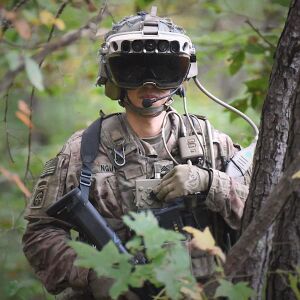
With Microsoft's IVAS - HoloLense product, our product combines only a few characteristics and features: weight, any augmented reality features (which are implemented differently, optically and electronically), hand tracking, voice control. The product promises map and positioning features, STE training features, and digital aiming device FWS-I integration.[12][13] But these features are also implemented differently, from the interface and graphical view to the resource requirements of the device. Therefore, the architecture, electronic component composition, interface, and software capabilities are very different.
Key differences
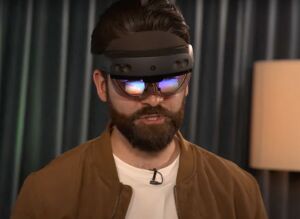
Unsuitable technology. IVAS uses holographic optics when a light wave arrives at the border of the medium separation between the lens and the air above a critical angle, causing the effect of multiple total internal reflections between the front and back surfaces of the lens and fluorescence in the lens glass, which emits light in all directions. Therefore, IVAS uses thick internal lenses that glow in the dark, which is a major deficiency for defense and security use, making servicemen an excellent target for enemy snipers. To reduce this disadvantage, the IVAS uses an external tinted visor lens, which is also critical for the user in the dark, he loses situational awareness. This once again confirms the fact that the HoloLense 2-based IVAS was not originally designed for military use, but was created for educational and entertainment purposes:
-
CAE’s augmented reality solutions transform healthcare education and training.
-
GIGXR is an immersive learning platform for medical and nursing schools, healthcare and enterprise globally.
-
The FDA-cleared SurgicalAR™ platform empowers surgeons with holographic navigation to transform procedural safety.
-
The Augmented Reality Anatomy Lab and Learning Platform.
-
RemoteSpark is an industrial augmented reality tool for remote support.
-
PTC solutions for industrial manufacturers are world class.
-
Trimble Connect bridges your 3D content from the screen to the construction site.
-
Hevolus solutions transform the buying process into an engaging and emotionally rewarding experience.
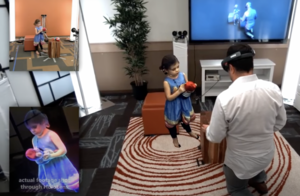
The displays on the HoloLens 2 are simple waveguide displays with a fixed focus of about two meters (6.5 feet). Because of the fixed focus, the displays exhibit Vergence-accommodation conflict, which is an unpleasant visual experience for the viewer.
Diffraction waveguides greatly affect the quality of the image. Let's say your enemy soldier is red and your friend is green. And you see pink... And you don't understand which color is distorted red or green.
Problem of dimming areas of the screen. IVAS, HoloLense 1 and 2, and other manufacturers of AR / MR / XR glasses and masks today have not solved the very important problem of dimming part of the screen. The fact is that the user sees a reflection of light rays or a fluorescent glow (holographic image) generated by the primary waveguide effect of light. But such glasses and masks cannot display dark areas. Because of this, a contrast image in daylight without artificial dimming is impossible. And artificial dimming, however, excludes situational awareness of the surrounding space. The user views the darkest parts of the image simply as background areas, no darker than the background. In its promos, Microsoft deliberately misinforms its audience by showing holograms with opaque black or other dark colors that are darker than the background. Therefore, this technology falls under the limitation for use during daylight hours. With our ARHUDFM product, we have found an elegant solution to the problem of dimming to display (parts of the screen) contrasting images during the day and in artificial light, so that the user can constantly view their surroundings without degradation, even in bright sunlight. For example, thermal images or video from a digital spotting device, drone, robot, other users' cameras, or cameras mounted on armored vehicles.
Insufficient field of view. IVAS has a lower FOV (80°h 28°v) than the ARHUDFM product (105°h and 33°v) or compared to normal optics. What does this mean? With a low FOV, you won't be able to distinguish small areas and details in the image. You will be very uncomfortable using the digital aiming device. After all, when you look through the eyepiece of a normal optical sight you view at least 60°h 60°v, i.e. together with the IVAS you don't see about half of it.

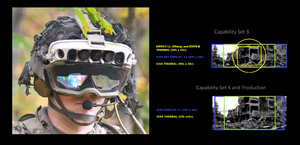
IVAS uses an LCoS projection module, while we use DLP. Both technologies are interesting:
| LCoS | DLP |
|---|---|
| LCoS can be used to control the phase of light in each pixel for beam control, so it is used by all holographic display manufacturers for AR. The LCoS can have a more compact size. You could say that HoloLense has no choice. | ARHUDFM does not use holographic optics, so with DLP it can display smoother (at 1080p FHD, 2K, 4K, 9K resolution) images without jitter, perfect geometry and superior grayscale linearity, higher contrast, wider color gamut, up to 35 trillion colors (the human eye can detect about 16 million colors). |
| LCoS chips are more resistant to high-power radiation than DLP matrixes because all elements are placed on a cooling pad. However, the loss of luminous flux in LCoS is higher than in DLP. Because of this, more powerful LED and laser sources are used. More power consumption and more cooling is required. | DLP pico projectors can emit light of more than 50 Lm, but such power in an AR devices is not required, and the index of loss of luminous flux is lower. Lower power consumption and more efficient cooling in compact sealed housing. |
| The LCoS uses a polarized light wave like many 3D glasses. During prolonged use, it causes increased fatigue, just like LED screens on computers, phones, and TVs. | With DLP, the light of the projected image is not polarized as such. |
| The distance between matrix elements is several tens of micrometers and the fill factor (the ratio of the total working area of pixels to the total matrix area) in LCoS is lower than in DLP. | In DLP projectors, images are created by microscopically small mirrors placed in a matrix on a semiconductor chip known as a digital micromirror device (DMD). These mirrors are so small that the pixel pitch of a DMD can be 5.4 µm or smaller. Each mirror corresponds to one or more pixels of the projected image. |
| LCoS is the third most popular technology after DLP and 3LCD (LCD), but has a much smaller market share, is close to 3LCD, but unlike the latter, uses reflective rather than translucent LCD matrices. LCoS creates images using a fixed mirror attached to the surface of the chip and uses an LCD matrix to control how much light is reflected. LCoS projectors today use mostly three-chip circuits based on monochrome LCoS matrixes since sequential matrixes have very low contrast. HoloLens 2 uses two Field Sequential Color (FSC) LCoS microdisplays from Himax. | DLP is a chipset based on optical microelectromechanical technology (MEMS) that uses a digital micro-mirror device. It is also used in about 85% of digital cinema projections (including IMAX, and RealD) and in additive manufacturing as a light source in some 3D printers for curing resins into solid three-dimensional objects. ARHUDFM uses a single microdisplay manufactured by Texas Instruments. |
| LCoS are more expensive. | DLP has a lower price and makes the final product cheaper. |
Lens fogging problem. Another disadvantage is the problem of fogging of the lenses. The fogging effect occurs even when the air temperature outside drops slightly. It is enough +5-10°C (41-50°F). No matter what translucent material the lens and visor are made of (glass, polycarbonate, polyurethane, etc.), when moving from a cooler state to a warmer one, condensation appears on the surface, as the lens material has temperature inertia and in conditions of contrast of lens and air temperatures, a dew point is formed on the lens surface. This appears in the following cases:
- Rapid temperature changes. In the fall, winter, and spring, the temperature in any room is warmer than outside. When you go indoors from the street, the cold lenses meet the warm air. Water vapor from the warm air settles on the surface of the cold lenses in the form of small droplets. Condensation forms.
- The lenses fog up on their own. When you are out in the cold, the lenses become cold and the warm air that you exhale rises up. Again there is a temperature difference and fogging occurs.
- Fog. When humidity is high, condensation will form on the lenses not only indoors, but even outdoors.
Chemical agents against lens fogging have little effect. Our product solves this problem by sealing the inner lens from the outer lens and by sealing around the face contour when using the lower part of the mask.
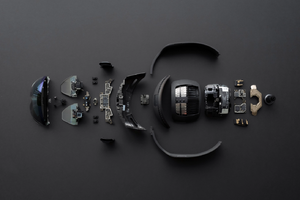
High power consumption and insufficient battery capacity. The IVAS electronics based on a single board computer SoC Qualcomm Snapdragon 850; HPU; RAM 4Gb LPDDR4x system DRAM; 64 Gb flash; WLAN 802.11ac; Bluetooth 5; is one of the most performant for compact devices today, but also more expensive than the one we use in our device. IVAS uses 7 cameras vs. 4 cameras in our product and a higher performance GPU. This significantly increases the power consumption of the system components. And with the IVAS's lower battery capacity and higher power consumption, the claimed battery life is 7-8 hours (it was 2-3 hours in tests), which is critically low for defense and security use. Microsoft offers a simple solution, with 3 interchangeable batteries included. However, in order for the user to replace the battery, he has to perform several actions: take off the mask and gloves, take off the backpack, open it and take out the replacement battery, turn off the device, open the lid of the mask housing, remove the battery from the device, insert a fresh battery, turn on the device, put the battery in the backpack, close it and put it back on, put on the mask. As you can see, it's not quick. But that's not the problem. The battery can run out at a very unsuitable time, the IVAS will just turn off and become an obstacle. It could also be raining or snowing and you can't allow moisture to get inside the electronic device. It may be dark and you can't quickly change the battery, unlike a quick magazine change of a firearm, which can be done by feel. With the ARHUDFM mask, we have thought of this and the non-removable battery capacity is 16.8V battery 16500mAh / 277wh, which is equivalent to a lifetime of over 7 hours. And in special cases, when you want to increase the continuous life of the device, the user can connect the power bank (4x12, max 48pcs LiMgCoAl 26650 3.7V 5500mah, ~ 1,065.6wh, 9.9 lbs / 4.6 kg) from the backpack without removing it, but only by reaching into the pocket and inserting the cable into the connector on the back of the mask.
Passive cooling problem. Another problem is the cooling of electronic components inside a sealed case, especially the processor (CPU), the graphics processing unit (HPU), the RAM chips, and the battery. Air cooling breaks the seal and moisture and dust can enter. Air cooling is not possible with sealed designs. Liquid cooling is not possible for wearable compact devices. Using aluminum for the outer casing of a wearable device is ineffective because the casing will be heated by direct sunlight to the point where the processor protection kicks in and the processor starts to decelerate until it shuts down completely. IVAS has passive cooling (no fans), i.e. containing one or more of these disadvantages simultaneously, which is a critical problem for defense and security applications.
Problem of fatigue and increased strain on the cervical spine. The IVAS has a mass of 2.5 lbs (expected to go down to 1.8 lbs). This does not seem to be much for an adult and sturdy person. But the center of mass protrudes forward several inches. This creates torque, which was noted during tests at the Soldier Lethality Cross-Functional Team, based at Fort Benning, GA. According to military experts, weight reduction is desirable, but not critical. But the generated torque is a serious disadvantage. For example, in used night vision devices, there is also a high torque (the weight of the device is about the same), but when the device is not in use, it can be folded upwards and almost completely get rid of this negative effect. With our ARHUDFM, the center of mass is centered around the head, so the torque is not felt, despite the comparable mass of the device.
Problem with lack of multimedia. Microsoft HoloLens 1 and 2 and IVAS do not include an audio headset. U.S. Army personnel are pictured during field tests using headsets from other manufacturers that are compatible with the ballistic helmet. On the one hand, this does not allow for the integration of video and audio. On the other hand, it is a predetermined limitation for future functionality development. After all, combining multimedia with Software Defined Radio and next-generation networks, speech-to-text technology and one-to-many written/symbol communications with high quality and with short sessions opens up disruptive capabilities for every serviceman. We discuss the communications challenges and challenges for Cross-Domain Interaction in more detail here.
Problem of hanging wires. The IVAS has a remote calculation module with a joystick for control (Puck). This module is connected by a thick cable directly to the helmet (Puck-to-HUD cable). The digital sight camera and the external power supply are also connected to the Puck module. The fourth cable goes from the headset to the portable handheld radio via a pluggable remote tangent. The fifth cable goes from the portable handheld radio to the external antenna. Most of the cables are looped, fixed, and go in the front between the pockets for the spare magazines of ammunition and grenades. This is fine for blog photos, but not acceptable in practice. A serviceman with that many wires and loops of them will absolutely get caught when getting in and out of an armored vehicle (and it should take no more than 8 seconds for 8-12 people to do so). Also, the trooper will not be able to crawl and rotate while lying down. Hanging cables will be in the way when troops are wading through trees and bushes. Finally, cable loops could create a dangerous situation when changing a magazine or retrieving a grenade. In our ARHUDFM product, we do not use external cables, all modules are compactly located inside the mask housing. Even the Software Defined Radio module is integrated. The exceptions are the external antenna, the flexible drinking system pipe, and the flexible compressed air container pipe (for firefighters). However, the route of these communications runs mostly on the back and does not require hanging loops. Other devices may be connected (optionally), but these connections, too, will not critically disturb crawling, shooting in the supine position, and the safe use of ammunition in the front chest pockets.
Problem of price and budget's willingness to pay it. Based on the published information about the DoD and Microsoft contract, the price of one set of devices is more than $55,000. This is more than twice as much as the thermal imaging night vision devices used today. And it is more than 5 times the LTV (live-time value) per ARHUDFM user. Initially, it was announced that Microsoft had a contract amount of $21.88 BN.[14] It's not immediately clear when the Army, as well as the U.S. Marine Corps and elements of U.S. Special Operations Command, might expect to reach an initial operational capability with the IVAS system. The service says that there is still further test and evaluation to be done even after signing this new contract. Future budgets could have an impact on the project, as well. Congress notably trimmed $230 million from IVAS's research and development in the National Defense Authorize Act (NDAA), which was passed and signed into law earlier this year.[15] Tech companies are preparing to jump into the US Army’s IVAS Next competition after receiving briefings from the service about a decision to recompete the prime contractor position on its futuristic mix-reality goggles, according to multiple sources.[16]
Upcoming IVAS perspectives
US Army leadership does not want to buy additional Enhanced Night Vision Goggle-Binocular (ENVG-B) in 2023 but does plan to acquire Microsoft's militarised HoloLens 2 augmented reality (AR) system if technical problems have been fixed, service officials told reporters on 29 March. The army's fiscal year (FY) 2023 budget request includes $424M to buy “night-vision devices” next year, with $400M from that pot earmarked to purchase 7,272 Integrated Visual Augmentation Systems (IVASs), according to Brigadier General Michael McCurry, the director of force development, and a subsequent email to reporters. Based on these numbers, each IVAS unit will cost the army just over $55,000, a sharp increase over the FY 2022 per unit cost of $25,490 (ENVG-B).
Next year’s IVAS procurement plan is significantly less than the $854M army leadership requested to spend on buying the heads-up display in 2022. This 2022 request was made before the service postponed fielding the devices due to software and hardware problems. Lawmakers, in turn, cut $394M from the IVAS procurement coffer. Since the Pentagon has not released its budget justification documents, which are anticipated to include five-year spending plans, it is not clear when the army intends to ramp up IVAS procurement spending. The FY 2023 request also includes $64.6M to develop the next IVAS prototype and buy 270 units of this “1.2 version” for testing and development, the army told reporters on 30 March.[17]
This is a full video of the IVAS presentation on Dec. 21. 2021 by IVAS Technical Director Jason Regnier. A detailed breakdown can be found at the following link:
- 6:12 The IVAS operating system does not support running the ATAK navigation application
- 18:00 IVAS does not use eye-tracking to control the focal length, all of the controls are done through the buttons on the Puck
- 24:10 Negative feedback came on the Puck-to-HUD cable. Jason Regnier, Technical Director of the IVAS program, states that they are working on ways to better secure it
- 27:00 IVAS goggles under exertion would fog up and the soldiers would take them off
- 29:31 the system will not be cleared for parachute drops and must be taken off
- 30:00 primary restriction on working on the other battle drills was the outdoor performance of the display
- 34:20 they were aware of display issues going into testing, but they 'were not sure just how bad it was', there were 'dark spots' in the display and they were too much, resulting in them halting the test
- 36:00 they have no plans to move to a wireless headset HUD-Puck connector, as there is just 'a lot of information that has to come down' and power has to be run to the headset via cable anyways.
The US Army is taking delivery of a first batch of high-tech combat goggles made by Microsoft Corp., citing encouraging results from testing in the field. Assistant Secretary for Acquisition Douglas Bush has “cleared the Army to begin accepting” some of the 5,000 sets of goggles, spokesman Jamal Beck said in a statement. Their delivery had been placed on hold over concern about the device’s performance until more rigorous testing took place. Based on the test results so far the service “is adjusting its fielding plan to allow for time to correct deficiencies and also field to units that are focused on training activities,” Beck said.[18]
2. ENVG-B
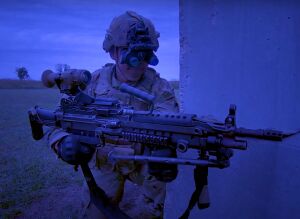
This is the new networked night vision system from L3Harris Technologies. Soldiers get real-time, actionable intelligence through the fusion of Image Intensified (I2) white phosphor tubes and thermal imaging. Soldiers keep eyes on target without having to look down to read maps or check radios for critical information. Soldiers can see around corners without risk of exposure
Allows soldiers to identify, assess and engage targets with greater accuracy and speed.
Man-sized target recognition (upright moving man):
- 90% probability at 50 meters in limited visibility (such as fog, salt fog, haze, mist, snow, dust, smoke, and other battlefield obscurants like white phosphorous (WP), hexachloro-ethane-zinc oxide (HC))
- 80% probability at 150 meters (threshold) and 300 meters (objective)
- 50% probability at 300 meters (threshold) and 550 meters (objective)
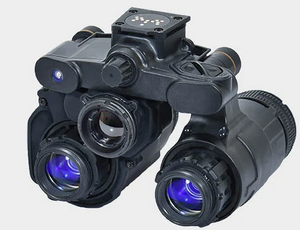
Total system characteristics:
- Weight 2.5 lbs (threshold) and 1.5 lbs (objective)
- Dimensions (L×H×W): 4.2” x 4.5”x 3.9” (goggle)
- Resolution (lp/mm): 75 lp/mm
- Tube form factor: 18mm
- Field of vision (FOV): 40°, thermal imaging cam 32°h 24°v
- System zoom: 3×
Operating hours (continuous fusion):
- Greater than 7.5 hours (threshold) and 15 hours (objective)
Multi-point wireless interface to FWS-I, NETT Warrior that supports information assurance requirements to provide RTA and AR capabilities, and Small Tactical Optical Rifle-Mount (STORM), Laser Target Locator Module (LTLM), Joint Effects Targeting System (JETS), Lightweight Laser Designator Rangefinder (LLDR) or other laser range finders, which provide targeting information.[19]
Key differences
Has limitations for use in daylight hours. This is the Army’s first heads-up display that is both day and night capable, fusing white phosphor and thermal vision at the push of a button. Provides the capability to engage and execute close combat, combat support, and combat service support operations in very low-light (starlight) conditions. ENVG-B allows the individual Soldier to see, understand, and act first during all limited visibility conditions. The goggles combine the visual detail in low-light conditions that is provided by image intensification coupled with the thermal sensor’s ability to see through fog, dust, and smoke. This thermal capability makes ENVG-B useful during the day as well as at night, unlike earlier night vision devices. Higher resolution stereoscopic displays (1280x1024, SXGA) allow for faster target acquisition by improving separation of targets from background, for maps and information overlay. Additionally, ENVG-B will receive wirelessly transmitted weapon sight crosshair and thermal imagery from the Family of Weapon Sights-Individual; thus, providing a Rapid Target Acquisition capability that enables Soldiers to detect, recognize, and engage targets accurately from any carry position and with significantly reduced exposure to enemy fire. The ENVG-B is also interoperable with Nett Warrior through wireless transmission of Augmented Reality to improve the Soldier’s situational awareness.
The ENVG-B POR is a helmet-mounted individual night vision device that has an integrated long-wave infrared (LWIR) thermal sensor and white phosphor dual Image Intensification (I2) tubes. The fused I2 and thermal display can be used during low and high light levels, extreme weather, and with obscurants. The ENVG-B is interoperable with the Family of Weapon Sights-Individual (FWS-I) for a Rapid Target Acquisition (RTA) that provides the Soldier the ability to accurately engage targets without shouldering the weapon and execute offset shooting. ENVG-B operates on the Intra-Soldier Wireless (ISW) network with Nett Warrior (NW) allowing the Soldier to receive and display navigational, targeting, and situational graphics.
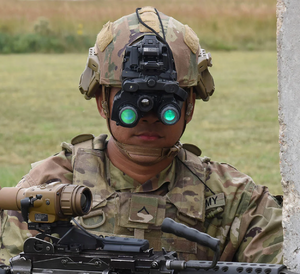
Insufficient field of view. FOV 40° will not allow you to distinguish details in the overall picture without zooming in, the 32°h 24°v thermal imaging camera FOV further limits your ability to view. And with optical zoom, there is a loss of situational awareness up close, especially in the peripheral vision zone to the right and left of the user. This creates significant vulnerabilities during tactical use.
In addition, the 3x zoom is insufficient for safe observation of the surroundings. This was probably a forced compromise or a technical limitation. Army binocular systems for the C4ISR are usually equipped with optics with 8-12x magnification. This also applies to observation posts and fire correctors.
From the practice of use, it is known that the insufficient field of view results in users using only one monocular instead of the binocular capabilities of the device, lifting the other one to the upper position. The advantage of binocular vision, for the sake of which the engineers developed this model, is not used at all. The disadvantage of the monocular has long been revealed in tests. It is difficult for a person to concentrate on information from one eye, while the other eye captures other images.
Problem of fatigue and increased strain on the cervical spine. High torque. Due to the significant shift of the center of mass of the device forward. In our opinion, this disadvantage is not different from the same problems with IVAS.
Network integration and software features. Wireless Network to deliver real-time video and target asset information within the goggle display which interfaces with the U.S. Army’s Nett Warrior programs.
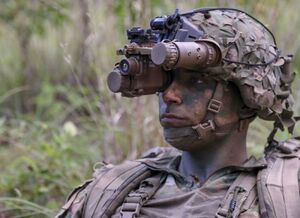
Problem of price and budget's willingness to pay it. Delivered more than 6100 ENVG-B systems to U.S. Army combat-ready divisions and brigades. Conducted more than a dozen soldier touchpoint events. Scheduled to deliver more than 10,000 systems by the end of 2021. Awarded $391 million sole source directed requirements contract in 2018. Awarded $12 million phase 1 program of record contract in 2019. Awarded $442 million Other Transaction Authority for the ENVG-B program of record in 2020.
US Army leadership does not want to buy additional Enhanced Night Vision Goggle-Binocular (ENVG-B) in 2023 but does plan to acquire Microsoft's militarised HoloLens 2 augmented reality (AR) system (IVAS) if technical problems have been fixed, service officials told reporters on 29 March.[17] Based on these numbers, each IVAS unit will cost the army just over USD55,000, a sharp increase over the FY 2022 per unit cost of USD25,490 (ENVG-B).
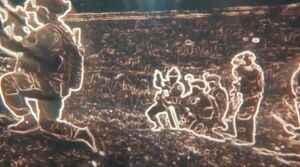
Upcoming ENVG-B perspectives
Disadvantages of the device are a very small field of view, strongly protruding dimensions and center of mass at the front, high torque, and dimensions in the folded state increase the risk of breakage when bumping into hard objects (e.g. when exiting an armored vehicle). Very limited area of use, mainly only for infantry and operational units in twilight and stellar lighting conditions ("unparalleled low-light night clarity").
The other version of the device BNVD is not significantly different from ENVG-B. L3Harris reports no contract information for this modification.
The ENVG-B is both an optical and a digital device. However, its digital capabilities are limited. Looking ahead, other fully digital devices (such as the ARHUDFM) with large bright contrast displays, a wide field of view, a high-performance computer module on board, and advanced sensors, as well as a large number of digital assistants using Computer Vision and Artificial Intelligence technologies, do not stand a chance of future interest in the ENVG-B.
The SBNVG model [20], similar in features, is being developed by the Israeli corporation Elbit Systems. Elbit Systems of America LLC was awarded a delivery order valued at approximately $49 million for the supply of night vision systems and various spare components to the U.S. Marine Corps. The order will be executed in Roanoke, Virginia, and will be supplied through March 2023. This order is part of a $600 million five-year Squad Binocular Night Vision Goggles Indefinite Delivery Indefinite Quantity (IDIQ) contract from September 6, 2019, under which the U.S. Marine Corps are supplied with Squad Binocular Night Vision Goggle (“SBNVG”) systems consisting of high-performance, white phosphor image intensifier binoculars, modular uncooled thermal imaging sensors, and common external power supplies – providing Marines improved mobility and situational awareness during night operations.[21] Later there was information that the execution of the contract was delayed by a year and will be supplied through September 2023.[22]
A similar device (ENVG III/ FWS-I night vision mobility and targeting system) was also developed by BAE Systems.
L3Harris is nervous about the future of ENVG-B military orders, so it has contracted with Vuzix to co-develop the AR device. L3Harris Technologies has signed an agreement with Vuzix Corporation to develop a customized waveguide-based optics engine that is intended to be used in headborne systems designed for military applications.[23]
3. SMASH Family
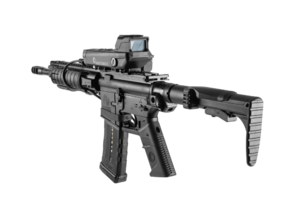
Smart Shooter [24][25][26][27][28][29] develops state-of-the-art Fire Control Systems for small arms that significantly increase weapon accuracy and lethality when engaging static and moving targets, on the ground and in the air, day and night. With proven “One Shot – One Hit” precision, our SMASH product line empowers defense and security forces by maximizing rifle effectiveness against enemy targets while minimizing friendly casualties and collateral damage. Based on Artificial Intelligence, Computer Vision and Machine Learning technologies, SMASH is also designed to interconnect with other operational resources to form a micro-tactical network that delivers real-time situational awareness.
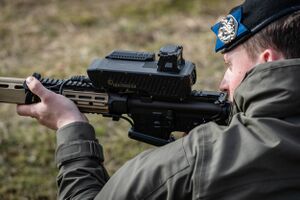
Main System Modes:
- Etched reticle mode / Aiming Dot - accurate reflex sight
- Day mode fire control assisted shots using see-through projected markers
- Night mode fire control assisted shots using low light video display
- Clip-On mode fire control assisted shots using night vision clip-on
Multi-Operational Use:
- Ground target elimination, static and dynamic targets up to 400 m (Day Mode)
- Small UAS kinetic elimination up to 250 m (Day Mode)
- Ground target elimination, static and dynamic targets up to 400 m (Night mode)
Main Components & Installation:
- Sighting Unit - mounts on existing MIL-STD-1913 rail
- Fire Block Mechanism (FBM) - incorporated in a replacement weapon grip (and trigger guard)
- Quick on-site installation
Magnification: X4 (X1 model 2000 and model 3000)
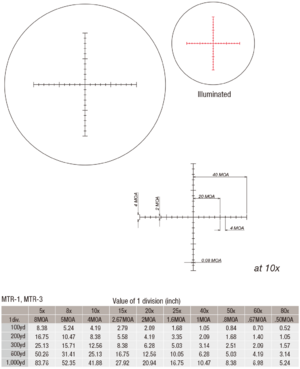
Supported Weapons: M4, AR15, SR25 (M110) Integral Fire Control Computer:
- Target lock & track
- Dynamically updated firing zone and synchronized shot
- User selection of different ballistics
- Compensation for wind, inclination, cant
- Enables future capabilities addition through software upgrades
Size (L x W x H):
- W/O LRF 206 mm X 89 mm X 83 mm
- W/ LRF 206 mm X 102 mm X 83 mm
Weight:
- W/O LRF 1120 g (Sight)
- W/ LRF 1250 g (Sight)
Power Source:
- Rechargeable Smart Lithium Ion battery pack
- 72 hours or up to 3600 SMASH-assisted shots
Laser Range: Finder Optional, up to 1000 m
MIL-STD Compliance: MIL-STD-810G, MIL-STD-461E
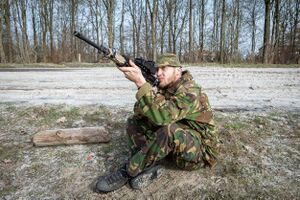
Lock & Track. Once locked onto the target, SMASH tracks its movements in sight - even through a crowd –helping improve user situational awareness, easing their mental load, and ensuring that when the time comes, the system will make that first shot count. Using the button on the barrel, the shooter "locks" the target. "The shot will be fired only when the system says that the shot is in the middle of the target."
Target Detection. Simple, intuitive controls on the weapon allow the users to select and confirm the target without moving their hands.
Drone Mode. Software built into the SMASH fire control system can recognize unmanned aerial vehicle targets, automatically track them and help shooters eliminate the threat.
Digital Zeroing. SMASH can be used to automatically 'zero' the weapon, minimizing training overhead for inexperienced shooters.
Key differences
Insufficient field of view. The small LCD screen relative to a person's general field of vision will not allow you to quickly recognize targets and threats (FOV 24°-6°). It will also illuminate your face in the dark.
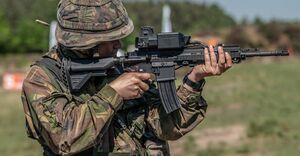
Optical magnification. The optical magnification is 1x for the 2000 and 3000 models and 4x for the X4. This is enough for most tactical applications up to 100 yd and 300 yd (4x). But if a target needs to be hit at 600 yards, or for snipers with a range of 900 yards or more, this device will not help them. Most military and police snipers work with 3-9x42 and 3-12x50 optics, more rarely 4-16x50, even more rarely 3.5-25x56, 4.5-27x56 and 7-35x56.
These days long sniper rifles come with a computer system in which you can put in the humidity, elevation, temperature, wind, spindrift, and even the Coriolis effect aka the “spin of the Earth” and make the adjustments to your scope/sights. So despite the exit pupil and brightness issues, shooters are demanding “more power” these days and the scope manufacturers are providing new products with ever-greater magnification levels. Right now, the most powerful conventional riflescope you can buy is the March X-Series 8-80x56mm scope! That means a massive 80x magnification range. However for what it’s worth when you firing at targets over 2000 meters (1.26 miles) with the best match grade ammo and a high-powered scope either .338 Lapua Magnum or .50 cal at that distance you are what they call “eyeballing” it to a certain degree and are not going to hit the target 9 out of 10 times. You may have a clear head shot of the enemy over 2000 meters away with your 80x magnification scope however it’s not that easy.
In the ARHUDFM device, we not only use a complex algorithm of ballistic calculations according to 12+ parameters but also Machine Learning based on the history of shots in a given area under similar conditions, including by other shooters. We use Computer Vision technology to track the point of impact, as well as to make the image as clear as possible for the shooter at high magnification (24x), to correct for climatic variables such as mirage. Subtensions are measured in MIL/MOA and remain constant at all magnifications (the number of MOA units within one division decreases according to the ratio of magnification; 1 subdivision at 10x magnification equals 4MOA, at 20x equals 2MOA, at 40x equals 1MOA). And, of course, we've thought about the shooter's user experience itself. The shooter sees the image from the stereo camera of the mask along with the reticle, as well as the point of sight line. If the digital aiming device allows, corrective adjustments (MOA) are made automatically after the target has been captured. Or the user sees the calculated values in MOA and in the number of clicks for the specified reticle for the specified magnification. If the sight line is outside the view area boundary, the system tells him which way to move it and how far (important at high magnification). After the test shot, the shooter sees the corrective adjustments on the same screen and can immediately fire again, which is very important for a moving target. Some shooters do this "by eye", and some lose time by making additional corrective adjustments to the scope. The ARHUDFM shows the necessary correction deviation instantly. The shooter must not lose sight of the target by keeping it in the field of view of the stereo camera at all times. The shooter also does not lose visual situational awareness around him, including peripheral vision and rear view, and does not need to cover one eye. This shooting technique is much easier and faster. In addition, there is no need for a second number, a spotter. And the shooter does not become vulnerable during aiming and firing.
The calibrated digital aiming device's spatial gyroscope and the other two sensors must be used to accurately match the sighting line to the camera image of the mask. The mathematical values of the sighting line are transmitted to the computing module of the mask. The aiming algorithm itself sets the necessary corrections and changes the displayed sighting line in the view from the mask cameras (a circle with a crosshair on the outside). We want to highlight that ARHUDFM uses a mathematical way of matching the sighting line and the reticle of the mask, not a graphic "by eye" one like in ENVG-B. The digital zoom uses a 4K, 9K, or 12K stereo camera and the Computer Vision algorithm for pixel smoothing with outline extraction.
After each shot, two modes are used after analysis of the impact point:
- the sighting line is not readjusted, but the necessary corrections are displayed on the reticle of the mask camera view (for experienced shooters)
- the sighting line is readjusted each time and the shooter aligns the sighting line with the crosshairs of the reticle of the mask camera view
The image quality of the sighting camera (FWS-I characteristics) is usually not very good (640x480Vox, 1x FOV 18°h 13.5v°, 3x FOV 6°h 4.5°v, monochrome BW display, BW dot), including those using a thermal imaging module, only relevant for close-in cover fire (up to 100 yards) when the mask cameras are not used. In the case of aiming by the view from the sight camera, corrective adjustments must be made to the aiming device itself.
In ARHUDFM we do not use laser and infrared sources so as not to de-mask the shooter's firing position. Measurement of distance, course, angular velocity and angular elevation of the target (SLH) above the true horizon is performed by a stereo camera, gyroscope, accelerometer, and magnetometer with high accuracy during day and night.
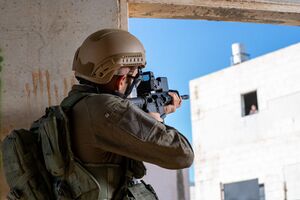
Laser Range Finder. An optional integrated Laser Range Finder (LRF) enables range measurement both as a user-initiated capability as well as a system input for improved precision. In our opinion, the use of laser rangefinders is dangerous because it de-masks (exposes) the firing position to the enemy using a thermal imaging camera. In the ARHUDFM the measurements are taken with a stereo camera and at night with a thermal imaging camera. See more on the ARHUDFM Features Summary page.
Limitations on use. Limitation on the types of small arms used. Not applicable to other types of ballistic weapons: machine guns, grenade launchers, mortars, and artillery guns.
Upcoming SMASH perspectives
In our opinion, this is a very promising development, despite its limitations. It offers connectivity with C4I systems, Battle Management Systems, and external sensors. Smart Shooter approves that it has completed the delivery of thousands of additional SMASH systems for the IDF and other customers during 2021, the company writes. The price of one set of devices is more than $4,500. Defense agencies in the United States, Netherlands, and Austria purchased the first SMASH systems in 2022.[30]
4. RED 6
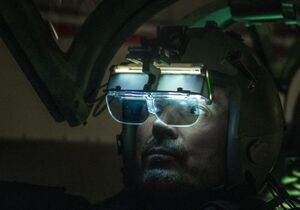
Problem. The United States Air Force is at its lowest state of readiness in twenty-five years. Currently, two thousand pilots short and with a requirement to double the number of training sorties by 2030, the current approach to training is in crisis. Air Dominance is not our pre-ordained right, it is hard earned only by providing our warfighters with the finest equipment and finest training available anywhere in the world. Right now, we don’t have budgets, the assets, or people to win. We must do something differently.
Solution. Red 6 has developed Airborne Tactical Augmented Reality System (ATARS) a revolutionary approach to Augmented Reality (AR) that now enables it to work outdoors and critically, in high speed, dynamic environments. This technological breakthrough enables a new paradigm in air combat training, unleashing the full potential of Live, Virtual and Constructive (LVC) training by bringing the V and the C assets into the real world, facilitating within visual range maneuvering against synthetic threats.
Value. Increasing readiness and lethality, while driving value and efficiency, ATARS provides a dedicated Red Air training resource to every squadron, allowing unlimited, synthetic training against near-peer adversaries. This reduces the training burden on squadron personnel and aircraft, and allows finite resources to be focused on executing the mission at hand. Furthermore, by providing training optionality to commanders across the joint environment, ATARS is a technology that will scale to support Multi-Domain Operations.
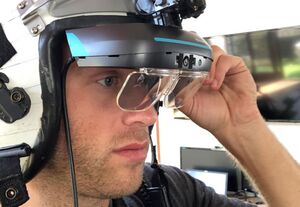
Red 6 has announced that it has received a strategic investment from Lockheed Martin Ventures, the strategic investment arm of aerospace and defense company Lockheed Martin Corporation. The company did not disclose the total investment amount, although stated that the funds will be used to accelerate the development and commercialization of Red 6’s ATARS (Airborne Tactical Augmented Reality System). Lockheed Martin states that it has been working on the development of the AR device on its own for more than 5 years. However, there are no publications and no confirmation of this. Chris Moran, Executive Director and General Manager of Lockheed Martin Ventures, commented: “Our charter is to strategically invest in smaller companies focused on innovative technologies that can be utilized within Lockheed Martin’s existing businesses. Red 6 fits this mission”. Moran added, “We are excited to add Red 6 to our investment portfolio and look forward to working with their team and gaining access to their synthetic training capability that could be applied to both current and future platforms.” Red 6 states that its technology has received praise from the US Air Force and the company was also awarded a Small Business Innovation Research (SBIR) Phase III grant. Previous investors in the company include Moonshots Capital, Starburst Accelerator, and Irongate Capital Partners. [31]
This is an interesting promising but the narrowly focused project, There are no technical details. The rendering presented in the media is a rendering, not an actual view through the lens of the device.
5. Other military agencies and military-technical corporations
C5ISR CCDC (DEVCOM), DARPA, Elbit Systems, Airbus Defense have also mentioned AR device development projects over the years. But based on the illustrations, it looks like they are just simple computer graphics, not examples obtained during demonstration tests. Usually, as in the case of IVAS, the official defense media publishes at least scarce information to demonstrate that the program is not delayed but funded and there are interim results. At least sketches and non-working prototypes. But in this case, it is more likely that we are still talking about long-range plans and wishful thinking than the actual results of project development.
In our opinion, only the first four projects mentioned above are worthy of attention at this time. Most of all, of course, the IVAS project, because even with significant shortcomings it has funding and support in the DoD. But the dynamics of the project's development and the magnitude of its deficiencies leave great opportunities for other developers, primarily little-known startups. In our opinion, the key success factor, like in the case of SMASH, is to work without looking back at competitors' technology, but to develop our own technology from scratch, adapted to the needs of defense, security services, firefighters, emergency medicine, surgery, and dentistry. Understanding the User experience of the target audience itself prompts the necessary solutions from a number of known scientific methods, available electronic components, and materials.
IVAS predecessors, current solutions and trends
The development of tactical human systems improvement, mobile innovation tools C4ISR and Cross-Domain Interaction has been ongoing for many years. Among the most notable concepts and programs are the following:
6. Land Warrior (1989 - 2012)

Internationally, there are several similar development programs, these include IdZ (Germany), FIST (UK), Félin (France), Land 125 (Australia), MARKUS (Sweden), Soldato Futuro (Italy), IMESS (Switzerland), Projekt TYTAN (Poland), ACMS (Singapore). The program includes several subsystems:
- Weapons. It included the weapon itself, as well as components such as a daytime video sight, thermal sight, and MFL (multi-function laser), and allowed the soldier to shoot from around corners or behind the cover without actually exposing himself to enemy fire.
- Integrated helmet assembly. The Helmet Subsystem (HSS) combined a lightweight, advanced helmet with a computer and OLED display that provided a variety of information from digital maps and troop locations to a weapon-mounted video camera. This is what would allow the soldier to see (and shoot) from around the corner. The HSS also has a microphone and a headset.
- Protective clothing and equipment. The Interceptor Body Armor and Modular Lightweight Load-carrying Equipment (MOLLE) systems currently in service with the U.S. Army are in part the result of the Land Warrior program.
- Computer. A wearable computer based on the ARM processor core.
- Navigation. Using the Friend-Foe Identification System - IFF. The Navigation Subsystem (NSS) provided location information, it combines a GPS receiver and a path numbering module (DRM) that maintains an accurate location when the GPS signal becomes unavailable.
- Radio and data communication networks. Using SINCGARS gateway radios. Using an IEEE 802.11-based wireless network, a decentralized peer-to-peer network MANET. The network location data subsystem (CNRS) is based on EPLRS.
- Software system. The Land Warrior software system is based on a variant of the Linux operating system and has a modular open architecture for further improvement. The reliability of the recent Fort Benning test was extremely high. The Land Warrior software package contains six major scope and data software packages.
Land Warrior was the first U.S. Army soldier network system to be used in combat since the concept of networked soldiers originated in 1989. It was later deployed with the system in Afghanistan, and Land Warrior continued in use until spring 2012. The Army built on Land Warrior with the Ground Soldier System (GSS) as its successor, an advanced integrated situational awareness system for rushed soldiers that entered technological development in Feb. 2009. GSS Increment 1 was renamed Nett Warrior in June 2010.
7. Nett Warrior (2012 - present)
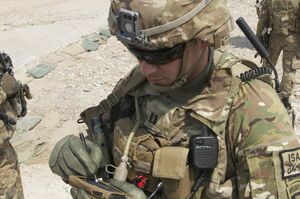
Nett Warrior (formerly known as the Ground Soldier System) followed the Land Warrior system. The system provides situational awareness (SA) to the dismounted leader with the aim of enabling faster and more accurate decisions in the tactical fight. The system includes navigation, SA, and information-sharing capabilities. The goal was to enable leaders to avoid fratricide and have increased effectiveness in the execution of their combat missions.
The NW program focused on the development of the SA system. This includes a digital, graphical display of the leader’s location on a digital geo-referenced map image along with Soldier and leader locations. The display is hands-free. The software connects through a secure radio to send and receive information from one NW to another, connecting the dismounted leader to the network. The radio also connected the equipped leader to higher echelon data and information products. Soldier position location information is provided via interoperability with the Army’s Rifleman Radio capability.
NW employs a system-of-systems approach, optimizing and integrating capabilities while reducing the Soldier’s combat load and logistical footprint.
Nett Warrior was being upgraded and tested to receive full-motion video streams from small unmanned ground vehicles and unmanned aerial vehicles.
Land Warrior allowed combat leaders to track the locations of their men and view maps and other tactical information through a small helmet-mounted computer screen, featured a microcomputer processor for storing maps, mission-specific imagery, and graphics, used a navigation system to track the subordinate leaders' positions which appeared as icons on a digital map, and had a digital voice and text radio to send e-mails and talk to others wearing the system.
The first increment of Nett Warrior was introduced at the Network Integration Evaluation 11.2 assessment in spring 2011. The system was essentially the Land Warrior ensemble with enhanced software, sharing its weight disadvantage of about 10 lb (4.5 kg). After NIE 11.2, efforts were redirected to using simpler and lighter commercial off-the-shelf (COTS) hand-held solutions that integrated a hand-held screen device with the Rifleman radio transport mechanism. The new design weighed less than 3 lb (1.4 kg) and participated in the NIE 12.1 assessment in November 2011. Nett Warrior is based on an “end-user device,” essentially an Android or iPhone-like smartphone tied to the Rifleman handheld radio, to link into command-and-control networks and use applications to call in fire support, plan and coordinate operations, and track friendly forces.
8. Android Team Awareness Kit (ATAK) (2014 - present)
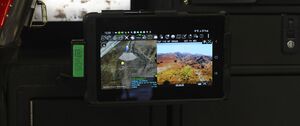
is an Android smartphone geospatial infrastructure and military situation awareness app. It allows for precision targeting, surrounding land formation intelligence, situational awareness, navigation, and data sharing. This Android app is a part of the larger TAK family of products.[1] ATAK has a plugin architecture that allows developers to add functionality. This extensible plugin architecture allows enhanced capabilities for specific mission sets (Direct Action, Combat Advising, Law Enforcement, Protection Operations, Border Security, Disaster Response, Off-grid Communications, Precision Mapping, and Geotagging). As of 2020, ATAK has a growing base of 250,000 military and civilian users across numerous public safety agencies and US partner nations and has seen the addition of 15 United States Department of Defense programs.
ATAK pulls data from a variety of sources and puts it all on one 3D map that teams can view on a mobile device and mark up as they go. In a wildfire, for example, aerial video from each UAV can be overlaid on this map, showing exactly where the fire is. As firefighters explore the terrain and discover new fires, they can add them to the map. They can also see dots representing the GPS location of other team members, trucks, and aircraft. Teams can even leave digital “breadcrumbs” to mark their path. When ground crews need aircraft to drop fire retardant foam, they can simply draw a line where they want the foam and send it to the aircraft crew. They can also add markers to indicate meeting points or refueling stations.
Summary
As can be seen, defense engineers and engineers at military-technical corporations have been developing mobile electronic assistant systems for members of various branches of the military, including maintenance personnel, for several decades. However, most of the failures of the past have been blamed on the mismatched technology of the time - performance, functionality, weight, and price. Nevertheless, defense engineers did not create their own products during this time but adapted proprietary and commercial technologies for their tasks, including mass-produced products such as smartphones and tablets. Dozens of military-technical and IT companies were involved in developing solutions. These approaches continue today. Microsoft, L3Harris, Lockheed Martin, Elbit Systems, BAE Systems, Raytheon, Rheinmetall, General Dynamics and other military technology corporations in the United States and worldwide. We believe there will be four to seven companies competing in this market in the future, as there are in other military and security contracting sectors.
Now, finally, technology has caught up with ideas. We can and are ready to offer our solutions for the military, police, public and private security forces, rescue workers, paramedics, and surgeons to the markets of several countries.
-
Furtherium
-
Microsoft IVAS
-
L3Harris
-
Elbit Systems
Studying the development experience of competitors and the characteristics of their products, we understood the following:
- the development speed of competitors is very low
- the results achieved do not meet the expectations of users
- strategic mistakes in the development do not allow to make a pivot, unlike development by a startup
- no developed product line with different modifications for different applications
- there is no flexibility to make changes and quickly make device and software upgrades
- outdated product promotion system and high price for the user
- outdated pricing system
Our development history also allows us to learn the following lessons for the future:
- expert opinions may be radically opposed for a new product and a new design, but both points of view can be wrong - a product hypothesis must be verified by its individual elements, not as a whole
- the most valuable thing in agile development is the fixation of all information, ideas, progress, references, technical parameters of each product version, each technology - in a convenient company's knowledge base
- there is no secret knowledge about consumer problems, even in the military or narrow fields such as firefighters, surgeons, rescue workers - the internet is full of articles, answers to all kinds of questions, forums of retired military and military instructors, where you can get the quintessence of valuable years of experience in real-life practical conditions, including combat missions in Iraq, Afghanistan, Syria
- it is impossible to be a little better than the competitors, it is necessary to be different and to correspond exclusively to the users' needs and the actual possibilities of science and technology
Here you can see the current design of our product.
In this section you will find a description of the software features of our product.
We have a product development plan for about three years. It includes the list of related features.
Recruiting
We plan to strengthen our team in the next 6 months by:
- Tech Lead, Software Engineering, DevOps
- Electronics Engineer
- Mechanical Engineer, CAM Engineer
- Optical Engineer
- Sr. Software Engineers
- Software Engineer and Testing
We expect to use some of these positions and other intellectual human resources on flexible terms, depending on need. We have experience and understanding of the sources of attracting strong professionals for our project.
We want to hire a team of 8 permanent employees within 6 months and 4 more on a contract flexible. Permanent staff costs will be $820,000. FTE for two of them are 0.3 and 0.5, the rest are 1. The cost for contractors will be $170,000. The FTE for one of them is 0.3, the rest 1. The average PPH values for the German market are taken as the equivalent. However, we also want to consider remote workers from Eastern European countries with lower hourly rates.
| budget item | FTE | PPH | Q1 2023 | Q2 2023 | Q3 2023 | Q4 2023 | Q1 2024 | Q2 2024 |
|---|---|---|---|---|---|---|---|---|
| Total | $110,000 | $140,000 | $180,000 | $180,000 | $180,000 | $180,000 | ||
| incl. staff units: | $107,000 | $126,000 | $146,000 | $146,000 | $146,000 | $146,000 | ||
| CTO / CEO | 1 | $49 | $30,000 | $30,000 | $30,000 | $30,000 | $30,000 | $30,000 |
| VP, Software Development | 0.3 | $49 | $9,000 | $9,000 | $9,000 | $9,000 | $9,000 | $9,000 |
| VP, Product Development | 1 | $49 | $30,000 | $30,000 | $30,000 | $30,000 | $30,000 | $30,000 |
| VP R&D, Business Developmet | 1 | $49 | $30,000 | $30,000 | $30,000 | $30,000 | $30,000 | $30,000 |
| Tech Lead, Software Engineering, DevOps | 1 | $30 | $0 | $19,000 | $19,000 | $19,000 | $19,000 | $19,000 |
| Sr. Electronics Engineer | 0.5 | $25 | $8,000 | $8,000 | $8,000 | $8,000 | $8,000 | $8,000 |
| Sr. Mechanical Engineer, CAM Engineer | 1 | $18 | $0 | $0 | $11,000 | $11,000 | $11,000 | $11,000 |
| Technician | 1 | $15 | $0 | $0 | $9,000 | $9,000 | $9,000 | $9,000 |
| incl. contractors: | $3,000 | $15,000 | $37,000 | $37,000 | $37,000 | $37,000 | ||
| Optical Engineer | 0.3 | $18 | $3,000 | $3,000 | $3,000 | $3,000 | $3,000 | $3,000 |
| Sr. Software Engineer | 1 | $20 | $0 | $12,000 | $12,000 | $12,000 | $12,000 | $12,000 |
| Sr. Software Engineer | 1 | $20 | $0 | $0 | $12,000 | $12,000 | $12,000 | $12,000 |
| Software Engineer (Testing Automation) | 1 | $16 | $0 | $0 | $10,000 | $10,000 | $10,000 | $10,000 |
Since personnel costs account for 55% of the total budget, we plan flexible management so that the resource can be increased and decreased as needed.
We don't have any employees right now. We are two co-founders and work on the project together.
Roadmap
Upcoming plans include:
- negotiations for one or two more technical co-founders to join
- acceleration program in Munich and mentor support
- further work on the prototype
- further search for expert opinions
- further networking and negotiations about collaboration
- publications in industry media
- pre-seed funding round
The Road Map in 6 months is to complete MVP Alpha and move on to the final MVP Beta version.
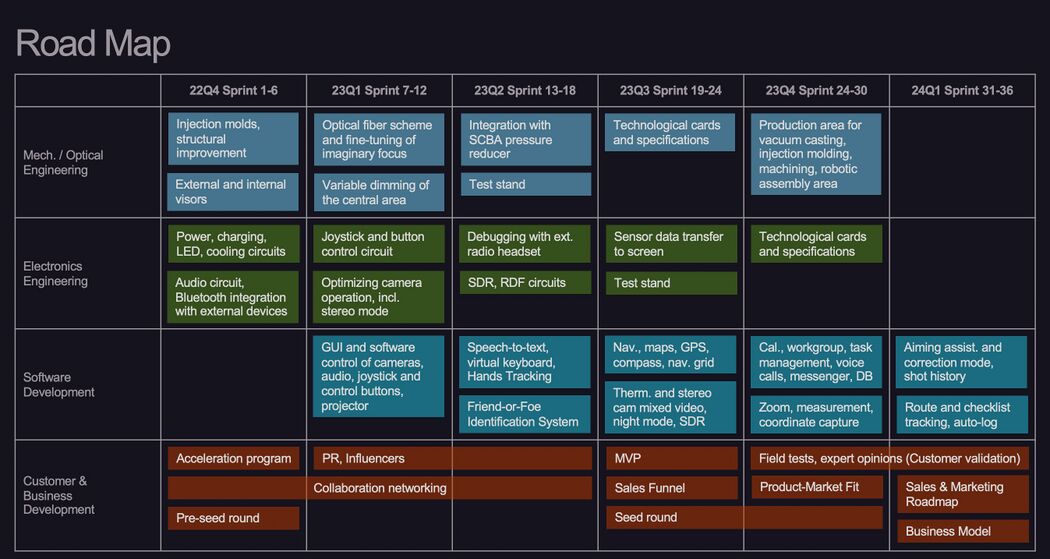
Team
Basil Boluk, Co-founder and CEO / CTO
Yes
In 2012, Tess and I met while training in aikido. Since then we have had several projects together. We've also each been building our own careers. But in 2020 we decided to join forces again in the ARHUDFM project.
Basil Boluk develops in our equipped lab CAD design, CAD optical schematics, 3D FDM / SLA printing, vacuum casting of prototype elements, vacuum casting and injection molding technology, mechanical engineering and CAM, electronic schematics and PCB prototypes, paint coating, and assembly technology. Along with this, Basil develops web resources and presentations, does research on user problems and technical solutions, researches patents and scientific publications, reviews competitors' product features, and writes articles for Wiki.furtherium.com and press releases for the media.
Tess Volkova researches software architecture and solutions for Computer Vision, perception, camera and sensor use. Tess develops architecture and code for embedded and high-level applications. Tess also prepares ideas and proposals for the architecture of future software solutions using self-learning neural networks (reinforcement learning) and Machine Learning.
Together we consult on related issues, discuss strategic and tactical tasks, priorities, results of communications about the collaboration, and expert opinions. Together we participate in meetings with potential co-founders, investment analysts and partners, project managers in defense agencies and military-technical corporations.
Basil Boluk, Co-founder and CEO / CTO
studied Physics, Management, Marketing, CAD & Mechanical Engineering, Electronics Engineering, 2D/3D Design. He has experience in entrepreneurship, including the construction of new production lines and renovation of old production facilities in the following areas: chemical and pharmaceutical, metalworking and construction materials, porcelain and glass, industrial electrical equipment and automation, software development, cloud and web services.
Tess Volkova, Co-Founder and VP Software Development
studied Computer Science, Radio Engineering, Machine Learning, Robotics, and Autonomy. He has experience in developing highly performance software, optimizing and porting it to embedded devices, audio processing, Computer Vision and Machine Learning algorithms, Robotics, autonomous driving, and simulation projects. She has work experience in Synopsis, Fraunhofer Institute, BMW.
We are now in negotiations with two individuals who are interested in joining the Сo-founders and taking on the roles of officers:
- Co-Founder and VP Product Dev.
- Co-Founder and VP R&D, Business Dev.
We are both passionate about the same ideas and the same technologies to implement them. We have a great understanding and mutual support.
IMHO we see problem-solving differently when it comes to detailed user experience, software algorithms, technology, and electronic components. Many corporations write about their experience in decades. This is not an advantage, but a disadvantage. They are captive to their stereotypes and try to copy each other. While technology updates its stack every 3-5 years.
Often inventions come to mind while relaxing or playing sports outdoors. You just have to remember to write ideas down in your notebook right away. It takes much more time to structure and describe ideas correctly afterwards. And it also takes even more time to research the novelty of an idea in relation to existing patents. For most ideas, though, this is not required. They most likely do not fall under the category of one whole invention formula, but rather its elements or the know-how of a specific technological or business process.
In the next 3 years, we are not planning a relocation and will focus on developing the project near Munich. Later on, however, some of us will be needed in the United States to promote the project and launch a second production facility in one of the states.
We will find funding elsewhere.
People stick together because of common interests and personal empathy, which is based on the ability not to bring controversial situations into conflict, on respect for each other's rights, on responsibility for each other's commitments. We've known each other for more than 10 years, that matters.
Team Experience
We have worked together on several projects in previous years:
- "Aloemart" online pharmacy Rx/OTC 25,000+ medications and related hygiene products, and a network of autonomous robotic 24/7 outposts for QR code order dispensing, plus customer engagement marketing programs and a great resource of expert content from practitioners.
- "My cow" online farm crowdsourcing platform connecting tens of thousands of consumers and hundreds of organic farms. The opportunity to jointly own a share in a real cow, a bee hive, other animals, and a vegetable vertical farm.
- "NCC.green" online augmented reality project for the residential real estate market, which in the format of an online store offers to choose and evaluate from the inside a future apartment under construction, arrange for a long-term lease, and purchase it through leasing, credit or cash. Complementary online services for interior design, built-in furniture, pet walking, etc.
- Online virtual or remote fitness trainer project "Sculptors" (a few years before Peloton) with a wide range of fitness and other sports activities individually with a trainer and in small groups of up to 6 people.
We were prepared for the fact that some past projects were ahead of their time. Now we see a lot of similar projects that copy each other. However, we are now focusing on deeply understood consumer problems that do not yet have a perfect product, despite the technical and financial availability. Previous experience helps us build a more effective long-term strategy and find unique solutions.
It's happening right now. Previously, we considered the secret military laboratories and departments of defense agencies responsible for strategic planning inaccessible. However, in July 2022, we were invited to a conference at the Planungsamt der Bundeswehr to give a presentation on challenges and solutions for Cross-Domain Interaction. Now we are preparing for another event for the Israel military. We see and feel that what we are doing is necessary for people to make the world safer.
We have found a technically affordable and cost-effective solution for preventing and fighting large wildfires. This project is waiting in the wings. We are sure that its time will come in 2-3 years. In the meantime, the conservative opinion of the majority does not allow us to move forward.
List of other projects (products) and problems:
Unmanned Stealth Armored Multipurpose Wheeled Vehicle (USAMWV)
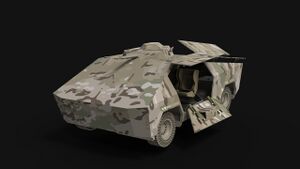
have excellent survivability, excellent maneuverability, an unmanned or remote or manual control, auto coordination in a convoy, four independent electric drives, long-range, airless thermal resistant tires, a high modified
ground clearance, fast seakeeping, and unique side, and rear door opening system with wide aisles, and a large capacity.
Problem
An elimination of disadvantages of existing and new models of wheeled armored vehicles. The completely redesigned concept using new technologies and materials.
Prospective market size (2025)
>$15 BN
Сompetitive environment and chance to occupy a market niche
Middle: 5 out of 10
R&D duration
24 months
Need for investment (3 rounds)
$60 M
Intelligence Surveillance Reconnaissance Airship Drone Radio Relay (ISRADRR)
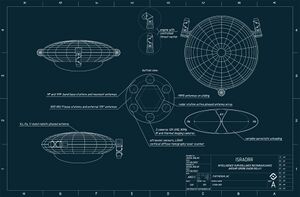
is the unmanned aerial vehicle up to an altitude of 5,500 m, up to 20 days of flight operation, providing line-of-sight radio signals (Wi-Fi, HF, VHF), real-time imaging, Computer Vision, radar detection, and a target designation station with active phase antenna, LiDAR, and ultrasonic sensors, a confocal diffuse tomography through clouds.
Problem
An alternative to drones with a short airborne time and an insufficient payload, a solving the problem of low visibility and high maneuverability while reducing power usage.
Prospective market size (2025)
>$27 BN
Сompetitive environment and chance to occupy a market niche
Upper middle: 6 out of 10
R&D duration
18 months
Need for investment (3 rounds)
$25 M
Fast Sailing Trimaran with Hydrofoils and Unmanned Control (FSTHUC)
features an automatic sail control system, two 360° electric waterjet propulsors, a diesel-electric power generation, robotic hydrofoils, an unmanned or remote or manual control, up to 80 knots cruising, advanced hydrodynamics, and aerodynamics, an intelligent security system.
Problem
Instead of outdated manual rope systems, disruptive possibilities for comfortable, safe, and robotic yachting for fast, long-distance crossings, even by oneself.
Prospective market size (2025)
>$15 BN
Сompetitive environment and chance to occupy a market niche
High: 7 out of 10
R&D duration
18 months
Need for investment (3 rounds)
$25 M
Remotely Operated Underwater Observation Drone (ROUOD)
equipped with a wireless control system, two 4K cameras, a sonar, an ultrasonic distance sensor, and a laser scanner, can operate fully autonomously, uses a mobile buoy as a base station, up to 300 m diving depth, and up to 5 days of operation. Research, reconnaissance, and scouting tasks.
Problem
An alternative to expensive or underperforming analogs for civilian industrial and private applications.
Prospective market size (2025)
>$3 BN
Сompetitive environment and chance to occupy a market niche
Upper middle: 6 out of 10
R&D duration
18 months
Need for investment (3 rounds)
$15 M
Unmanned Airships Chain for Wildfire Splinker System (UACWSS)
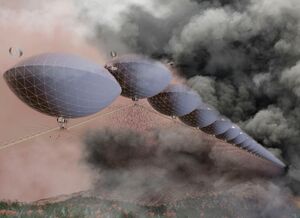
is a chain of aerostatically unloaded, heavy-duty unmanned airships connected to ground-based mobile high-voltage grid power and fire hoses. The system is capable of irrigating up to 30 acres in a swath over 160 feet at a time with the intensity of heavy rain.
Problem
Fighting large wildfires especially in conditions of difficult terrain, accessibility, and strong winds, as well as a preventive moistening for protection of the building area.
Prospective market size (2025)
>$5 BN
Сompetitive environment and chance to occupy a market niche
Very high: 9 out of 10
R&D duration
24 months
Need for investment (3 rounds)
$60 M
We meet understanding and interest in the ARHUDFM project. We have several suggestions to continue the dialogue and to provide MVPs for laboratory tests and field trials at a military proving ground. However, we are under no illusions to enter into direct contracts with the U.S. Department of Defense, German Bundeswehr and other countries with some exceptions. Although we have the necessary accreditation and authority to enter into direct contracts. We also receive regular listings of contract requests from agencies and military-technical corporations. As a priority to promote our product, we see a collaboration with a major military-technical corporation that has a long history of direct contracts with the military.
We foresee the possibility of not introducing the product quickly enough after the successful completion of field trials. Although we hope to award a large contract immediately thereafter, which will provide a good growth rate for our production and development of the next iterations of the product. We hedge against this risk by the fact that we are and will be negotiating simultaneously with defense agencies and corporations in several countries. And beyond that, we have very promising civilian applications for firefighters, rescue workers, police, state and private security, emergency medicine, surgeons and dentists.
Very often interesting creative ideas come to mind when I'm in the shower. At that moment it is important for me to run to one of the gadgets first thing afterward to record the ideas. There are even several of them at the same time. I get frustrated when I don't have time to record everything exactly. Unfortunately, ideas are fleeting. I don't complain about my memory, though.
We found several elegant solutions to such problems:
- How to provide the necessary cooling for electronic components inside the sealed housing of a wearable device?
- How to abandon portable handheld radios?
- How to create a system of silent instantaneous digital symbolic visual communication?
- How to solve the problem of big computations for complex neural network problems when communication channels with servers are not available?
- How to build a drinking system into a sealed mask and use it without using your hands?
- How to match the sighting line from the scope and reticle view from the mask with high accuracy and without interfering with artifacts?
- How to create such an air filtration system so that it is easy to breathe even under heavy loads?
- How to create an inexpensive and fail-safe system of body life sensors?
- How to use an ambient sound filter to recognize threats and determine the direction of your eye view for visual search with zooming?
We are of the opinion that as long as a situation or task can be corrected, it is not a mistake. Therefore, we can say that we have had enough positive and negative experiences in the past, but no mistakes. The Japanese say, if one does not have a serious negative experience, then one should have given up a lot in trying to get one. Some also say about projects that have been a resounding success, that there's nothing to learn there because it's a "survivor's mistake". We build relationships and our project on a foundation of knowledge of the mistakes of tens and hundreds of thousands of startups that didn't manage to pass it through the "valley of death". We believe that our steps are reasonably brave and reasonably cautious in trying to find a "success formula".
We have already mentioned the problem of knowledge and idea management. We are experienced researchers and our entire professional lives are connected to the study of scientific methods, practical cases, and new technologies. We could say that we have been in an intensive learning process continuously for decades. Our areas of knowledge and skills extend far beyond the boundaries of a university course.
In addition, we are used to digitizing everything that may come in handy in the future. Terabytes of information in multiple clouds, dozens of accounts, CRM systems, task management, whiteboards, mental maps, charts, sketches, graphic files, presentations, document texts, electronic tables, notes in notebooks, bookmarks with references, saved links to articles and publications, saved links to patents and research, records of settings and lab test protocols. But over time, this becomes very difficult to manage. There isn't yet any single secure repository where this can be combined. Except for Wikipedia.
Yes, there is. We've come to that recently. All the knowledge of the world can be combined in one place, even though it is stored in different places. The linking text is a text that, in the form of annotations and explanations, allows you not only to quickly share with others but also to return to a given topic yourself, even years later.
Also noteworthy is the ability to have a separate discussion (talk) page for each topic page. And even when the discussion is over, that information is saved for the future. People spend sometimes 20% and sometimes 70% of their time on meetings. Few create meeting agendas and take minutes, few save the minutes of the discussions in a form that can be referred to afterward.
What you are reading is part of our Wiki. In the same format and with the same functionality as the larger Wikipedia. We are very happy to have addressed this experience. Right organization and decentralized categories make it possible to manage gigantic amounts of intellectual assets and find what you need quickly.
This summer I was learning how to drive a motorcycle. I am a driver with a lot of experience, having driven cars of different classes and sizes, with large trailers and in difficult climatic, off-road, and extreme conditions. My instructor is a very active and positive person, ten years older than me. He knew about my previous experience and treated me without condescension as if I had been driving a motorcycle all my life. But that's a whole different skill set. Because of the physical attributes of a motorcycle, you have a lot less time to make decisions. The instructor and the student have only one-way communication, the instructor says, you do, but you can't respond. Unlike a car, the instructor can't push the pedals for you. In Germany, there are no speed limits on many parts of the freeways.
There have been quite a few funny cases. For example, when I think I'm already going fast enough in windy weather at over 120 miles, but the instructor tells me in the earpiece that I'm picking up traffic and have to shift to the right lane. Or when, after turning, I hear him tell me to wait by the sideline because he's on a car that hasn't had time to turn yet.
During my training, I learned that there is sign language for motorcyclists and it became very useful to establish two-way communication with the instructor. This situation led me to the following idea.
Tactical Special Forces and police officers, due to limitations, cannot communicate by voice during an operational task. They use sign language. However, these gestures cannot always be well recognized at the end of a column, much less by other groups who do not have eye contact. In the ARHUDFM project, we provided voice and text communication functions. We also decided to add symbolic communication as an analog of sign language. And to use symbols similar to some road signs, the meaning of which is clear even after a moment's display.
It is interesting that such symbolic language is convenient and often used by ordinary people in messengers and tweets. These are icons. Military and police officers are the same people and it is common for them to communicate in this way. So why not transfer this experience to the professional sphere of communication? This is what unusual transformations occur with ideas.
This post of Marc Andreessen is all about the only thing that matters for a new startup.
- When a great team meets a lousy market, market wins.
- When a lousy team meets a great market, market wins.
- When a great team meets a great market, something special happens.
You can obviously screw up a great market—and that has been done, and not infrequently—but assuming the team is baseline competent and the product is fundamentally acceptable, a great market will tend to equal success and a poor market will tend to equal failure. Market matters most. And neither a stellar team nor a fantastic product will redeem a bad market.
Product-market fit means being in a good market with a product that can satisfy that market. You can always feel when product-market fit isn’t happening. The customers aren’t quite getting value out of the product, word of mouth isn’t spreading, usage isn’t growing that fast, press reviews are kind of “blah”, the sales cycle takes too long, and lots of deals never close. And you can always feel product-market fit when it’s happening. The customers are buying the product just as fast as you can make it.
Do whatever is required to get to product-market fit. Including changing out people, rewriting your product, moving into a different market, telling customers no when you don’t want to, telling customers yes when you don’t want to, raising that fourth round of highly dilutive venture capital—whatever is required.
Timing
The existence of problems and strategic capabilities is not disputed by anyone. On the contrary, there are many conference and seminar materials, as well as articles by active and retired officers and security experts in the public domain. So the reasons for the lag in the solution to the problem lie in the field of science and technology. I would highlight several areas of technology, the level of which has only now caught up with the possibility of application in wearable devices:
- Computing capabilities of single board computers and systems on module
- Picoprojectors form factor
- Optical capabilities and advances in compact cameras and other sensors
- Algorithms, developed frameworks, and other tools for neural network deployment, Computer Vision
- Smaller and lighter electronic components with better performance than a few years ago
I would highlight one more reason. It seems to many technology companies and startups that the defense technology area is divided among several dozen large military-technical corporations and that the close relations of these corporations with officials make it impossible to even think about winning the competition. The corporations themselves never tire of demonstrating the capabilities of their budgets and the number of engineers.
However, and this is confirmed by a lot of examples from other industries, large corporations are not capable of disruptive solutions. At best, they improve on what they themselves did years ago or their similarly large competitors. The principles of work inside the company, internal communications, and employee motivation are the reasons for this. Large corporations are more likely to buy a promising startup with a ready-made solution than to make one themselves. We have seen this many times while working on a project and doing research.
Additionally, large corporations are in constant competition with each other for large DoD contracts. So collaborating with them is a stepping stone to the goal. Their resource in Business Development and personal relationships with decision-makers should not be underestimated. While there are many programs to access contracts from small and medium-sized businesses, in a collaboration with large corporations, the path will be faster.
Highlights in detail
- Problems and strategic capabilities
- Target audience
- Market
- Product characteristics and features
- Major product milestones
- Stages of product evolution
- Lifetime value
- Comparison with nearest competitors
- Competitive advantages
- Hardware unit economy
- Estimated budget for the first year after R&D
- Team
- Road Map
- Financial Ask and Use of Funds
- Experience investing in defense startups
See also
| Public External Sections: | Public Wiki Sections: | Public Wiki Sections: | Not-Public Wiki Sections: |
|---|---|---|---|
Note: Unless otherwise stated, whenever the masculine gender is used, both men and women are included.
See also product details
| Hardware Details: | Functional Apps Details: | Executive Apps Details: | Service Apps Details: |
|---|---|---|---|
References
- ↑ Josh Wolfe, "The rise of defense tech is bringing Silicon Valley back to its roots", TechCrunch, (Yahoo Inc., 1770 Broadway, New York, NY 10003, February 5, 2022)
- ↑ "NATO launches Innovation Fund", NATO, (NATO, Boulevard Léopold III, B-1110 Haren, City of Brussels, Belgium, June 30, 2022)
- ↑ "Ausschüsse segnen Wirtschaftsplan zum Sondervermögen ab", ES&T, (Mittler Report Verlag GmbH, Beethovenallee 21, D-53173 Bonn, June 02, 2022)
- ↑ "NATO sharpens technological edge with innovation initiatives", NATO, (NATO, Boulevard Léopold III, B-1110 Haren, City of Brussels, Belgium, April 7, 2022)
- ↑ Grant Hume and Rich Julien, "AWS launches first Defence Accelerator for startups", AWS, (Amazon Web Services, 410 Terry Avenue North, Seattle, WA 98109-5210, U.S.A., May 26, 2022)
- ↑ "5 Top Military Technology Startups to Watch in 2022", StartUs Insight (StartUs GmbH, Mariahilfer Straße 136, 1150 Vienna, Austria, 2022)
- ↑ "Top 10 Military Technology Trends & Innovations for 2022", StartUs Insight (StartUs GmbH, Mariahilfer Straße 136, 1150 Vienna, Austria, 2022)
- ↑ "Military Tech Startups in the United Kingdom", Tracxn, (Tracxn Technologies Limited, 2nd Floor, opp to Canara Bank, L248, 17th Cross Road, above Gazannia Fashions, Sector 6, HSR Layout, Bangalore, Karnataka 560102, India, September 20, 2022)
- ↑ Sanjay Deshpande, Managing Partner & Chief Scientist, "Top 10 Defence Startups - 2022", Industry Outlook Startups, (Biz Print Media Technologies Private Limited, 124, 2nd floor, South Block, Surya Chambers Old Airport Main Road, Murugeshpalya, Bangalore, 560017, September 2022)
- ↑ Second Lieutenant Jeremiah Rozman, U.S. Army, PhD, "The synthetic training environment", "AUSA", (Arlington, VA: Association of the United States Army - AUSA, December 10, 2020)
- ↑ Joe Lacdan, "Army testing synthetic training environment platforms", "army.mil", (6000 Defense Pentagon Washington, D.C. 20301-6000: Office of the Department of Defense, Chief Information Officer - U.S. DoD, October 8, 2019)
- ↑ Leonardo DRS Electro-Optical Infrared Systems, "Family of Weapon Sights - Individual (FWS-I)", leonardodrs.com (Leonardo DRS, Inc., 100 North Babcock Street, Melbourne, FL 32935; 13544 North Central Expressway, Dallas, TX 75243; September 2021)
- ↑ BAE Systems, ENVG III/ FWS-I night vision mobility and targeting system, baesystems.com, (BAE Systems, Inc., P.O. Box 868, Nashua, New Hampshire 03061-0868; Austin, TX; 2016)
- ↑ Tom Warren and Sean Hollister, "Microsoft is supplying 120,000 HoloLens-based headsets to the US Army", "The Verge", (Vox Media Inc., 1201 Connecticut Ave. NW, 11th Floor, Washington, DC 20036, March 31, 2021)
- ↑ Joseph Trevithick, "Army Makes Gargantuan Bet On New Augmented Reality Goggles For Its Soldiers", "The Drive", (Recurrent Ventures Inc., 701 Brickell Ave, Suite 1550, Miami, FL 33131, April 4, 2021)
- ↑ Breaking Defense, Army open to replacing Microsoft as prime under ‘IVAS Next,’ industry sources say (Aug 15, 2024)
- ↑ 17.0 17.1 Ashley Roque, "Pentagon budget 2023: Army banking on IVAS, cuts night vision programs", "Janes", (Jane's Group UK Limited, 69 Park Lane, Croydon, England, CR0 1JD, March 22, 2022)
- ↑ Anthony Capaccio, "Microsoft Combat Goggles Win First US Army Approval for Delivery", Bloomberg, (Bloomberg L.P., 731 Lexington Avenue, New York, NY, 10022, September 1, 2022)
- ↑ Lisa J. Yamakawa, Point of Contact (POC), Army Contracting Command - Aberdeen Proving Grounds (ACC-APG), "Announcement W91CRB-18-R-0023 constitutes a Request for Information (RFI) for the Enhanced Night Vision Goggle - Binocular (ENVG-B).", Sam.gov, (The System for Award Management, GSA Headquarters, 1800 F St NW, Washington, D.C., 20405, January 30, 2018)
- ↑ Night Vision Specifications (2021 UPDATE)
- ↑ Raanan Horowitz, President, and CEO of Elbit Systems of America, "Elbit Systems’ U.S. Subsidiary Awarded $41 Million Order as Part of the Night Vision Goggles IDIQ Contract for the U.S. Marine Corps", Media Press Release of Elbit Systems (Elbit Systems Ltd., Advanced Technology Center, P.O.B 539, Haifa 3100401, Israel, April 24, 2021)
- ↑ Raanan Horowitz, President, and CEO of Elbit Systems of America, "Elbit Systems of America Awarded $49 Million Contract to Supply Night Vision Systems for the U.S. Marine Corps", Media Press Release of Elbit Systems (Elbit Systems Ltd., Advanced Technology Center, P.O.B 539, Haifa 3100401, Israel, May 16, 2022)
- ↑ Ed McGregor, Director of Investor Relations, Vuzix Corporation, "Vuzix Enters into an Agreement with L3Harris Technologies to Develop a New Customized Waveguide-based HMD System", CISION PR Newswire, (PR Newswire Association LLC, 200 Vesey Street, 19th Floor, New York, New York 10281, August 02, 2022)
- ↑ Smartshooter Website
- ↑ Wikipedia, SMASH Handheld
- ↑ The Israeli inventor who turns every soldier into a sharpshooter
- ↑ MILIPOL: SMARTSHOOTER to Showcase Combat-Proven SMASH Fire Control Systems
- ↑ The IDF’s New SMASH Sight Is Changing the Face of the Modern Battlefield
- ↑ YouTube, SMASH 3000 with real-time shot release for ground and CUAS applications
- ↑ Saminna van den Bulk, "Smart Shooter helpt bij luchtdreiging", Kiosk, (The Netherlands Ministry of Defence, PO Box 20701, 2500 ES Den Haag, February 22, 2022)
- ↑ Sam Sprigg, "Red 6 receives investment from Lockheed Martin Ventures to further develop its Airborne Tactical Augmented Reality System for fighter pilot training", Auganix (Auganix Ltd., 71-75 Shelton Street London, Greater London WC2H 9JQ, U.K., June 19, 2020)
The appearance of U.S. Department of Defence (DoD) visual information does not imply or constitute DoD endorsement.
